NIH Institutes, Centers, and Offices Workforce Demographics
In pursuing the advancement of equity within the NIH workforce, we know that the journey begins with transparency. The ongoing analysis of workforce data allows us to tell the story of the people here at NIH who work to advance biomedical research. The Institute, Center, and Office (ICO) workforce profiles below describe the demographic composition of each ICO’s workforce and can be utilized to investigate potential disparities which may present barriers to equity in employment opportunities. For accessibility and visualization purposes, graphics may not be to scale.
NIH Institutes, Centers, and Offices
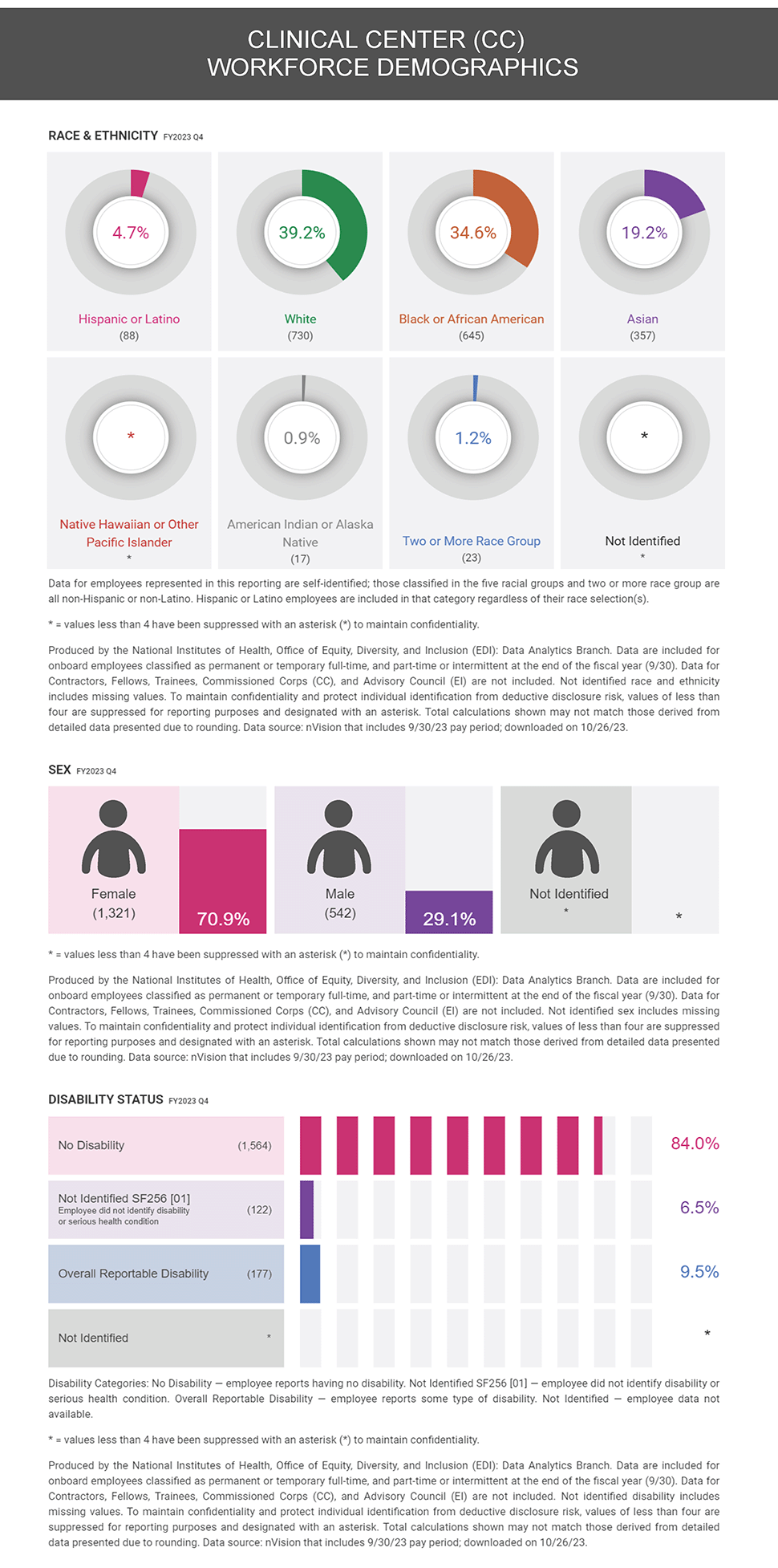
National Institutes of Health Clinical Center Workforce Demographics
RACE & ETHNICITY: Workforce Demographics by Race and Ethnicity. Graphic showing the proportions of Hispanic or Latino, White, Black or African American, Asian, Native Hawaiian or Other Pacific Islander, American Indian or Alaska Native, Two or More Race Group, and Not Identified NIH employees for Fiscal Year 2023 Fourth Quarter.
RACE & ETHNICITY: Hispanic or Latino = 88, 4.7%; White = 730, 39.2%; Black or African American = 645, 34.6%; Asian = 357, 19.2%; Native Hawaiian or Other Pacific Islander = *, *%; American Indian or Alaska Native = 17, 0.9%; Two or More Race Group = 23, 1.2%; Not Identified = *, *%
RACE & ETHNICITY: Data for employees represented in this reporting are self-identified; those classified in the five racial groups and two or more race group are all non-Hispanic or non-Latino. Hispanic or Latino employees are included in that category regardless of their race selection(s).
RACE & ETHNICITY: * = values less than 4 have been suppressed with an asterisk (*) to maintain confidentiality.
RACE & ETHNICITY: Produced by the National Institutes of Health, Office of Equity, Diversity, and Inclusion (EDI): Data Analytics Branch. Data are included for onboard employees classified as permanent or temporary full-time, and part-time or intermittent at the end of the fiscal year (9/30). Data for Contractors, Fellows, Trainees, Commissioned Corps (CC), and Advisory Council (EI) are not included. Not identified race and ethnicity includes missing values. To maintain confidentiality and protect individual identification from deductive disclosure risk, values of less than four are suppressed for reporting purposes and designated with an asterisk. Total calculations shown may not match those derived from detailed data presented due to rounding. Data source: nVision that includes 9/30/23 pay period; downloaded on 10/26/23.
SEX: Workforce Demographics by Sex. Graphic showing the proportions of Female, Male, and Not Identified NIH employees for Fiscal Year 2023 Fourth Quarter.
SEX: FEMALE = 1321, 70.9%; MALE = 542, 29.1%; Not Identified = *, *%
SEX: * = values less than 4 have been suppressed with an asterisk (*) to maintain confidentiality.
SEX: Produced by the National Institutes of Health, Office of Equity, Diversity, and Inclusion (EDI): Data Analytics Branch. Data are included for onboard employees classified as permanent or temporary full-time, and part-time or intermittent at the end of the fiscal year (9/30). Data for Contractors, Fellows, Trainees, Commissioned Corps (CC), and Advisory Council (EI) are not included. Not identified sex includes missing values. To maintain confidentiality and protect individual identification from deductive disclosure risk, values of less than four are suppressed for reporting purposes and designated with an asterisk. Total calculations shown may not match those derived from detailed data presented due to rounding. Data source: nVision that includes 9/30/23 pay period; downloaded on 10/26/23.
DISABILITY: Workforce Demographics by Disability Status. Graphic showing the proportions of NIH employees having disability status as the following: No Disability, Not Identified SF256 [01] — Employee did not identify disability or serious health condition, Overall Reportable Disability, and Not Identified NIH employees for Fiscal Year 2023 Fourth Quarter.
DISABILITY: No Disability = 1564, 84.0%; Not Identified SF256 [01] — Employee did not identify disability or serious health condition = 122, 6.5%; Overall Reportable Disability = 177, 9.5%; Not Identified = *, *%
DISABILITY: Disability Categories: No Disability — employee reports having no disability. Not Identified SF256 [01] — employee did not identify disability or serious health condition. Overall Reportable Disability — employee reports some type of disability. Not Identified — employee data not available.
Produced by the National Institutes of Health, Office of Equity, Diversity, and Inclusion (EDI): Data Analytics Branch. Data are included for onboard employees classified as permanent or temporary full-time, and part-time or intermittent at the end of the fiscal year (9/30). Data for Contractors, Fellows, Trainees, Commissioned Corps (CC), and Advisory Council (EI) are not included. Not identified disability includes missing values. To maintain confidentiality and protect individual identification from deductive disclosure risk, values of less than four are suppressed for reporting purposes and designated with an asterisk. Total calculations shown may not match those derived from detailed data presented due to rounding. Data source: nVision that includes 9/30/23 pay period; downloaded on 10/26/23.
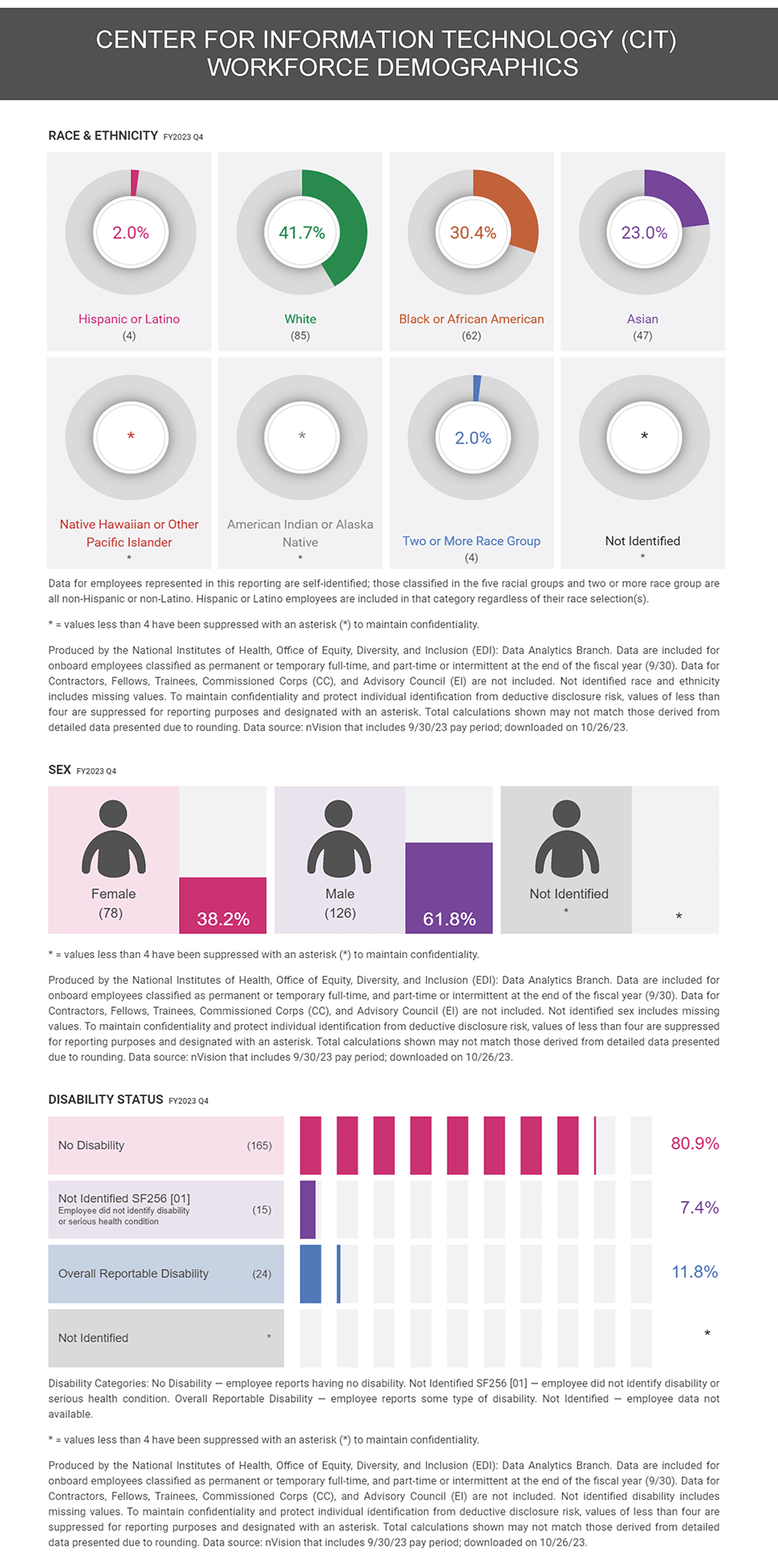
National Institutes of Health Center for Information Technology Workforce Demographics
RACE & ETHNICITY: Workforce Demographics by Race and Ethnicity. Graphic showing the proportions of Hispanic or Latino, White, Black or African American, Asian, Native Hawaiian or Other Pacific Islander, American Indian or Alaska Native, Two or More Race Group, and Not Identified NIH employees for Fiscal Year 2023 Fourth Quarter.
RACE & ETHNICITY: Hispanic or Latino = 4, 2.0%; White = 85, 41.7%; Black or African American = 62, 30.4%; Asian = 47, 23.0%; Native Hawaiian or Other Pacific Islander = *, *%; American Indian or Alaska Native = *, *%; Two or More Race Group = 4, 2.0%; Not Identified = *, *%
RACE & ETHNICITY: Data for employees represented in this reporting are self-identified; those classified in the five racial groups and two or more race group are all non-Hispanic or non-Latino. Hispanic or Latino employees are included in that category regardless of their race selection(s).
RACE & ETHNICITY: * = values less than 4 have been suppressed with an asterisk (*) to maintain confidentiality.
RACE & ETHNICITY: Produced by the National Institutes of Health, Office of Equity, Diversity, and Inclusion (EDI): Data Analytics Branch. Data are included for onboard employees classified as permanent or temporary full-time, and part-time or intermittent at the end of the fiscal year (9/30). Data for Contractors, Fellows, Trainees, Commissioned Corps (CC), and Advisory Council (EI) are not included. Not identified race and ethnicity includes missing values. To maintain confidentiality and protect individual identification from deductive disclosure risk, values of less than four are suppressed for reporting purposes and designated with an asterisk. Total calculations shown may not match those derived from detailed data presented due to rounding. Data source: nVision that includes 9/30/23 pay period; downloaded on 10/26/23.
SEX: Workforce Demographics by Sex. Graphic showing the proportions of Female, Male, and Not Identified NIH employees for Fiscal Year 2023 Fourth Quarter.
SEX: FEMALE = 78, 38.2%; MALE = 126, 61.8%; Not Identified = *, *%
SEX: * = values less than 4 have been suppressed with an asterisk (*) to maintain confidentiality.
SEX: Produced by the National Institutes of Health, Office of Equity, Diversity, and Inclusion (EDI): Data Analytics Branch. Data are included for onboard employees classified as permanent or temporary full-time, and part-time or intermittent at the end of the fiscal year (9/30). Data for Contractors, Fellows, Trainees, Commissioned Corps (CC), and Advisory Council (EI) are not included. Not identified sex includes missing values. To maintain confidentiality and protect individual identification from deductive disclosure risk, values of less than four are suppressed for reporting purposes and designated with an asterisk. Total calculations shown may not match those derived from detailed data presented due to rounding. Data source: nVision that includes 9/30/23 pay period; downloaded on 10/26/23.
DISABILITY: Workforce Demographics by Disability Status. Graphic showing the proportions of NIH employees having disability status as the following: No Disability, Not Identified SF256 [01] — Employee did not identify disability or serious health condition, Overall Reportable Disability, and Not Identified NIH employees for Fiscal Year 2023 Fourth Quarter.
DISABILITY: No Disability = 165, 80.9%; Not Identified SF256 [01] — Employee did not identify disability or serious health condition = 15, 7.4%; Overall Reportable Disability = 24, 11.8%; Not Identified = *, *%
DISABILITY: Disability Categories: No Disability — employee reports having no disability. Not Identified SF256 [01] — employee did not identify disability or serious health condition. Overall Reportable Disability — employee reports some type of disability. Not Identified — employee data not available.
Produced by the National Institutes of Health, Office of Equity, Diversity, and Inclusion (EDI): Data Analytics Branch. Data are included for onboard employees classified as permanent or temporary full-time, and part-time or intermittent at the end of the fiscal year (9/30). Data for Contractors, Fellows, Trainees, Commissioned Corps (CC), and Advisory Council (EI) are not included. Not identified disability includes missing values. To maintain confidentiality and protect individual identification from deductive disclosure risk, values of less than four are suppressed for reporting purposes and designated with an asterisk. Total calculations shown may not match those derived from detailed data presented due to rounding. Data source: nVision that includes 9/30/23 pay period; downloaded on 10/26/23.
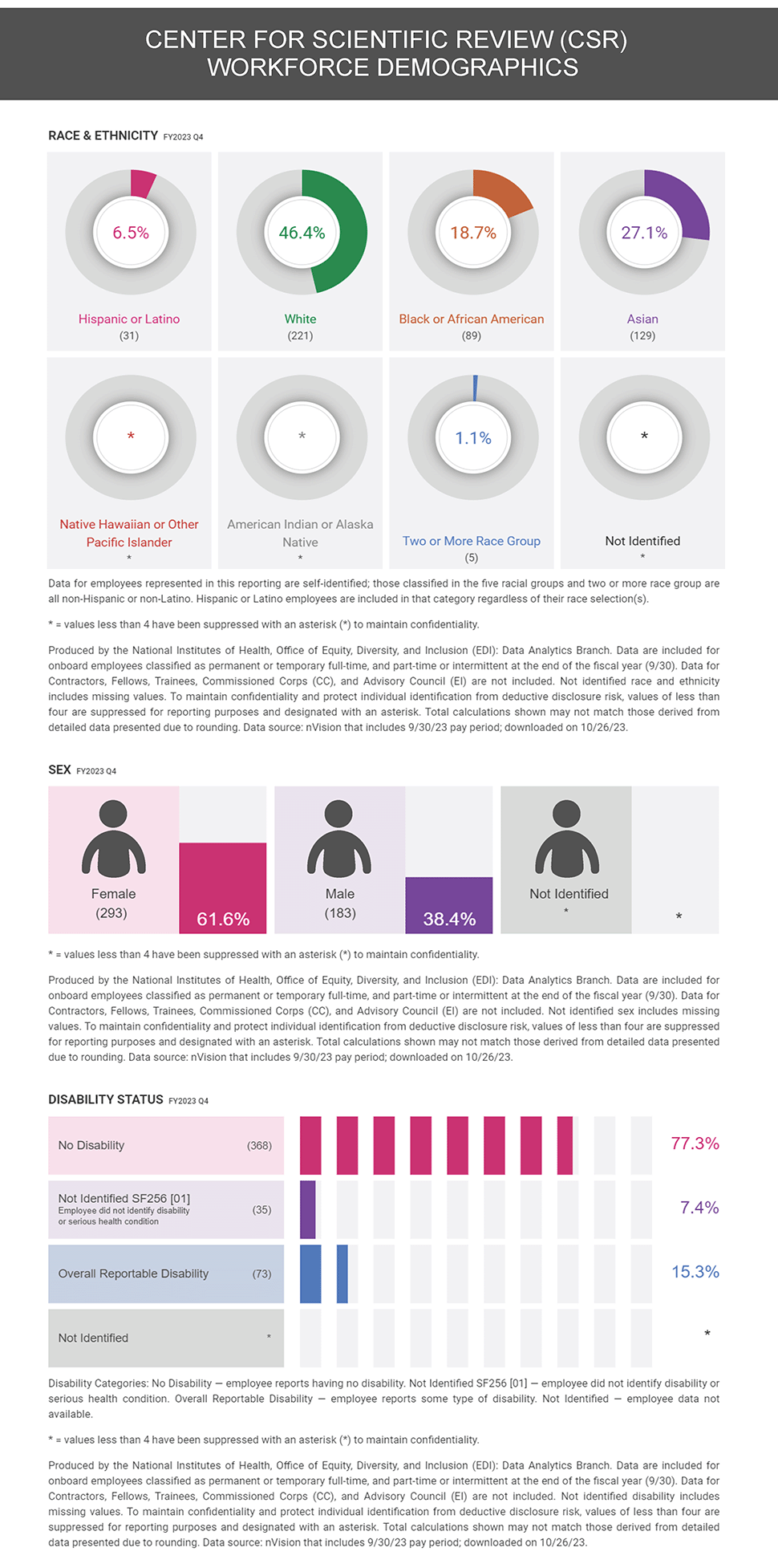
National Institutes of Health Center for Scientific Review Workforce Demographics
RACE & ETHNICITY: Workforce Demographics by Race and Ethnicity. Graphic showing the proportions of Hispanic or Latino, White, Black or African American, Asian, Native Hawaiian or Other Pacific Islander, American Indian or Alaska Native, Two or More Race Group, and Not Identified NIH employees for Fiscal Year 2023 Fourth Quarter.
RACE & ETHNICITY: Hispanic or Latino = 31, 6.5%; White = 221, 46.4%; Black or African American = 89, 18.7%; Asian = 129, 27.1%; Native Hawaiian or Other Pacific Islander = *, *%; American Indian or Alaska Native = *, *%; Two or More Race Group = 5, 1.1%; Not Identified = *, *%
RACE & ETHNICITY: Data for employees represented in this reporting are self-identified; those classified in the five racial groups and two or more race group are all non-Hispanic or non-Latino. Hispanic or Latino employees are included in that category regardless of their race selection(s).
RACE & ETHNICITY: * = values less than 4 have been suppressed with an asterisk (*) to maintain confidentiality.
RACE & ETHNICITY: Produced by the National Institutes of Health, Office of Equity, Diversity, and Inclusion (EDI): Data Analytics Branch. Data are included for onboard employees classified as permanent or temporary full-time, and part-time or intermittent at the end of the fiscal year (9/30). Data for Contractors, Fellows, Trainees, Commissioned Corps (CC), and Advisory Council (EI) are not included. Not identified race and ethnicity includes missing values. To maintain confidentiality and protect individual identification from deductive disclosure risk, values of less than four are suppressed for reporting purposes and designated with an asterisk. Total calculations shown may not match those derived from detailed data presented due to rounding. Data source: nVision that includes 9/30/23 pay period; downloaded on 10/26/23.
SEX: Workforce Demographics by Sex. Graphic showing the proportions of Female, Male, and Not Identified NIH employees for Fiscal Year 2023 Fourth Quarter.
SEX: FEMALE = 293, 61.6%; MALE = 183, 38.4%; Not Identified = *, *%
SEX: * = values less than 4 have been suppressed with an asterisk (*) to maintain confidentiality.
SEX: Produced by the National Institutes of Health, Office of Equity, Diversity, and Inclusion (EDI): Data Analytics Branch. Data are included for onboard employees classified as permanent or temporary full-time, and part-time or intermittent at the end of the fiscal year (9/30). Data for Contractors, Fellows, Trainees, Commissioned Corps (CC), and Advisory Council (EI) are not included. Not identified sex includes missing values. To maintain confidentiality and protect individual identification from deductive disclosure risk, values of less than four are suppressed for reporting purposes and designated with an asterisk. Total calculations shown may not match those derived from detailed data presented due to rounding. Data source: nVision that includes 9/30/23 pay period; downloaded on 10/26/23.
DISABILITY: Workforce Demographics by Disability Status. Graphic showing the proportions of NIH employees having disability status as the following: No Disability, Not Identified SF256 [01] — Employee did not identify disability or serious health condition, Overall Reportable Disability, and Not Identified NIH employees for Fiscal Year 2023 Fourth Quarter.
DISABILITY: No Disability = 368, 77.3%; Not Identified SF256 [01] — Employee did not identify disability or serious health condition = 35, 7.4%; Overall Reportable Disability = 73, 15.3%; Not Identified = *, *%
DISABILITY: Disability Categories: No Disability — employee reports having no disability. Not Identified SF256 [01] — employee did not identify disability or serious health condition. Overall Reportable Disability — employee reports some type of disability. Not Identified — employee data not available.
Produced by the National Institutes of Health, Office of Equity, Diversity, and Inclusion (EDI): Data Analytics Branch. Data are included for onboard employees classified as permanent or temporary full-time, and part-time or intermittent at the end of the fiscal year (9/30). Data for Contractors, Fellows, Trainees, Commissioned Corps (CC), and Advisory Council (EI) are not included. Not identified disability includes missing values. To maintain confidentiality and protect individual identification from deductive disclosure risk, values of less than four are suppressed for reporting purposes and designated with an asterisk. Total calculations shown may not match those derived from detailed data presented due to rounding. Data source: nVision that includes 9/30/23 pay period; downloaded on 10/26/23.
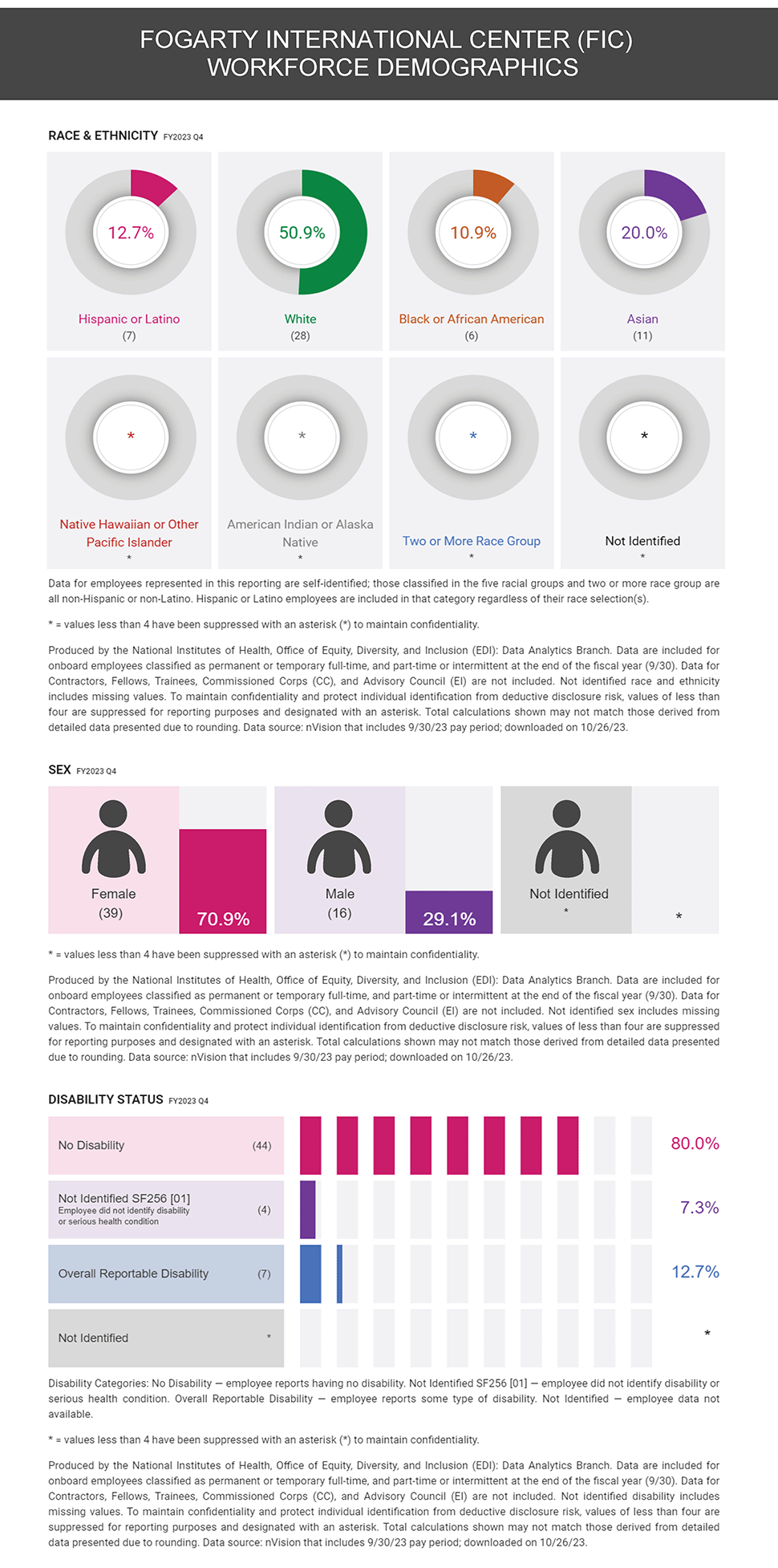
Fogarty International Center Workforce Demographics
RACE & ETHNICITY: Workforce Demographics by Race and Ethnicity. Graphic showing the proportions of Hispanic or Latino, White, Black or African American, Asian, Native Hawaiian or Other Pacific Islander, American Indian or Alaska Native, Two or More Race Group, and Not Identified NIH employees for Fiscal Year 2023 Fourth Quarter.
RACE & ETHNICITY: Hispanic or Latino = 7, 12.7%; White = 28, 50.9%; Black or African American = 6, 10.9%; Asian = 11, 20.0%; Native Hawaiian or Other Pacific Islander = *, *%; American Indian or Alaska Native = *, *%; Two or More Race Group = *, *%; Not Identified = *, *%
RACE & ETHNICITY: Data for employees represented in this reporting are self-identified; those classified in the five racial groups and two or more race group are all non-Hispanic or non-Latino. Hispanic or Latino employees are included in that category regardless of their race selection(s).
RACE & ETHNICITY: * = values less than 4 have been suppressed with an asterisk (*) to maintain confidentiality.
RACE & ETHNICITY: Produced by the National Institutes of Health, Office of Equity, Diversity, and Inclusion (EDI): Data Analytics Branch. Data are included for onboard employees classified as permanent or temporary full-time, and part-time or intermittent at the end of the fiscal year (9/30). Data for Contractors, Fellows, Trainees, Commissioned Corps (CC), and Advisory Council (EI) are not included. Not identified race and ethnicity includes missing values. To maintain confidentiality and protect individual identification from deductive disclosure risk, values of less than four are suppressed for reporting purposes and designated with an asterisk. Total calculations shown may not match those derived from detailed data presented due to rounding. Data source: nVision that includes 9/30/23 pay period; downloaded on 10/26/23.
SEX: Workforce Demographics by Sex. Graphic showing the proportions of Female, Male, and Not Identified NIH employees for Fiscal Year 2023 Fourth Quarter.
SEX: FEMALE = 39, 70.9%; MALE = 16, 29.1%; Not Identified = *, *%
SEX: * = values less than 4 have been suppressed with an asterisk (*) to maintain confidentiality.
SEX: Produced by the National Institutes of Health, Office of Equity, Diversity, and Inclusion (EDI): Data Analytics Branch. Data are included for onboard employees classified as permanent or temporary full-time, and part-time or intermittent at the end of the fiscal year (9/30). Data for Contractors, Fellows, Trainees, Commissioned Corps (CC), and Advisory Council (EI) are not included. Not identified sex includes missing values. To maintain confidentiality and protect individual identification from deductive disclosure risk, values of less than four are suppressed for reporting purposes and designated with an asterisk. Total calculations shown may not match those derived from detailed data presented due to rounding. Data source: nVision that includes 9/30/23 pay period; downloaded on 10/26/23.
DISABILITY: Workforce Demographics by Disability Status. Graphic showing the proportions of NIH employees having disability status as the following: No Disability, Not Identified SF256 [01] — Employee did not identify disability or serious health condition, Overall Reportable Disability, and Not Identified NIH employees for Fiscal Year 2023 Fourth Quarter.
DISABILITY: No Disability = 44, 80.0%; Not Identified SF256 [01] — Employee did not identify disability or serious health condition = 4, 7.3%; Overall Reportable Disability = 7, 12.7%; Not Identified = *, *%
DISABILITY: Disability Categories: No Disability — employee reports having no disability. Not Identified SF256 [01] — employee did not identify disability or serious health condition. Overall Reportable Disability — employee reports some type of disability. Not Identified — employee data not available.
Produced by the National Institutes of Health, Office of Equity, Diversity, and Inclusion (EDI): Data Analytics Branch. Data are included for onboard employees classified as permanent or temporary full-time, and part-time or intermittent at the end of the fiscal year (9/30). Data for Contractors, Fellows, Trainees, Commissioned Corps (CC), and Advisory Council (EI) are not included. Not identified disability includes missing values. To maintain confidentiality and protect individual identification from deductive disclosure risk, values of less than four are suppressed for reporting purposes and designated with an asterisk. Total calculations shown may not match those derived from detailed data presented due to rounding. Data source: nVision that includes 9/30/23 pay period; downloaded on 10/26/23.
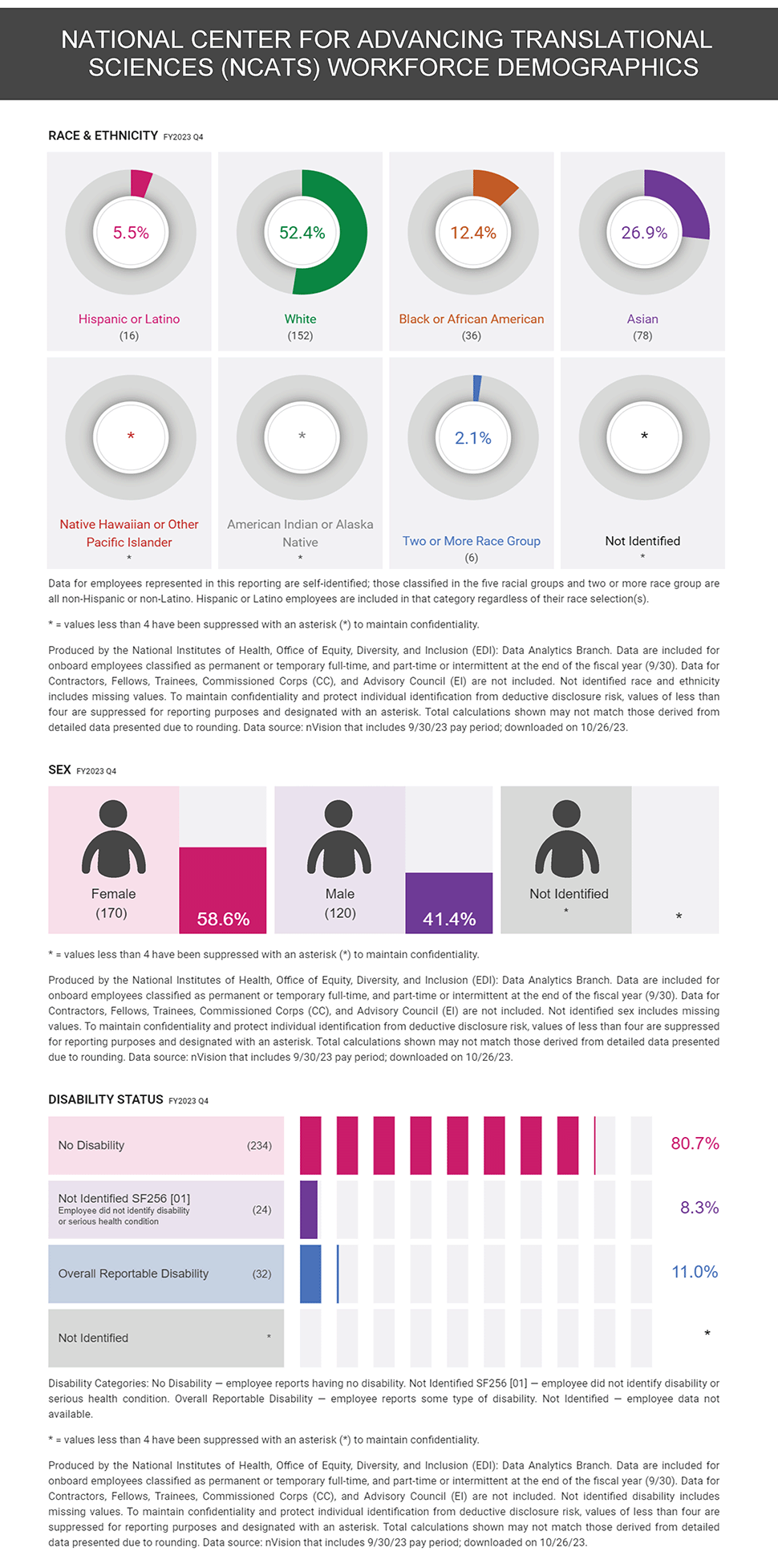
National Center for Advancing Translational Sciences Workforce Demographics
RACE & ETHNICITY: Workforce Demographics by Race and Ethnicity. Graphic showing the proportions of Hispanic or Latino, White, Black or African American, Asian, Native Hawaiian or Other Pacific Islander, American Indian or Alaska Native, Two or More Race Group, and Not Identified NIH employees for Fiscal Year 2023 Fourth Quarter.
RACE & ETHNICITY: Hispanic or Latino = 16, 5.5%; White = 152, 52.4%; Black or African American = 36, 12.4%; Asian = 78, 26.9%; Native Hawaiian or Other Pacific Islander = *, *%; American Indian or Alaska Native = *, *%; Two or More Race Group = 6, 2.1%; Not Identified = *, *%
RACE & ETHNICITY: Data for employees represented in this reporting are self-identified; those classified in the five racial groups and two or more race group are all non-Hispanic or non-Latino. Hispanic or Latino employees are included in that category regardless of their race selection(s).
RACE & ETHNICITY: * = values less than 4 have been suppressed with an asterisk (*) to maintain confidentiality.
RACE & ETHNICITY: Produced by the National Institutes of Health, Office of Equity, Diversity, and Inclusion (EDI): Data Analytics Branch. Data are included for onboard employees classified as permanent or temporary full-time, and part-time or intermittent at the end of the fiscal year (9/30). Data for Contractors, Fellows, Trainees, Commissioned Corps (CC), and Advisory Council (EI) are not included. Not identified race and ethnicity includes missing values. To maintain confidentiality and protect individual identification from deductive disclosure risk, values of less than four are suppressed for reporting purposes and designated with an asterisk. Total calculations shown may not match those derived from detailed data presented due to rounding. Data source: nVision that includes 9/30/23 pay period; downloaded on 10/26/23.
SEX: Workforce Demographics by Sex. Graphic showing the proportions of Female, Male, and Not Identified NIH employees for Fiscal Year 2023 Fourth Quarter.
SEX: FEMALE = 170, 58.6%; MALE = 120, 41.4%; Not Identified = *, *%
SEX: * = values less than 4 have been suppressed with an asterisk (*) to maintain confidentiality.
SEX: Produced by the National Institutes of Health, Office of Equity, Diversity, and Inclusion (EDI): Data Analytics Branch. Data are included for onboard employees classified as permanent or temporary full-time, and part-time or intermittent at the end of the fiscal year (9/30). Data for Contractors, Fellows, Trainees, Commissioned Corps (CC), and Advisory Council (EI) are not included. Not identified sex includes missing values. To maintain confidentiality and protect individual identification from deductive disclosure risk, values of less than four are suppressed for reporting purposes and designated with an asterisk. Total calculations shown may not match those derived from detailed data presented due to rounding. Data source: nVision that includes 9/30/23 pay period; downloaded on 10/26/23.
DISABILITY: Workforce Demographics by Disability Status. Graphic showing the proportions of NIH employees having disability status as the following: No Disability, Not Identified SF256 [01] — Employee did not identify disability or serious health condition, Overall Reportable Disability, and Not Identified NIH employees for Fiscal Year 2023 Fourth Quarter.
DISABILITY: No Disability = 234, 80.7%; Not Identified SF256 [01] — Employee did not identify disability or serious health condition = 24, 8.3%; Overall Reportable Disability = 32, 11.0%; Not Identified = *, *%
DISABILITY: Disability Categories: No Disability — employee reports having no disability. Not Identified SF256 [01] — employee did not identify disability or serious health condition. Overall Reportable Disability — employee reports some type of disability. Not Identified — employee data not available.
Produced by the National Institutes of Health, Office of Equity, Diversity, and Inclusion (EDI): Data Analytics Branch. Data are included for onboard employees classified as permanent or temporary full-time, and part-time or intermittent at the end of the fiscal year (9/30). Data for Contractors, Fellows, Trainees, Commissioned Corps (CC), and Advisory Council (EI) are not included. Not identified disability includes missing values. To maintain confidentiality and protect individual identification from deductive disclosure risk, values of less than four are suppressed for reporting purposes and designated with an asterisk. Total calculations shown may not match those derived from detailed data presented due to rounding. Data source: nVision that includes 9/30/23 pay period; downloaded on 10/26/23.
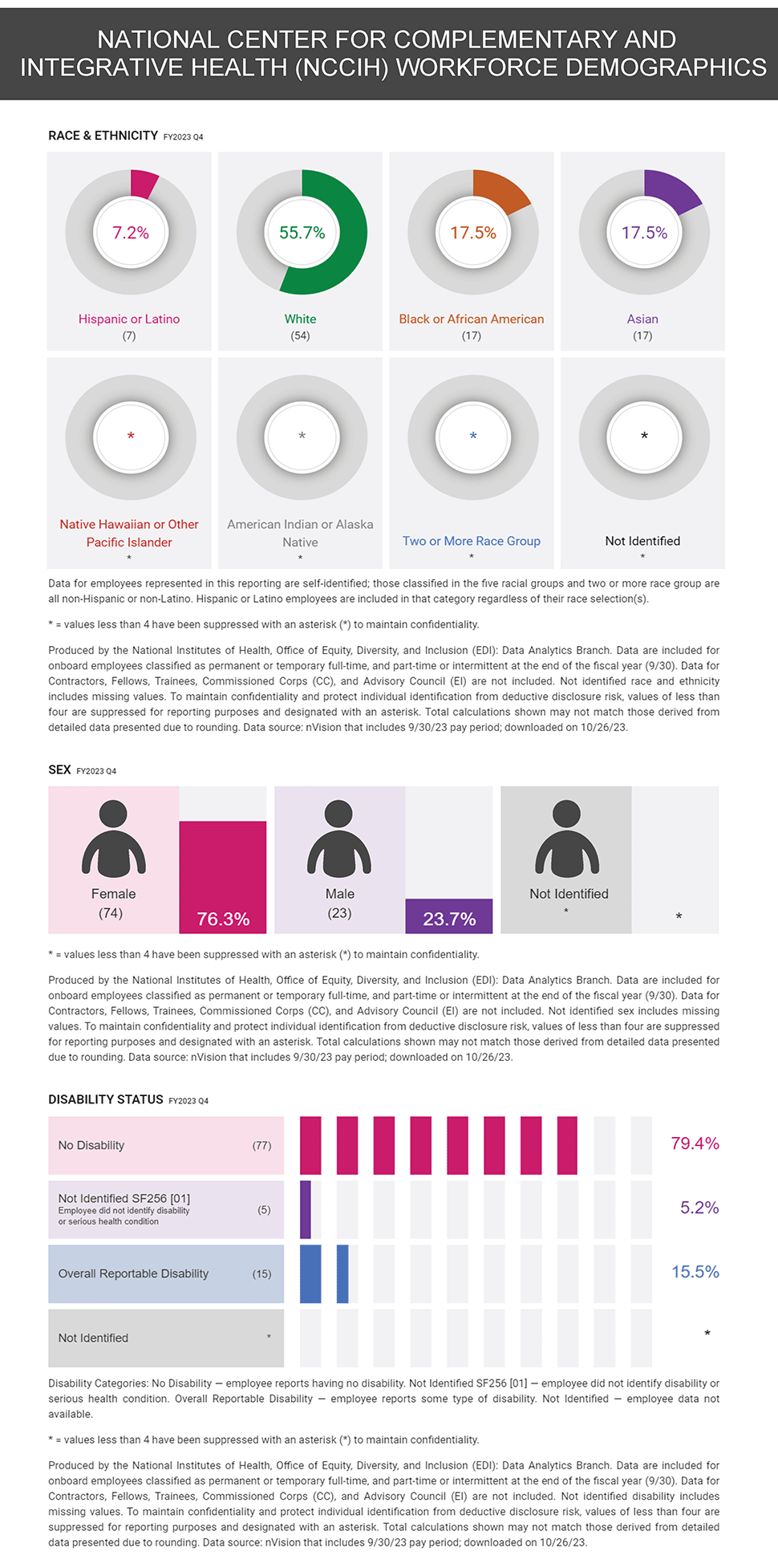
National Center for Complementary and Integrative Health Workforce Demographics
RACE & ETHNICITY: Workforce Demographics by Race and Ethnicity. Graphic showing the proportions of Hispanic or Latino, White, Black or African American, Asian, Native Hawaiian or Other Pacific Islander, American Indian or Alaska Native, Two or More Race Group, and Not Identified NIH employees for Fiscal Year 2023 Fourth Quarter.
RACE & ETHNICITY: Hispanic or Latino = 7, 7.2%; White = 54, 55.7%; Black or African American = 17, 17.5%; Asian = 17, 17.5%; Native Hawaiian or Other Pacific Islander = *, *%; American Indian or Alaska Native = *, *%; Two or More Race Group = *, *%; Not Identified = *, *%
RACE & ETHNICITY: Data for employees represented in this reporting are self-identified; those classified in the five racial groups and two or more race group are all non-Hispanic or non-Latino. Hispanic or Latino employees are included in that category regardless of their race selection(s).
RACE & ETHNICITY: * = values less than 4 have been suppressed with an asterisk (*) to maintain confidentiality.
RACE & ETHNICITY: Produced by the National Institutes of Health, Office of Equity, Diversity, and Inclusion (EDI): Data Analytics Branch. Data are included for onboard employees classified as permanent or temporary full-time, and part-time or intermittent at the end of the fiscal year (9/30). Data for Contractors, Fellows, Trainees, Commissioned Corps (CC), and Advisory Council (EI) are not included. Not identified race and ethnicity includes missing values. To maintain confidentiality and protect individual identification from deductive disclosure risk, values of less than four are suppressed for reporting purposes and designated with an asterisk. Total calculations shown may not match those derived from detailed data presented due to rounding. Data source: nVision that includes 9/30/23 pay period; downloaded on 10/26/23.
SEX: Workforce Demographics by Sex. Graphic showing the proportions of Female, Male, and Not Identified NIH employees for Fiscal Year 2023 Fourth Quarter.
SEX: FEMALE = 74, 76.3%; MALE = 23, 23.7%; Not Identified = *, *%
SEX: * = values less than 4 have been suppressed with an asterisk (*) to maintain confidentiality.
SEX: Produced by the National Institutes of Health, Office of Equity, Diversity, and Inclusion (EDI): Data Analytics Branch. Data are included for onboard employees classified as permanent or temporary full-time, and part-time or intermittent at the end of the fiscal year (9/30). Data for Contractors, Fellows, Trainees, Commissioned Corps (CC), and Advisory Council (EI) are not included. Not identified sex includes missing values. To maintain confidentiality and protect individual identification from deductive disclosure risk, values of less than four are suppressed for reporting purposes and designated with an asterisk. Total calculations shown may not match those derived from detailed data presented due to rounding. Data source: nVision that includes 9/30/23 pay period; downloaded on 10/26/23.
DISABILITY: Workforce Demographics by Disability Status. Graphic showing the proportions of NIH employees having disability status as the following: No Disability, Not Identified SF256 [01] — Employee did not identify disability or serious health condition, Overall Reportable Disability, and Not Identified NIH employees for Fiscal Year 2023 Fourth Quarter.
DISABILITY: No Disability = 77, 79.4%; Not Identified SF256 [01] — Employee did not identify disability or serious health condition = 5, 5.2%; Overall Reportable Disability = 15, 15.5%; Not Identified = *, *%
DISABILITY: Disability Categories: No Disability — employee reports having no disability. Not Identified SF256 [01] — employee did not identify disability or serious health condition. Overall Reportable Disability — employee reports some type of disability. Not Identified — employee data not available.
Produced by the National Institutes of Health, Office of Equity, Diversity, and Inclusion (EDI): Data Analytics Branch. Data are included for onboard employees classified as permanent or temporary full-time, and part-time or intermittent at the end of the fiscal year (9/30). Data for Contractors, Fellows, Trainees, Commissioned Corps (CC), and Advisory Council (EI) are not included. Not identified disability includes missing values. To maintain confidentiality and protect individual identification from deductive disclosure risk, values of less than four are suppressed for reporting purposes and designated with an asterisk. Total calculations shown may not match those derived from detailed data presented due to rounding. Data source: nVision that includes 9/30/23 pay period; downloaded on 10/26/23.
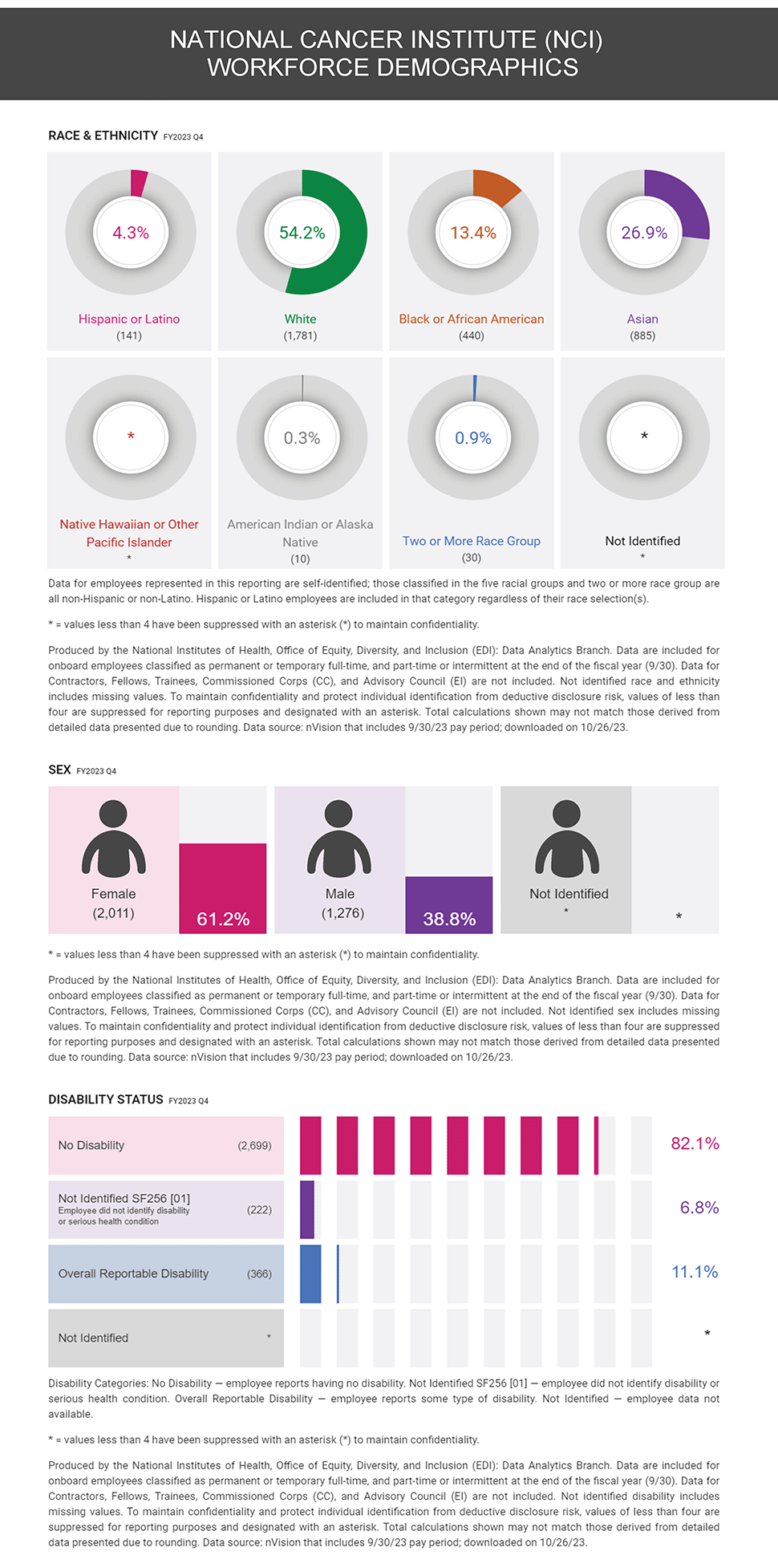
National Cancer Institute Workforce Demographics
RACE & ETHNICITY: Workforce Demographics by Race and Ethnicity. Graphic showing the proportions of Hispanic or Latino, White, Black or African American, Asian, Native Hawaiian or Other Pacific Islander, American Indian or Alaska Native, Two or More Race Group, and Not Identified NIH employees for Fiscal Year 2023 Fourth Quarter.
RACE & ETHNICITY: Hispanic or Latino = 141, 4.3%; White = 1781, 54.2%; Black or African American = 440, 13.4%; Asian = 885, 26.9%; Native Hawaiian or Other Pacific Islander = *, *%; American Indian or Alaska Native = 10, 0.3%; Two or More Race Group = 30, 0.9%; Not Identified = *, *%
RACE & ETHNICITY: Data for employees represented in this reporting are self-identified; those classified in the five racial groups and two or more race group are all non-Hispanic or non-Latino. Hispanic or Latino employees are included in that category regardless of their race selection(s).
RACE & ETHNICITY: * = values less than 4 have been suppressed with an asterisk (*) to maintain confidentiality.
RACE & ETHNICITY: Produced by the National Institutes of Health, Office of Equity, Diversity, and Inclusion (EDI): Data Analytics Branch. Data are included for onboard employees classified as permanent or temporary full-time, and part-time or intermittent at the end of the fiscal year (9/30). Data for Contractors, Fellows, Trainees, Commissioned Corps (CC), and Advisory Council (EI) are not included. Not identified race and ethnicity includes missing values. To maintain confidentiality and protect individual identification from deductive disclosure risk, values of less than four are suppressed for reporting purposes and designated with an asterisk. Total calculations shown may not match those derived from detailed data presented due to rounding. Data source: nVision that includes 9/30/23 pay period; downloaded on 10/26/23.
SEX: Workforce Demographics by Sex. Graphic showing the proportions of Female, Male, and Not Identified NIH employees for Fiscal Year 2023 Fourth Quarter.
SEX: FEMALE = 2011, 61.2%; MALE = 1276, 38.8%; Not Identified = *, *%
SEX: * = values less than 4 have been suppressed with an asterisk (*) to maintain confidentiality.
SEX: Produced by the National Institutes of Health, Office of Equity, Diversity, and Inclusion (EDI): Data Analytics Branch. Data are included for onboard employees classified as permanent or temporary full-time, and part-time or intermittent at the end of the fiscal year (9/30). Data for Contractors, Fellows, Trainees, Commissioned Corps (CC), and Advisory Council (EI) are not included. Not identified sex includes missing values. To maintain confidentiality and protect individual identification from deductive disclosure risk, values of less than four are suppressed for reporting purposes and designated with an asterisk. Total calculations shown may not match those derived from detailed data presented due to rounding. Data source: nVision that includes 9/30/23 pay period; downloaded on 10/26/23.
DISABILITY: Workforce Demographics by Disability Status. Graphic showing the proportions of NIH employees having disability status as the following: No Disability, Not Identified SF256 [01] — Employee did not identify disability or serious health condition, Overall Reportable Disability, and Not Identified NIH employees for Fiscal Year 2023 Fourth Quarter.
DISABILITY: No Disability = 2699, 82.1%; Not Identified SF256 [01] — Employee did not identify disability or serious health condition = 222, 6.8%; Overall Reportable Disability = 366, 11.1%; Not Identified = *, *%
DISABILITY: Disability Categories: No Disability — employee reports having no disability. Not Identified SF256 [01] — employee did not identify disability or serious health condition. Overall Reportable Disability — employee reports some type of disability. Not Identified — employee data not available.
Produced by the National Institutes of Health, Office of Equity, Diversity, and Inclusion (EDI): Data Analytics Branch. Data are included for onboard employees classified as permanent or temporary full-time, and part-time or intermittent at the end of the fiscal year (9/30). Data for Contractors, Fellows, Trainees, Commissioned Corps (CC), and Advisory Council (EI) are not included. Not identified disability includes missing values. To maintain confidentiality and protect individual identification from deductive disclosure risk, values of less than four are suppressed for reporting purposes and designated with an asterisk. Total calculations shown may not match those derived from detailed data presented due to rounding. Data source: nVision that includes 9/30/23 pay period; downloaded on 10/26/23.
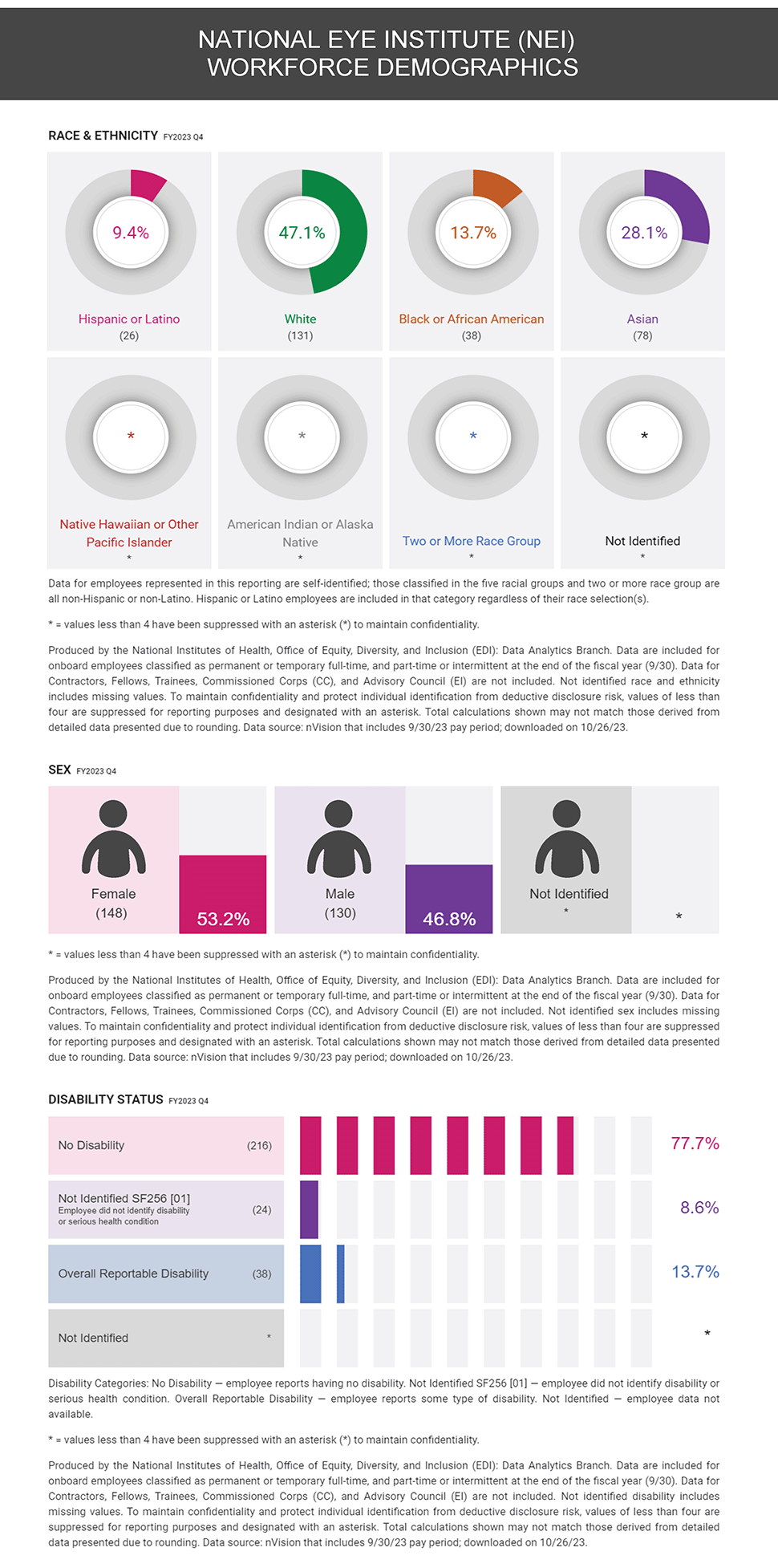
National Eye Institute Workforce Demographics
RACE & ETHNICITY: Workforce Demographics by Race and Ethnicity. Graphic showing the proportions of Hispanic or Latino, White, Black or African American, Asian, Native Hawaiian or Other Pacific Islander, American Indian or Alaska Native, Two or More Race Group, and Not Identified NIH employees for Fiscal Year 2023 Fourth Quarter.
RACE & ETHNICITY: Hispanic or Latino = 26, 9.4%; White = 131, 47.1%; Black or African American = 38, 13.7%; Asian = 78, 28.1%; Native Hawaiian or Other Pacific Islander = *, *%; American Indian or Alaska Native = *, *%; Two or More Race Group = *, *%; Not Identified = *, *%
RACE & ETHNICITY: Data for employees represented in this reporting are self-identified; those classified in the five racial groups and two or more race group are all non-Hispanic or non-Latino. Hispanic or Latino employees are included in that category regardless of their race selection(s).
RACE & ETHNICITY: * = values less than 4 have been suppressed with an asterisk (*) to maintain confidentiality.
RACE & ETHNICITY: Produced by the National Institutes of Health, Office of Equity, Diversity, and Inclusion (EDI): Data Analytics Branch. Data are included for onboard employees classified as permanent or temporary full-time, and part-time or intermittent at the end of the fiscal year (9/30). Data for Contractors, Fellows, Trainees, Commissioned Corps (CC), and Advisory Council (EI) are not included. Not identified race and ethnicity includes missing values. To maintain confidentiality and protect individual identification from deductive disclosure risk, values of less than four are suppressed for reporting purposes and designated with an asterisk. Total calculations shown may not match those derived from detailed data presented due to rounding. Data source: nVision that includes 9/30/23 pay period; downloaded on 10/26/23.
SEX: Workforce Demographics by Sex. Graphic showing the proportions of Female, Male, and Not Identified NIH employees for Fiscal Year 2023 Fourth Quarter.
SEX: FEMALE = 148, 53.2%; MALE = 130, 46.8%; Not Identified = *, *%
SEX: * = values less than 4 have been suppressed with an asterisk (*) to maintain confidentiality.
SEX: Produced by the National Institutes of Health, Office of Equity, Diversity, and Inclusion (EDI): Data Analytics Branch. Data are included for onboard employees classified as permanent or temporary full-time, and part-time or intermittent at the end of the fiscal year (9/30). Data for Contractors, Fellows, Trainees, Commissioned Corps (CC), and Advisory Council (EI) are not included. Not identified sex includes missing values. To maintain confidentiality and protect individual identification from deductive disclosure risk, values of less than four are suppressed for reporting purposes and designated with an asterisk. Total calculations shown may not match those derived from detailed data presented due to rounding. Data source: nVision that includes 9/30/23 pay period; downloaded on 10/26/23.
DISABILITY: Workforce Demographics by Disability Status. Graphic showing the proportions of NIH employees having disability status as the following: No Disability, Not Identified SF256 [01] — Employee did not identify disability or serious health condition, Overall Reportable Disability, and Not Identified NIH employees for Fiscal Year 2023 Fourth Quarter.
DISABILITY: No Disability = 216, 77.7%; Not Identified SF256 [01] — Employee did not identify disability or serious health condition = 24, 8.6%; Overall Reportable Disability = 38, 13.7%; Not Identified = *, *%
DISABILITY: Disability Categories: No Disability — employee reports having no disability. Not Identified SF256 [01] — employee did not identify disability or serious health condition. Overall Reportable Disability — employee reports some type of disability. Not Identified — employee data not available.
Produced by the National Institutes of Health, Office of Equity, Diversity, and Inclusion (EDI): Data Analytics Branch. Data are included for onboard employees classified as permanent or temporary full-time, and part-time or intermittent at the end of the fiscal year (9/30). Data for Contractors, Fellows, Trainees, Commissioned Corps (CC), and Advisory Council (EI) are not included. Not identified disability includes missing values. To maintain confidentiality and protect individual identification from deductive disclosure risk, values of less than four are suppressed for reporting purposes and designated with an asterisk. Total calculations shown may not match those derived from detailed data presented due to rounding. Data source: nVision that includes 9/30/23 pay period; downloaded on 10/26/23.
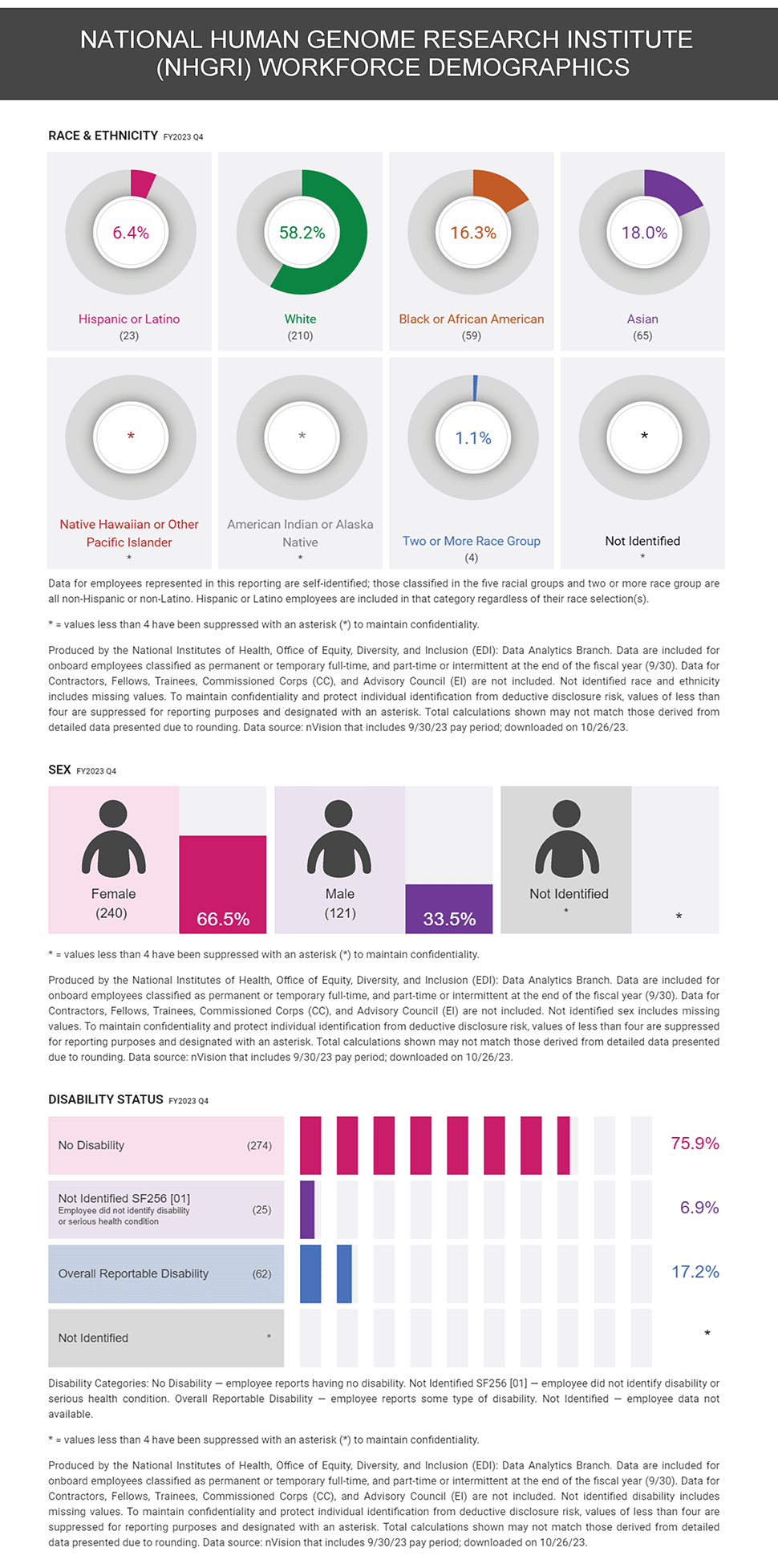
National Human Genome Research Institute Workforce Demographics
RACE & ETHNICITY: Workforce Demographics by Race and Ethnicity. Graphic showing the proportions of Hispanic or Latino, White, Black or African American, Asian, Native Hawaiian or Other Pacific Islander, American Indian or Alaska Native, Two or More Race Group, and Not Identified NIH employees for Fiscal Year 2023 Fourth Quarter.
RACE & ETHNICITY: Hispanic or Latino = 23, 6.4%; White = 210, 58.2%; Black or African American = 59, 16.3%; Asian = 65, 18.0%; Native Hawaiian or Other Pacific Islander = *, *%; American Indian or Alaska Native = *, *%; Two or More Race Group = 4, 1.1%; Not Identified = *, *%
RACE & ETHNICITY: Data for employees represented in this reporting are self-identified; those classified in the five racial groups and two or more race group are all non-Hispanic or non-Latino. Hispanic or Latino employees are included in that category regardless of their race selection(s).
RACE & ETHNICITY: * = values less than 4 have been suppressed with an asterisk (*) to maintain confidentiality.
RACE & ETHNICITY: Produced by the National Institutes of Health, Office of Equity, Diversity, and Inclusion (EDI): Data Analytics Branch. Data are included for onboard employees classified as permanent or temporary full-time, and part-time or intermittent at the end of the fiscal year (9/30). Data for Contractors, Fellows, Trainees, Commissioned Corps (CC), and Advisory Council (EI) are not included. Not identified race and ethnicity includes missing values. To maintain confidentiality and protect individual identification from deductive disclosure risk, values of less than four are suppressed for reporting purposes and designated with an asterisk. Total calculations shown may not match those derived from detailed data presented due to rounding. Data source: nVision that includes 9/30/23 pay period; downloaded on 10/26/23.
SEX: Workforce Demographics by Sex. Graphic showing the proportions of Female, Male, and Not Identified NIH employees for Fiscal Year 2023 Fourth Quarter.
SEX: FEMALE = 240, 66.5%; MALE = 121, 33.5%; Not Identified = *, *%
SEX: * = values less than 4 have been suppressed with an asterisk (*) to maintain confidentiality.
SEX: Produced by the National Institutes of Health, Office of Equity, Diversity, and Inclusion (EDI): Data Analytics Branch. Data are included for onboard employees classified as permanent or temporary full-time, and part-time or intermittent at the end of the fiscal year (9/30). Data for Contractors, Fellows, Trainees, Commissioned Corps (CC), and Advisory Council (EI) are not included. Not identified sex includes missing values. To maintain confidentiality and protect individual identification from deductive disclosure risk, values of less than four are suppressed for reporting purposes and designated with an asterisk. Total calculations shown may not match those derived from detailed data presented due to rounding. Data source: nVision that includes 9/30/23 pay period; downloaded on 10/26/23.
DISABILITY: Workforce Demographics by Disability Status. Graphic showing the proportions of NIH employees having disability status as the following: No Disability, Not Identified SF256 [01] — Employee did not identify disability or serious health condition, Overall Reportable Disability, and Not Identified NIH employees for Fiscal Year 2023 Fourth Quarter.
DISABILITY: No Disability = 274, 75.9%; Not Identified SF256 [01] — Employee did not identify disability or serious health condition = 25, 6.9%; Overall Reportable Disability = 62, 17.2%; Not Identified = *, *%
DISABILITY: Disability Categories: No Disability — employee reports having no disability. Not Identified SF256 [01] — employee did not identify disability or serious health condition. Overall Reportable Disability — employee reports some type of disability. Not Identified — employee data not available.
Produced by the National Institutes of Health, Office of Equity, Diversity, and Inclusion (EDI): Data Analytics Branch. Data are included for onboard employees classified as permanent or temporary full-time, and part-time or intermittent at the end of the fiscal year (9/30). Data for Contractors, Fellows, Trainees, Commissioned Corps (CC), and Advisory Council (EI) are not included. Not identified disability includes missing values. To maintain confidentiality and protect individual identification from deductive disclosure risk, values of less than four are suppressed for reporting purposes and designated with an asterisk. Total calculations shown may not match those derived from detailed data presented due to rounding. Data source: nVision that includes 9/30/23 pay period; downloaded on 10/26/23.
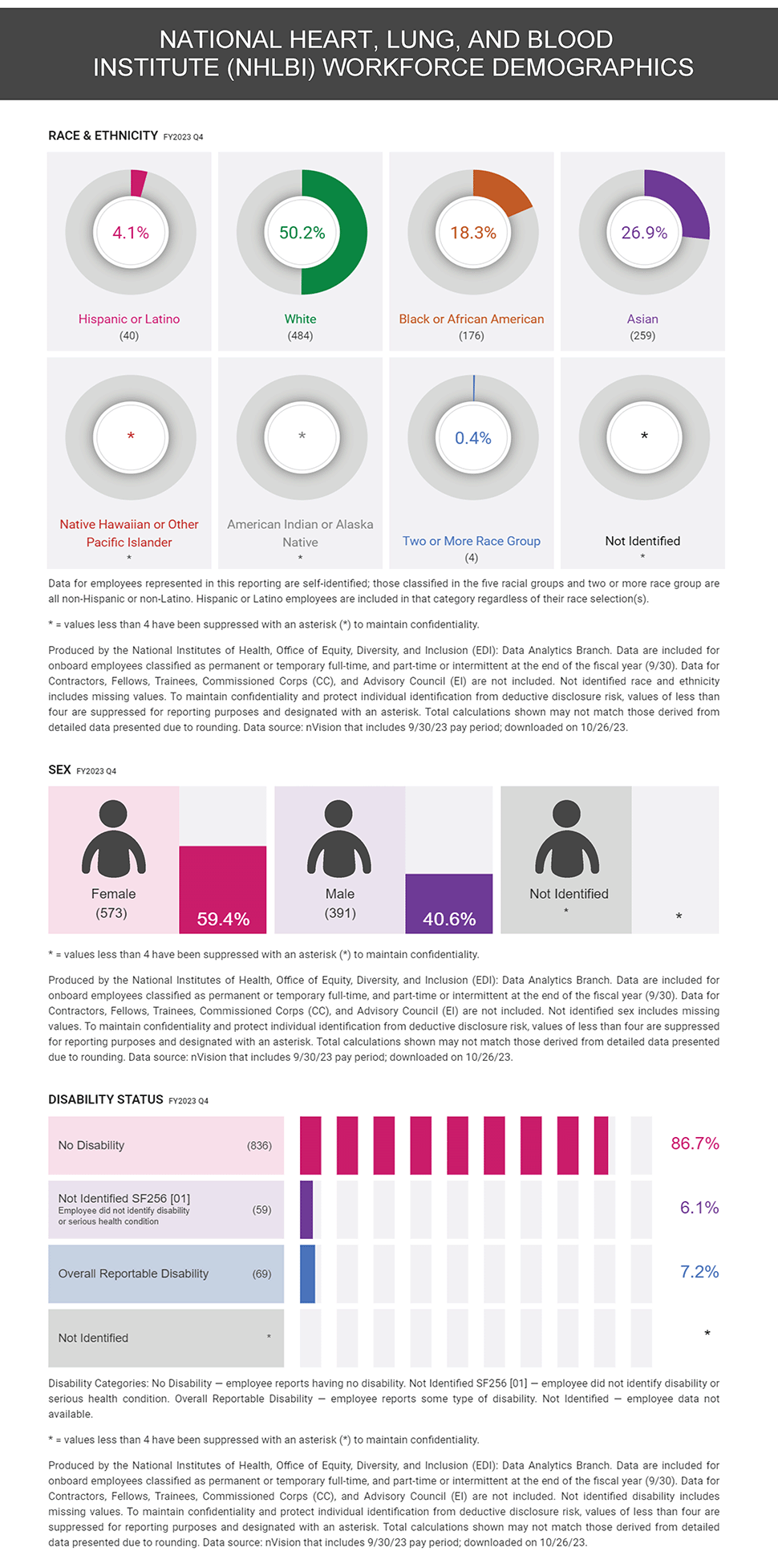
National Heart, Lung, and Blood Institute Workforce Demographics
RACE & ETHNICITY: Workforce Demographics by Race and Ethnicity. Graphic showing the proportions of Hispanic or Latino, White, Black or African American, Asian, Native Hawaiian or Other Pacific Islander, American Indian or Alaska Native, Two or More Race Group, and Not Identified NIH employees for Fiscal Year 2023 Fourth Quarter.
RACE & ETHNICITY: Hispanic or Latino = 40, 4.1%; White = 484, 50.2%; Black or African American = 176, 18.3%; Asian = 259, 26.9%; Native Hawaiian or Other Pacific Islander = *, *%; American Indian or Alaska Native = *, *%; Two or More Race Group = 4, 0.4%; Not Identified = *, *%
RACE & ETHNICITY: Data for employees represented in this reporting are self-identified; those classified in the five racial groups and two or more race group are all non-Hispanic or non-Latino. Hispanic or Latino employees are included in that category regardless of their race selection(s).
RACE & ETHNICITY: * = values less than 4 have been suppressed with an asterisk (*) to maintain confidentiality.
RACE & ETHNICITY: Produced by the National Institutes of Health, Office of Equity, Diversity, and Inclusion (EDI): Data Analytics Branch. Data are included for onboard employees classified as permanent or temporary full-time, and part-time or intermittent at the end of the fiscal year (9/30). Data for Contractors, Fellows, Trainees, Commissioned Corps (CC), and Advisory Council (EI) are not included. Not identified race and ethnicity includes missing values. To maintain confidentiality and protect individual identification from deductive disclosure risk, values of less than four are suppressed for reporting purposes and designated with an asterisk. Total calculations shown may not match those derived from detailed data presented due to rounding. Data source: nVision that includes 9/30/23 pay period; downloaded on 10/26/23.
SEX: Workforce Demographics by Sex. Graphic showing the proportions of Female, Male, and Not Identified NIH employees for Fiscal Year 2023 Fourth Quarter.
SEX: FEMALE = 573, 59.4%; MALE = 391, 40.6%; Not Identified = *, *%
SEX: * = values less than 4 have been suppressed with an asterisk (*) to maintain confidentiality.
SEX: Produced by the National Institutes of Health, Office of Equity, Diversity, and Inclusion (EDI): Data Analytics Branch. Data are included for onboard employees classified as permanent or temporary full-time, and part-time or intermittent at the end of the fiscal year (9/30). Data for Contractors, Fellows, Trainees, Commissioned Corps (CC), and Advisory Council (EI) are not included. Not identified sex includes missing values. To maintain confidentiality and protect individual identification from deductive disclosure risk, values of less than four are suppressed for reporting purposes and designated with an asterisk. Total calculations shown may not match those derived from detailed data presented due to rounding. Data source: nVision that includes 9/30/23 pay period; downloaded on 10/26/23.
DISABILITY: Workforce Demographics by Disability Status. Graphic showing the proportions of NIH employees having disability status as the following: No Disability, Not Identified SF256 [01] — Employee did not identify disability or serious health condition, Overall Reportable Disability, and Not Identified NIH employees for Fiscal Year 2023 Fourth Quarter.
DISABILITY: No Disability = 836, 86.7%; Not Identified SF256 [01] — Employee did not identify disability or serious health condition = 59, 6.1%; Overall Reportable Disability = 69, 7.2%; Not Identified = *, *%
DISABILITY: Disability Categories: No Disability — employee reports having no disability. Not Identified SF256 [01] — employee did not identify disability or serious health condition. Overall Reportable Disability — employee reports some type of disability. Not Identified — employee data not available.
Produced by the National Institutes of Health, Office of Equity, Diversity, and Inclusion (EDI): Data Analytics Branch. Data are included for onboard employees classified as permanent or temporary full-time, and part-time or intermittent at the end of the fiscal year (9/30). Data for Contractors, Fellows, Trainees, Commissioned Corps (CC), and Advisory Council (EI) are not included. Not identified disability includes missing values. To maintain confidentiality and protect individual identification from deductive disclosure risk, values of less than four are suppressed for reporting purposes and designated with an asterisk. Total calculations shown may not match those derived from detailed data presented due to rounding. Data source: nVision that includes 9/30/23 pay period; downloaded on 10/26/23.
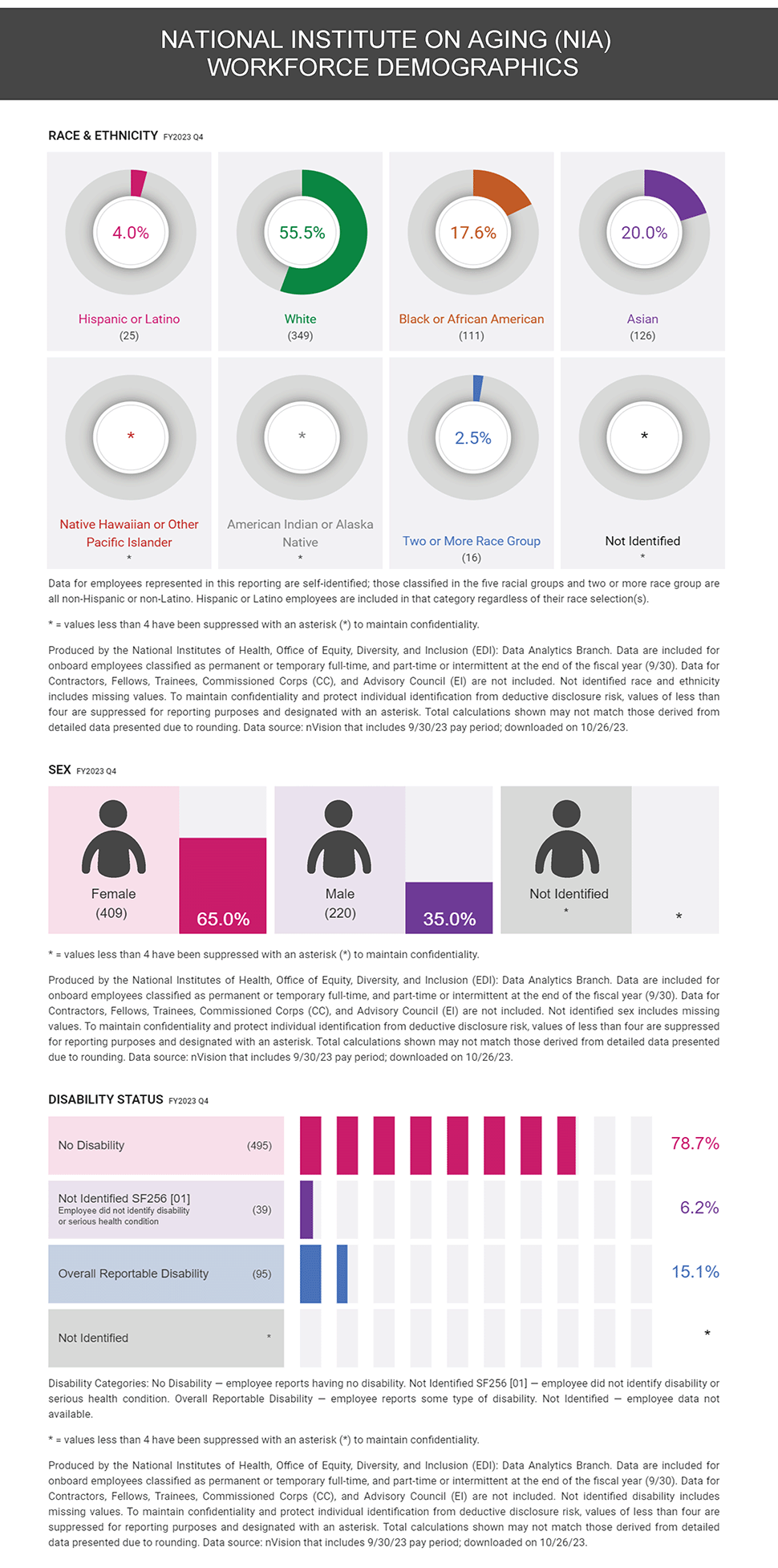
National Institute on Aging Workforce Demographics
RACE & ETHNICITY: Workforce Demographics by Race and Ethnicity. Graphic showing the proportions of Hispanic or Latino, White, Black or African American, Asian, Native Hawaiian or Other Pacific Islander, American Indian or Alaska Native, Two or More Race Group, and Not Identified NIH employees for Fiscal Year 2023 Fourth Quarter.
RACE & ETHNICITY: Hispanic or Latino = 25, 4.0%; White = 349, 55.5%; Black or African American = 111, 17.6%; Asian = 126, 20.0%; Native Hawaiian or Other Pacific Islander = *, *%; American Indian or Alaska Native = *, *%; Two or More Race Group = 16, 2.5%; Not Identified = *, *%
RACE & ETHNICITY: Data for employees represented in this reporting are self-identified; those classified in the five racial groups and two or more race group are all non-Hispanic or non-Latino. Hispanic or Latino employees are included in that category regardless of their race selection(s).
RACE & ETHNICITY: * = values less than 4 have been suppressed with an asterisk (*) to maintain confidentiality.
RACE & ETHNICITY: Produced by the National Institutes of Health, Office of Equity, Diversity, and Inclusion (EDI): Data Analytics Branch. Data are included for onboard employees classified as permanent or temporary full-time, and part-time or intermittent at the end of the fiscal year (9/30). Data for Contractors, Fellows, Trainees, Commissioned Corps (CC), and Advisory Council (EI) are not included. Not identified race and ethnicity includes missing values. To maintain confidentiality and protect individual identification from deductive disclosure risk, values of less than four are suppressed for reporting purposes and designated with an asterisk. Total calculations shown may not match those derived from detailed data presented due to rounding. Data source: nVision that includes 9/30/23 pay period; downloaded on 10/26/23.
SEX: Workforce Demographics by Sex. Graphic showing the proportions of Female, Male, and Not Identified NIH employees for Fiscal Year 2023 Fourth Quarter.
SEX: FEMALE = 409, 65.0%; MALE = 220, 35.0%; Not Identified = *, *%
SEX: * = values less than 4 have been suppressed with an asterisk (*) to maintain confidentiality.
SEX: Produced by the National Institutes of Health, Office of Equity, Diversity, and Inclusion (EDI): Data Analytics Branch. Data are included for onboard employees classified as permanent or temporary full-time, and part-time or intermittent at the end of the fiscal year (9/30). Data for Contractors, Fellows, Trainees, Commissioned Corps (CC), and Advisory Council (EI) are not included. Not identified sex includes missing values. To maintain confidentiality and protect individual identification from deductive disclosure risk, values of less than four are suppressed for reporting purposes and designated with an asterisk. Total calculations shown may not match those derived from detailed data presented due to rounding. Data source: nVision that includes 9/30/23 pay period; downloaded on 10/26/23.
DISABILITY: Workforce Demographics by Disability Status. Graphic showing the proportions of NIH employees having disability status as the following: No Disability, Not Identified SF256 [01] — Employee did not identify disability or serious health condition, Overall Reportable Disability, and Not Identified NIH employees for Fiscal Year 2023 Fourth Quarter.
DISABILITY: No Disability = 495, 78.7%; Not Identified SF256 [01] — Employee did not identify disability or serious health condition = 39, 6.2%; Overall Reportable Disability = 95, 15.1%; Not Identified = *, *%
DISABILITY: Disability Categories: No Disability — employee reports having no disability. Not Identified SF256 [01] — employee did not identify disability or serious health condition. Overall Reportable Disability — employee reports some type of disability. Not Identified — employee data not available.
Produced by the National Institutes of Health, Office of Equity, Diversity, and Inclusion (EDI): Data Analytics Branch. Data are included for onboard employees classified as permanent or temporary full-time, and part-time or intermittent at the end of the fiscal year (9/30). Data for Contractors, Fellows, Trainees, Commissioned Corps (CC), and Advisory Council (EI) are not included. Not identified disability includes missing values. To maintain confidentiality and protect individual identification from deductive disclosure risk, values of less than four are suppressed for reporting purposes and designated with an asterisk. Total calculations shown may not match those derived from detailed data presented due to rounding. Data source: nVision that includes 9/30/23 pay period; downloaded on 10/26/23.
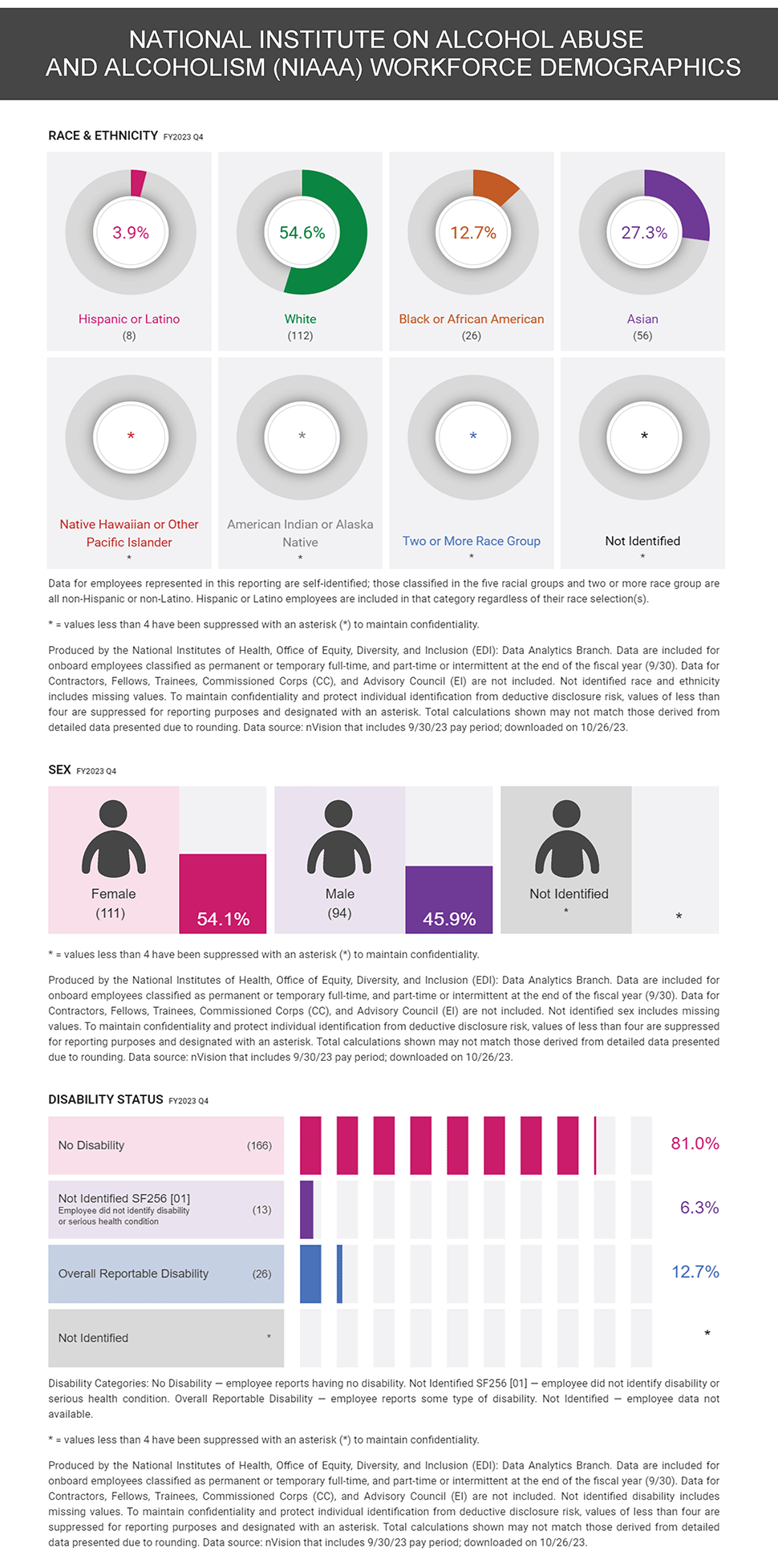
National Institute on Alcohol Abuse and Alcoholism Workforce Demographics
RACE & ETHNICITY: Workforce Demographics by Race and Ethnicity. Graphic showing the proportions of Hispanic or Latino, White, Black or African American, Asian, Native Hawaiian or Other Pacific Islander, American Indian or Alaska Native, Two or More Race Group, and Not Identified NIH employees for Fiscal Year 2023 Fourth Quarter.
RACE & ETHNICITY: Hispanic or Latino = 8, 3.9%; White = 112, 54.6%; Black or African American = 26, 12.7%; Asian = 56, 27.3%; Native Hawaiian or Other Pacific Islander = *, *%; American Indian or Alaska Native = *, *%; Two or More Race Group = *, *%; Not Identified = *, *%
RACE & ETHNICITY: Data for employees represented in this reporting are self-identified; those classified in the five racial groups and two or more race group are all non-Hispanic or non-Latino. Hispanic or Latino employees are included in that category regardless of their race selection(s).
RACE & ETHNICITY: * = values less than 4 have been suppressed with an asterisk (*) to maintain confidentiality.
RACE & ETHNICITY: Produced by the National Institutes of Health, Office of Equity, Diversity, and Inclusion (EDI): Data Analytics Branch. Data are included for onboard employees classified as permanent or temporary full-time, and part-time or intermittent at the end of the fiscal year (9/30). Data for Contractors, Fellows, Trainees, Commissioned Corps (CC), and Advisory Council (EI) are not included. Not identified race and ethnicity includes missing values. To maintain confidentiality and protect individual identification from deductive disclosure risk, values of less than four are suppressed for reporting purposes and designated with an asterisk. Total calculations shown may not match those derived from detailed data presented due to rounding. Data source: nVision that includes 9/30/23 pay period; downloaded on 10/26/23.
SEX: Workforce Demographics by Sex. Graphic showing the proportions of Female, Male, and Not Identified NIH employees for Fiscal Year 2023 Fourth Quarter.
SEX: FEMALE = 111, 54.1%; MALE = 94, 45.9%; Not Identified = *, *%
SEX: * = values less than 4 have been suppressed with an asterisk (*) to maintain confidentiality.
SEX: Produced by the National Institutes of Health, Office of Equity, Diversity, and Inclusion (EDI): Data Analytics Branch. Data are included for onboard employees classified as permanent or temporary full-time, and part-time or intermittent at the end of the fiscal year (9/30). Data for Contractors, Fellows, Trainees, Commissioned Corps (CC), and Advisory Council (EI) are not included. Not identified sex includes missing values. To maintain confidentiality and protect individual identification from deductive disclosure risk, values of less than four are suppressed for reporting purposes and designated with an asterisk. Total calculations shown may not match those derived from detailed data presented due to rounding. Data source: nVision that includes 9/30/23 pay period; downloaded on 10/26/23.
DISABILITY: Workforce Demographics by Disability Status. Graphic showing the proportions of NIH employees having disability status as the following: No Disability, Not Identified SF256 [01] — Employee did not identify disability or serious health condition, Overall Reportable Disability, and Not Identified NIH employees for Fiscal Year 2023 Fourth Quarter.
DISABILITY: No Disability = 166, 81.0%; Not Identified SF256 [01] — Employee did not identify disability or serious health condition = 13, 6.3%; Overall Reportable Disability = 26, 12.7%; Not Identified = *, *%
DISABILITY: Disability Categories: No Disability — employee reports having no disability. Not Identified SF256 [01] — employee did not identify disability or serious health condition. Overall Reportable Disability — employee reports some type of disability. Not Identified — employee data not available.
Produced by the National Institutes of Health, Office of Equity, Diversity, and Inclusion (EDI): Data Analytics Branch. Data are included for onboard employees classified as permanent or temporary full-time, and part-time or intermittent at the end of the fiscal year (9/30). Data for Contractors, Fellows, Trainees, Commissioned Corps (CC), and Advisory Council (EI) are not included. Not identified disability includes missing values. To maintain confidentiality and protect individual identification from deductive disclosure risk, values of less than four are suppressed for reporting purposes and designated with an asterisk. Total calculations shown may not match those derived from detailed data presented due to rounding. Data source: nVision that includes 9/30/23 pay period; downloaded on 10/26/23.
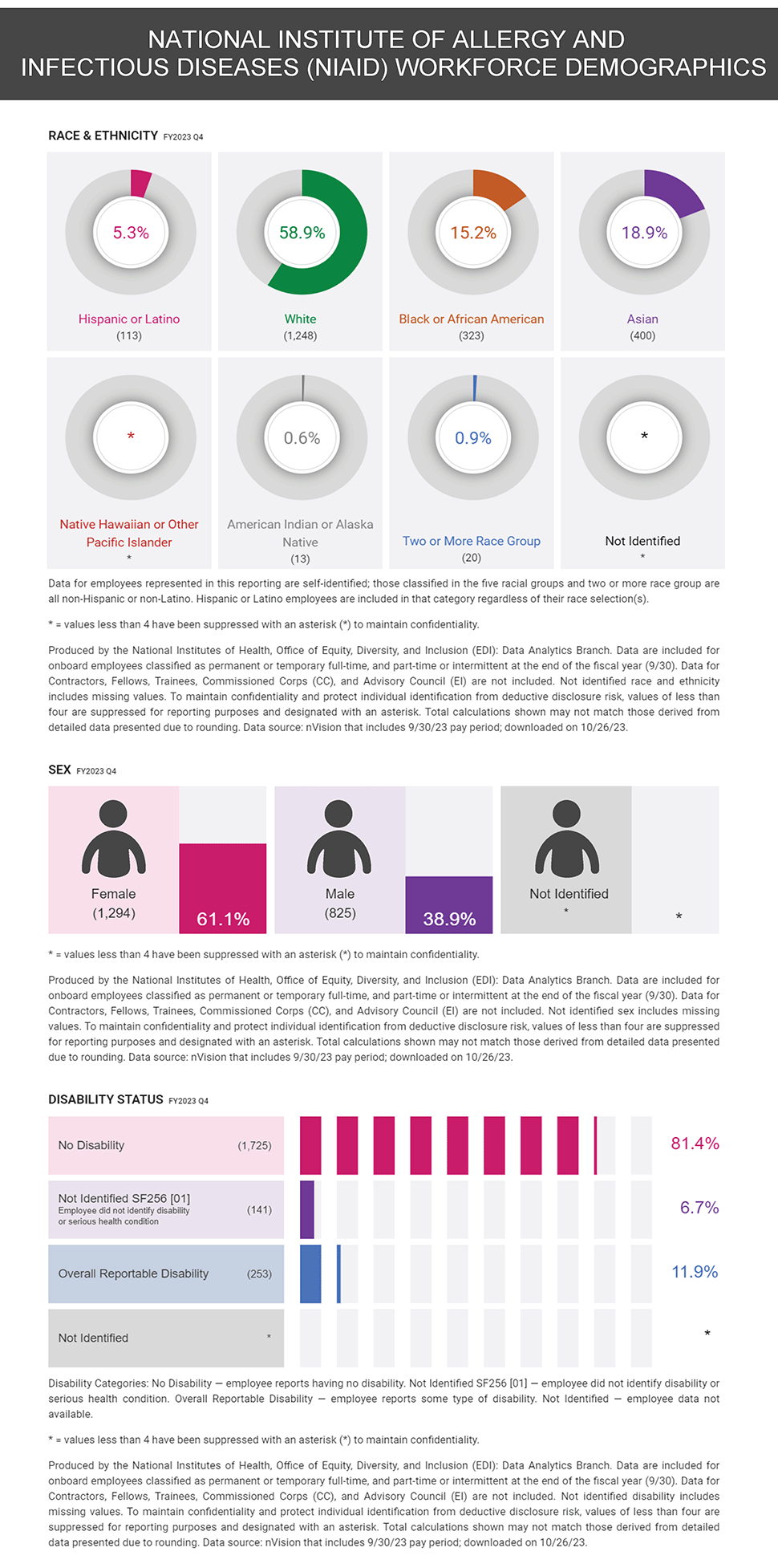
National Institute of Allergy and Infectious Diseases Workforce Demographics
RACE & ETHNICITY: Workforce Demographics by Race and Ethnicity. Graphic showing the proportions of Hispanic or Latino, White, Black or African American, Asian, Native Hawaiian or Other Pacific Islander, American Indian or Alaska Native, Two or More Race Group, and Not Identified NIH employees for Fiscal Year 2023 Fourth Quarter.
RACE & ETHNICITY: Hispanic or Latino = 113, 5.3%; White = 1248, 58.9%; Black or African American = 323, 15.2%; Asian = 400, 18.9%; Native Hawaiian or Other Pacific Islander = *, *%; American Indian or Alaska Native = 13, 0.6%; Two or More Race Group = 20, 0.9%; Not Identified = *, *%
RACE & ETHNICITY: Data for employees represented in this reporting are self-identified; those classified in the five racial groups and two or more race group are all non-Hispanic or non-Latino. Hispanic or Latino employees are included in that category regardless of their race selection(s).
RACE & ETHNICITY: * = values less than 4 have been suppressed with an asterisk (*) to maintain confidentiality.
RACE & ETHNICITY: Produced by the National Institutes of Health, Office of Equity, Diversity, and Inclusion (EDI): Data Analytics Branch. Data are included for onboard employees classified as permanent or temporary full-time, and part-time or intermittent at the end of the fiscal year (9/30). Data for Contractors, Fellows, Trainees, Commissioned Corps (CC), and Advisory Council (EI) are not included. Not identified race and ethnicity includes missing values. To maintain confidentiality and protect individual identification from deductive disclosure risk, values of less than four are suppressed for reporting purposes and designated with an asterisk. Total calculations shown may not match those derived from detailed data presented due to rounding. Data source: nVision that includes 9/30/23 pay period; downloaded on 10/26/23.
SEX: Workforce Demographics by Sex. Graphic showing the proportions of Female, Male, and Not Identified NIH employees for Fiscal Year 2023 Fourth Quarter.
SEX: FEMALE = 1294, 61.1%; MALE = 825, 38.9%; Not Identified = *, *%
SEX: * = values less than 4 have been suppressed with an asterisk (*) to maintain confidentiality.
SEX: Produced by the National Institutes of Health, Office of Equity, Diversity, and Inclusion (EDI): Data Analytics Branch. Data are included for onboard employees classified as permanent or temporary full-time, and part-time or intermittent at the end of the fiscal year (9/30). Data for Contractors, Fellows, Trainees, Commissioned Corps (CC), and Advisory Council (EI) are not included. Not identified sex includes missing values. To maintain confidentiality and protect individual identification from deductive disclosure risk, values of less than four are suppressed for reporting purposes and designated with an asterisk. Total calculations shown may not match those derived from detailed data presented due to rounding. Data source: nVision that includes 9/30/23 pay period; downloaded on 10/26/23.
DISABILITY: Workforce Demographics by Disability Status. Graphic showing the proportions of NIH employees having disability status as the following: No Disability, Not Identified SF256 [01] — Employee did not identify disability or serious health condition, Overall Reportable Disability, and Not Identified NIH employees for Fiscal Year 2023 Fourth Quarter.
DISABILITY: No Disability = 1725, 81.4%; Not Identified SF256 [01] — Employee did not identify disability or serious health condition = 141, 6.7%; Overall Reportable Disability = 253, 11.9%; Not Identified = *, *%
DISABILITY: Disability Categories: No Disability — employee reports having no disability. Not Identified SF256 [01] — employee did not identify disability or serious health condition. Overall Reportable Disability — employee reports some type of disability. Not Identified — employee data not available.
Produced by the National Institutes of Health, Office of Equity, Diversity, and Inclusion (EDI): Data Analytics Branch. Data are included for onboard employees classified as permanent or temporary full-time, and part-time or intermittent at the end of the fiscal year (9/30). Data for Contractors, Fellows, Trainees, Commissioned Corps (CC), and Advisory Council (EI) are not included. Not identified disability includes missing values. To maintain confidentiality and protect individual identification from deductive disclosure risk, values of less than four are suppressed for reporting purposes and designated with an asterisk. Total calculations shown may not match those derived from detailed data presented due to rounding. Data source: nVision that includes 9/30/23 pay period; downloaded on 10/26/23.
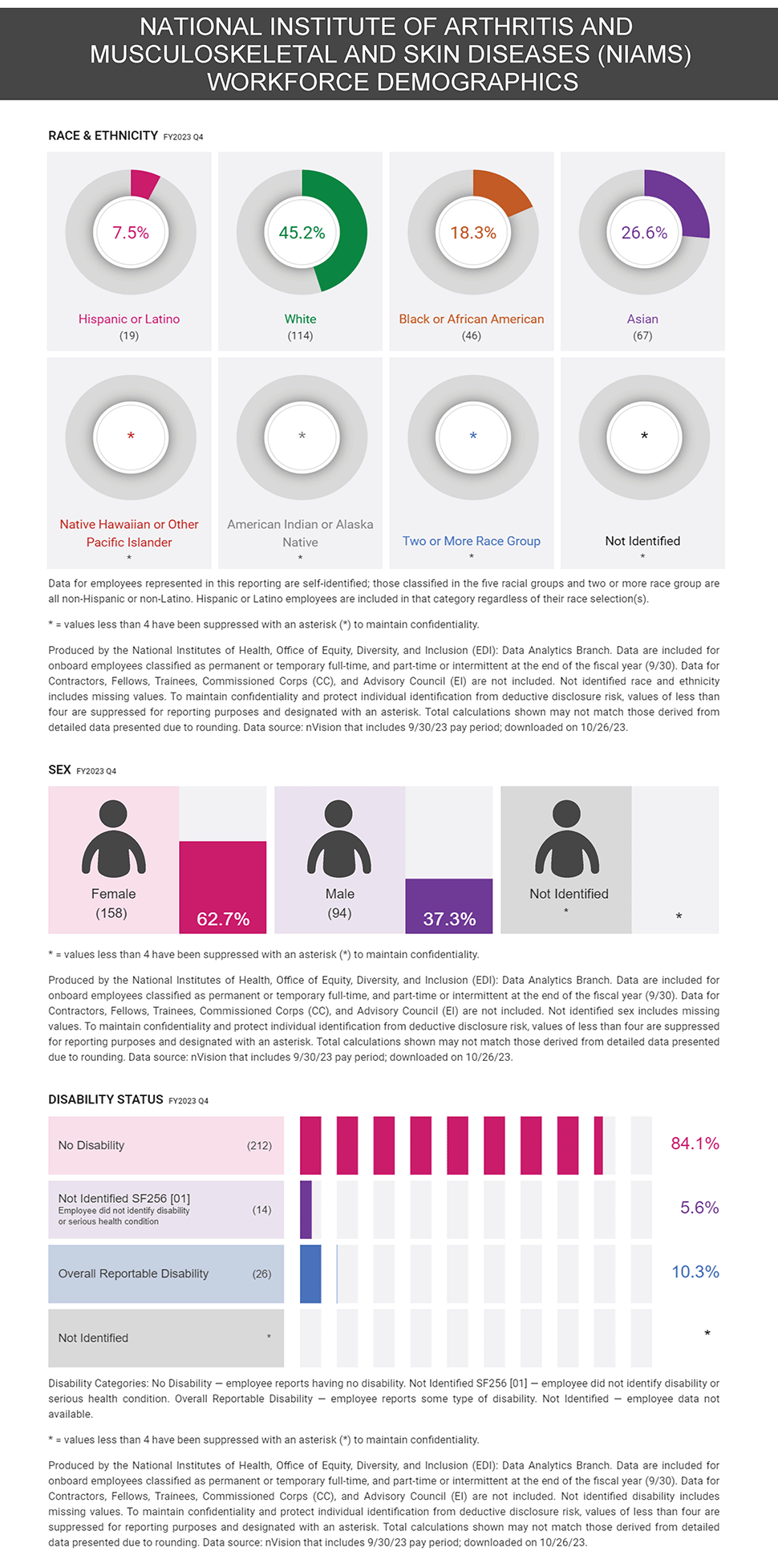
National Institute of Arthritis and Musculoskeletal and Skin Disease Workforce Demographics
RACE & ETHNICITY: Workforce Demographics by Race and Ethnicity. Graphic showing the proportions of Hispanic or Latino, White, Black or African American, Asian, Native Hawaiian or Other Pacific Islander, American Indian or Alaska Native, Two or More Race Group, and Not Identified NIH employees for Fiscal Year 2023 Fourth Quarter.
RACE & ETHNICITY: Hispanic or Latino = 19, 7.5%; White = 114, 45.2%; Black or African American = 46, 18.3%; Asian = 67, 26.6%; Native Hawaiian or Other Pacific Islander = *, *%; American Indian or Alaska Native = *, *%; Two or More Race Group = *, *%; Not Identified = *, *%
RACE & ETHNICITY: Data for employees represented in this reporting are self-identified; those classified in the five racial groups and two or more race group are all non-Hispanic or non-Latino. Hispanic or Latino employees are included in that category regardless of their race selection(s).
RACE & ETHNICITY: * = values less than 4 have been suppressed with an asterisk (*) to maintain confidentiality.
RACE & ETHNICITY: Produced by the National Institutes of Health, Office of Equity, Diversity, and Inclusion (EDI): Data Analytics Branch. Data are included for onboard employees classified as permanent or temporary full-time, and part-time or intermittent at the end of the fiscal year (9/30). Data for Contractors, Fellows, Trainees, Commissioned Corps (CC), and Advisory Council (EI) are not included. Not identified race and ethnicity includes missing values. To maintain confidentiality and protect individual identification from deductive disclosure risk, values of less than four are suppressed for reporting purposes and designated with an asterisk. Total calculations shown may not match those derived from detailed data presented due to rounding. Data source: nVision that includes 9/30/23 pay period; downloaded on 10/26/23.
SEX: Workforce Demographics by Sex. Graphic showing the proportions of Female, Male, and Not Identified NIH employees for Fiscal Year 2023 Fourth Quarter.
SEX: FEMALE = 158, 62.7%; MALE = 94, 37.3%; Not Identified = *, *%
SEX: * = values less than 4 have been suppressed with an asterisk (*) to maintain confidentiality.
SEX: Produced by the National Institutes of Health, Office of Equity, Diversity, and Inclusion (EDI): Data Analytics Branch. Data are included for onboard employees classified as permanent or temporary full-time, and part-time or intermittent at the end of the fiscal year (9/30). Data for Contractors, Fellows, Trainees, Commissioned Corps (CC), and Advisory Council (EI) are not included. Not identified sex includes missing values. To maintain confidentiality and protect individual identification from deductive disclosure risk, values of less than four are suppressed for reporting purposes and designated with an asterisk. Total calculations shown may not match those derived from detailed data presented due to rounding. Data source: nVision that includes 9/30/23 pay period; downloaded on 10/26/23.
DISABILITY: Workforce Demographics by Disability Status. Graphic showing the proportions of NIH employees having disability status as the following: No Disability, Not Identified SF256 [01] — Employee did not identify disability or serious health condition, Overall Reportable Disability, and Not Identified NIH employees for Fiscal Year 2023 Fourth Quarter.
DISABILITY: No Disability = 212, 84.1%; Not Identified SF256 [01] — Employee did not identify disability or serious health condition = 14, 5.6%; Overall Reportable Disability = 26, 10.3%; Not Identified = *, *%
DISABILITY: Disability Categories: No Disability — employee reports having no disability. Not Identified SF256 [01] — employee did not identify disability or serious health condition. Overall Reportable Disability — employee reports some type of disability. Not Identified — employee data not available.
Produced by the National Institutes of Health, Office of Equity, Diversity, and Inclusion (EDI): Data Analytics Branch. Data are included for onboard employees classified as permanent or temporary full-time, and part-time or intermittent at the end of the fiscal year (9/30). Data for Contractors, Fellows, Trainees, Commissioned Corps (CC), and Advisory Council (EI) are not included. Not identified disability includes missing values. To maintain confidentiality and protect individual identification from deductive disclosure risk, values of less than four are suppressed for reporting purposes and designated with an asterisk. Total calculations shown may not match those derived from detailed data presented due to rounding. Data source: nVision that includes 9/30/23 pay period; downloaded on 10/26/23.
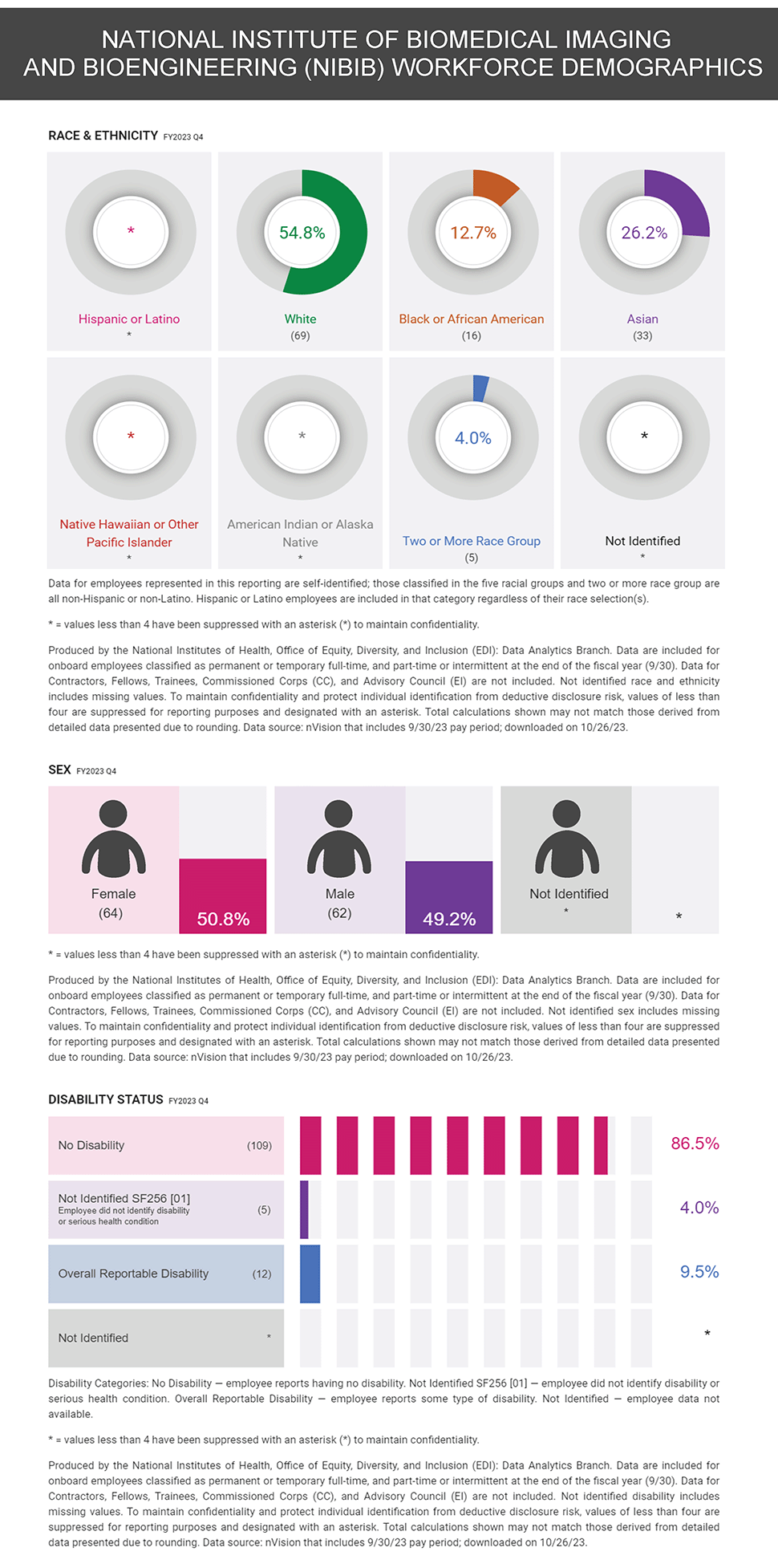
National Institute of Biomedical Imaging and Bioengineering Workforce Demographics
RACE & ETHNICITY: Workforce Demographics by Race and Ethnicity. Graphic showing the proportions of Hispanic or Latino, White, Black or African American, Asian, Native Hawaiian or Other Pacific Islander, American Indian or Alaska Native, Two or More Race Group, and Not Identified NIH employees for Fiscal Year 2023 Fourth Quarter.
RACE & ETHNICITY: Hispanic or Latino = *, *%; White = 69, 54.8%; Black or African American = 16, 12.7%; Asian = 33, 26.2%; Native Hawaiian or Other Pacific Islander = *, *%; American Indian or Alaska Native = *, *%; Two or More Race Group = 5, 4.0%; Not Identified = *, *%
RACE & ETHNICITY: Data for employees represented in this reporting are self-identified; those classified in the five racial groups and two or more race group are all non-Hispanic or non-Latino. Hispanic or Latino employees are included in that category regardless of their race selection(s).
RACE & ETHNICITY: * = values less than 4 have been suppressed with an asterisk (*) to maintain confidentiality.
RACE & ETHNICITY: Produced by the National Institutes of Health, Office of Equity, Diversity, and Inclusion (EDI): Data Analytics Branch. Data are included for onboard employees classified as permanent or temporary full-time, and part-time or intermittent at the end of the fiscal year (9/30). Data for Contractors, Fellows, Trainees, Commissioned Corps (CC), and Advisory Council (EI) are not included. Not identified race and ethnicity includes missing values. To maintain confidentiality and protect individual identification from deductive disclosure risk, values of less than four are suppressed for reporting purposes and designated with an asterisk. Total calculations shown may not match those derived from detailed data presented due to rounding. Data source: nVision that includes 9/30/23 pay period; downloaded on 10/26/23.
SEX: Workforce Demographics by Sex. Graphic showing the proportions of Female, Male, and Not Identified NIH employees for Fiscal Year 2023 Fourth Quarter.
SEX: FEMALE = 64, 50.8%; MALE = 62, 49.2%; Not Identified = *, *%
SEX: * = values less than 4 have been suppressed with an asterisk (*) to maintain confidentiality.
SEX: Produced by the National Institutes of Health, Office of Equity, Diversity, and Inclusion (EDI): Data Analytics Branch. Data are included for onboard employees classified as permanent or temporary full-time, and part-time or intermittent at the end of the fiscal year (9/30). Data for Contractors, Fellows, Trainees, Commissioned Corps (CC), and Advisory Council (EI) are not included. Not identified sex includes missing values. To maintain confidentiality and protect individual identification from deductive disclosure risk, values of less than four are suppressed for reporting purposes and designated with an asterisk. Total calculations shown may not match those derived from detailed data presented due to rounding. Data source: nVision that includes 9/30/23 pay period; downloaded on 10/26/23.
DISABILITY: Workforce Demographics by Disability Status. Graphic showing the proportions of NIH employees having disability status as the following: No Disability, Not Identified SF256 [01] — Employee did not identify disability or serious health condition, Overall Reportable Disability, and Not Identified NIH employees for Fiscal Year 2023 Fourth Quarter.
DISABILITY: No Disability = 109, 86.5%; Not Identified SF256 [01] — Employee did not identify disability or serious health condition = 5, 4.0%; Overall Reportable Disability = 12, 9.5%; Not Identified = *, *%
DISABILITY: Disability Categories: No Disability — employee reports having no disability. Not Identified SF256 [01] — employee did not identify disability or serious health condition. Overall Reportable Disability — employee reports some type of disability. Not Identified — employee data not available.
Produced by the National Institutes of Health, Office of Equity, Diversity, and Inclusion (EDI): Data Analytics Branch. Data are included for onboard employees classified as permanent or temporary full-time, and part-time or intermittent at the end of the fiscal year (9/30). Data for Contractors, Fellows, Trainees, Commissioned Corps (CC), and Advisory Council (EI) are not included. Not identified disability includes missing values. To maintain confidentiality and protect individual identification from deductive disclosure risk, values of less than four are suppressed for reporting purposes and designated with an asterisk. Total calculations shown may not match those derived from detailed data presented due to rounding. Data source: nVision that includes 9/30/23 pay period; downloaded on 10/26/23.
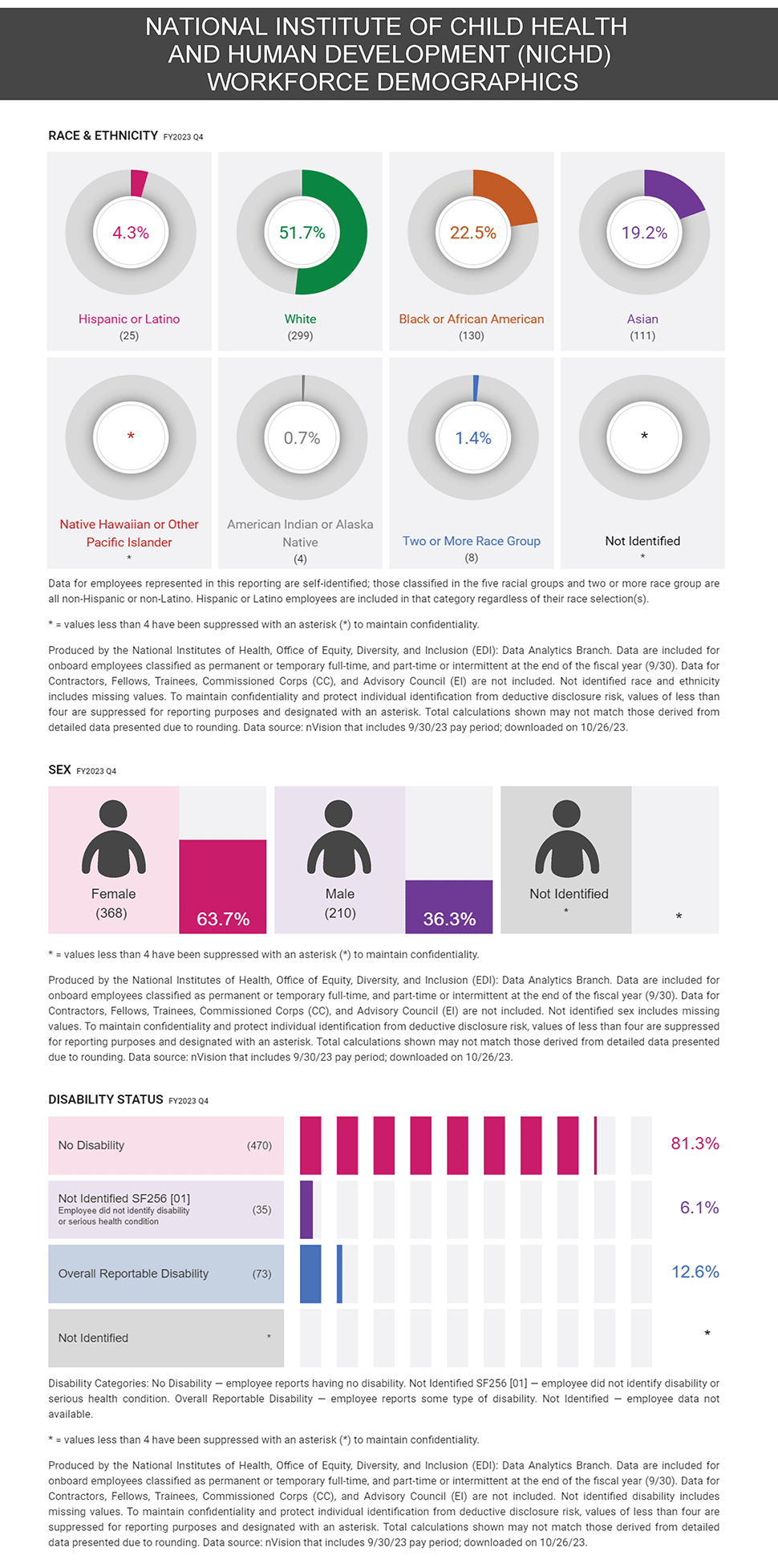
Eunice Kennedy Shriver National Institute of Child Health and Human Development Workforce Demographics
RACE & ETHNICITY: Workforce Demographics by Race and Ethnicity. Graphic showing the proportions of Hispanic or Latino, White, Black or African American, Asian, Native Hawaiian or Other Pacific Islander, American Indian or Alaska Native, Two or More Race Group, and Not Identified NIH employees for Fiscal Year 2023 Fourth Quarter.
RACE & ETHNICITY: Hispanic or Latino = 25, 4.3%; White = 299, 51.7%; Black or African American = 130, 22.5%; Asian = 111, 19.2%; Native Hawaiian or Other Pacific Islander = *, *%; American Indian or Alaska Native = 4, 0.7%; Two or More Race Group = 8, 1.4%; Not Identified = *, *%
RACE & ETHNICITY: Data for employees represented in this reporting are self-identified; those classified in the five racial groups and two or more race group are all non-Hispanic or non-Latino. Hispanic or Latino employees are included in that category regardless of their race selection(s).
RACE & ETHNICITY: * = values less than 4 have been suppressed with an asterisk (*) to maintain confidentiality.
RACE & ETHNICITY: Produced by the National Institutes of Health, Office of Equity, Diversity, and Inclusion (EDI): Data Analytics Branch. Data are included for onboard employees classified as permanent or temporary full-time, and part-time or intermittent at the end of the fiscal year (9/30). Data for Contractors, Fellows, Trainees, Commissioned Corps (CC), and Advisory Council (EI) are not included. Not identified race and ethnicity includes missing values. To maintain confidentiality and protect individual identification from deductive disclosure risk, values of less than four are suppressed for reporting purposes and designated with an asterisk. Total calculations shown may not match those derived from detailed data presented due to rounding. Data source: nVision that includes 9/30/23 pay period; downloaded on 10/26/23.
SEX: Workforce Demographics by Sex. Graphic showing the proportions of Female, Male, and Not Identified NIH employees for Fiscal Year 2023 Fourth Quarter.
SEX: FEMALE = 368, 63.7%; MALE = 210, 36.3%; Not Identified = *, *%
SEX: * = values less than 4 have been suppressed with an asterisk (*) to maintain confidentiality.
SEX: Produced by the National Institutes of Health, Office of Equity, Diversity, and Inclusion (EDI): Data Analytics Branch. Data are included for onboard employees classified as permanent or temporary full-time, and part-time or intermittent at the end of the fiscal year (9/30). Data for Contractors, Fellows, Trainees, Commissioned Corps (CC), and Advisory Council (EI) are not included. Not identified sex includes missing values. To maintain confidentiality and protect individual identification from deductive disclosure risk, values of less than four are suppressed for reporting purposes and designated with an asterisk. Total calculations shown may not match those derived from detailed data presented due to rounding. Data source: nVision that includes 9/30/23 pay period; downloaded on 10/26/23.
DISABILITY: Workforce Demographics by Disability Status. Graphic showing the proportions of NIH employees having disability status as the following: No Disability, Not Identified SF256 [01] — Employee did not identify disability or serious health condition, Overall Reportable Disability, and Not Identified NIH employees for Fiscal Year 2023 Fourth Quarter.
DISABILITY: No Disability = 470, 81.3%; Not Identified SF256 [01] — Employee did not identify disability or serious health condition = 35, 6.1%; Overall Reportable Disability = 73, 12.6%; Not Identified = *, *%
DISABILITY: Disability Categories: No Disability — employee reports having no disability. Not Identified SF256 [01] — employee did not identify disability or serious health condition. Overall Reportable Disability — employee reports some type of disability. Not Identified — employee data not available.
Produced by the National Institutes of Health, Office of Equity, Diversity, and Inclusion (EDI): Data Analytics Branch. Data are included for onboard employees classified as permanent or temporary full-time, and part-time or intermittent at the end of the fiscal year (9/30). Data for Contractors, Fellows, Trainees, Commissioned Corps (CC), and Advisory Council (EI) are not included. Not identified disability includes missing values. To maintain confidentiality and protect individual identification from deductive disclosure risk, values of less than four are suppressed for reporting purposes and designated with an asterisk. Total calculations shown may not match those derived from detailed data presented due to rounding. Data source: nVision that includes 9/30/23 pay period; downloaded on 10/26/23.
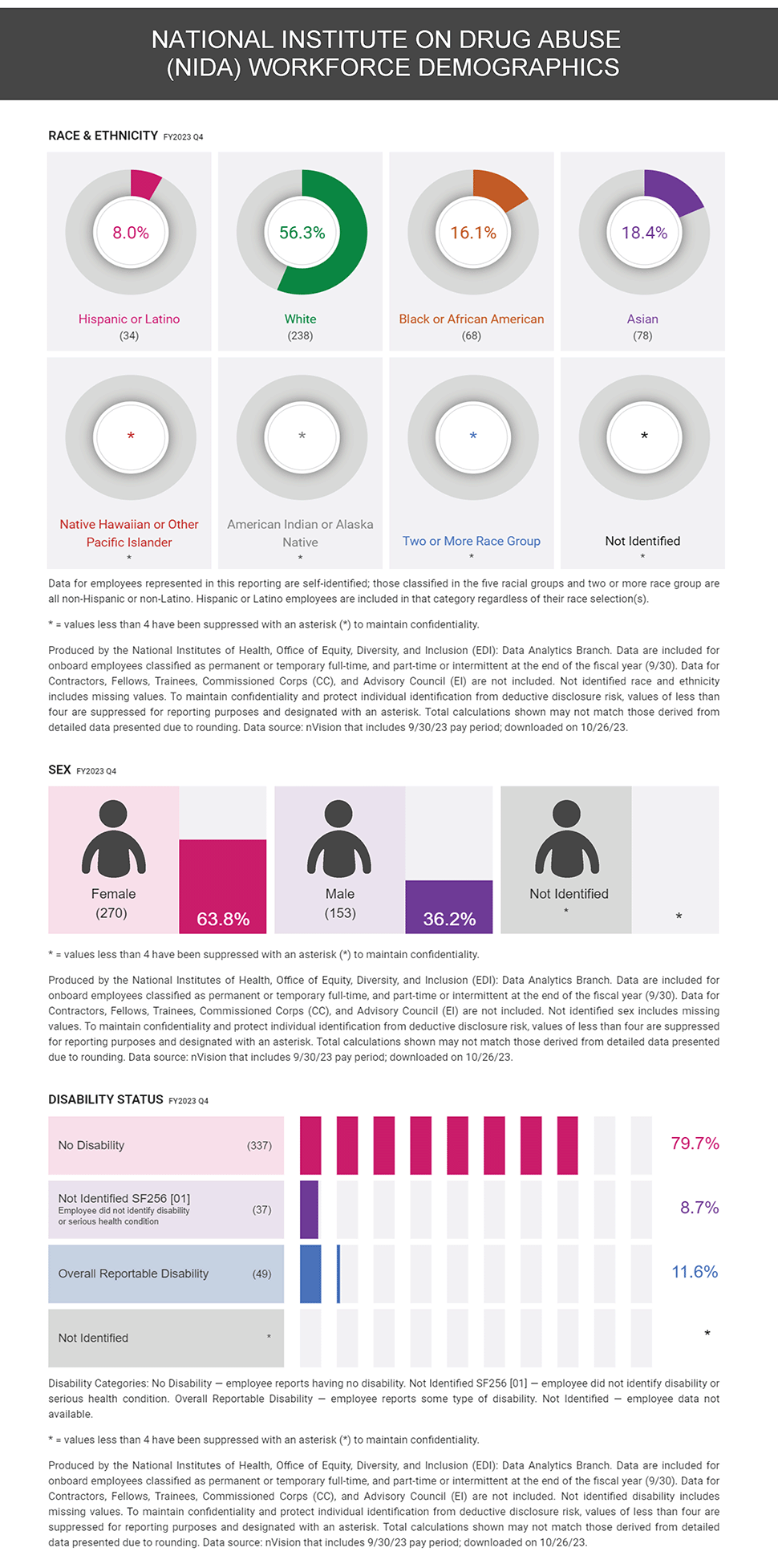
National Institute on Drug Abuse Workforce Demographics
RACE & ETHNICITY: Workforce Demographics by Race and Ethnicity. Graphic showing the proportions of Hispanic or Latino, White, Black or African American, Asian, Native Hawaiian or Other Pacific Islander, American Indian or Alaska Native, Two or More Race Group, and Not Identified NIH employees for Fiscal Year 2023 Fourth Quarter.
RACE & ETHNICITY: Hispanic or Latino = 34, 8.0%; White = 238, 56.3%; Black or African American = 68, 16.1%; Asian = 78, 18.4%; Native Hawaiian or Other Pacific Islander = *, *%; American Indian or Alaska Native = *, *%; Two or More Race Group = *, *%; Not Identified = *, *%
RACE & ETHNICITY: Data for employees represented in this reporting are self-identified; those classified in the five racial groups and two or more race group are all non-Hispanic or non-Latino. Hispanic or Latino employees are included in that category regardless of their race selection(s).
RACE & ETHNICITY: * = values less than 4 have been suppressed with an asterisk (*) to maintain confidentiality.
RACE & ETHNICITY: Produced by the National Institutes of Health, Office of Equity, Diversity, and Inclusion (EDI): Data Analytics Branch. Data are included for onboard employees classified as permanent or temporary full-time, and part-time or intermittent at the end of the fiscal year (9/30). Data for Contractors, Fellows, Trainees, Commissioned Corps (CC), and Advisory Council (EI) are not included. Not identified race and ethnicity includes missing values. To maintain confidentiality and protect individual identification from deductive disclosure risk, values of less than four are suppressed for reporting purposes and designated with an asterisk. Total calculations shown may not match those derived from detailed data presented due to rounding. Data source: nVision that includes 9/30/23 pay period; downloaded on 10/26/23.
SEX: Workforce Demographics by Sex. Graphic showing the proportions of Female, Male, and Not Identified NIH employees for Fiscal Year 2023 Fourth Quarter.
SEX: FEMALE = 270, 63.8%; MALE = 153, 36.2%; Not Identified = *, *%
SEX: * = values less than 4 have been suppressed with an asterisk (*) to maintain confidentiality.
SEX: Produced by the National Institutes of Health, Office of Equity, Diversity, and Inclusion (EDI): Data Analytics Branch. Data are included for onboard employees classified as permanent or temporary full-time, and part-time or intermittent at the end of the fiscal year (9/30). Data for Contractors, Fellows, Trainees, Commissioned Corps (CC), and Advisory Council (EI) are not included. Not identified sex includes missing values. To maintain confidentiality and protect individual identification from deductive disclosure risk, values of less than four are suppressed for reporting purposes and designated with an asterisk. Total calculations shown may not match those derived from detailed data presented due to rounding. Data source: nVision that includes 9/30/23 pay period; downloaded on 10/26/23.
DISABILITY: Workforce Demographics by Disability Status. Graphic showing the proportions of NIH employees having disability status as the following: No Disability, Not Identified SF256 [01] — Employee did not identify disability or serious health condition, Overall Reportable Disability, and Not Identified NIH employees for Fiscal Year 2023 Fourth Quarter.
DISABILITY: No Disability = 337, 79.7%; Not Identified SF256 [01] — Employee did not identify disability or serious health condition = 37, 8.7%; Overall Reportable Disability = 49, 11.6%; Not Identified = *, *%
DISABILITY: Disability Categories: No Disability — employee reports having no disability. Not Identified SF256 [01] — employee did not identify disability or serious health condition. Overall Reportable Disability — employee reports some type of disability. Not Identified — employee data not available.
Produced by the National Institutes of Health, Office of Equity, Diversity, and Inclusion (EDI): Data Analytics Branch. Data are included for onboard employees classified as permanent or temporary full-time, and part-time or intermittent at the end of the fiscal year (9/30). Data for Contractors, Fellows, Trainees, Commissioned Corps (CC), and Advisory Council (EI) are not included. Not identified disability includes missing values. To maintain confidentiality and protect individual identification from deductive disclosure risk, values of less than four are suppressed for reporting purposes and designated with an asterisk. Total calculations shown may not match those derived from detailed data presented due to rounding. Data source: nVision that includes 9/30/23 pay period; downloaded on 10/26/23.
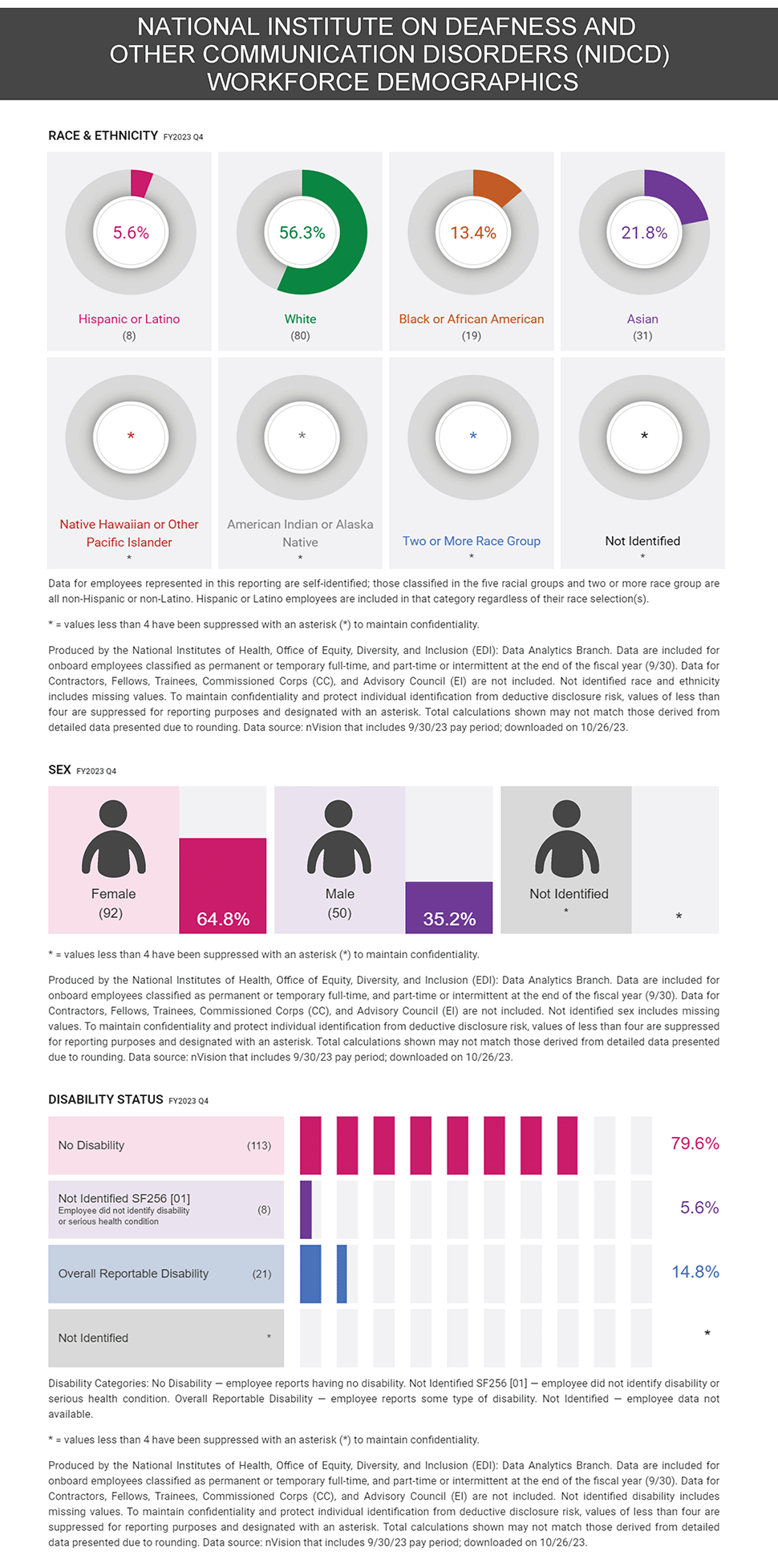
National Institute on Deafness and Other Communication Disorders Workforce Demographics
RACE & ETHNICITY: Workforce Demographics by Race and Ethnicity. Graphic showing the proportions of Hispanic or Latino, White, Black or African American, Asian, Native Hawaiian or Other Pacific Islander, American Indian or Alaska Native, Two or More Race Group, and Not Identified NIH employees for Fiscal Year 2023 Fourth Quarter.
RACE & ETHNICITY: Hispanic or Latino = 8, 5.6%; White = 80, 56.3%; Black or African American = 19, 13.4%; Asian = 31, 21.8%; Native Hawaiian or Other Pacific Islander = *, *%; American Indian or Alaska Native = *, *%; Two or More Race Group = *, *%; Not Identified = *, *%
RACE & ETHNICITY: Data for employees represented in this reporting are self-identified; those classified in the five racial groups and two or more race group are all non-Hispanic or non-Latino. Hispanic or Latino employees are included in that category regardless of their race selection(s).
RACE & ETHNICITY: * = values less than 4 have been suppressed with an asterisk (*) to maintain confidentiality.
RACE & ETHNICITY: Produced by the National Institutes of Health, Office of Equity, Diversity, and Inclusion (EDI): Data Analytics Branch. Data are included for onboard employees classified as permanent or temporary full-time, and part-time or intermittent at the end of the fiscal year (9/30). Data for Contractors, Fellows, Trainees, Commissioned Corps (CC), and Advisory Council (EI) are not included. Not identified race and ethnicity includes missing values. To maintain confidentiality and protect individual identification from deductive disclosure risk, values of less than four are suppressed for reporting purposes and designated with an asterisk. Total calculations shown may not match those derived from detailed data presented due to rounding. Data source: nVision that includes 9/30/23 pay period; downloaded on 10/26/23.
SEX: Workforce Demographics by Sex. Graphic showing the proportions of Female, Male, and Not Identified NIH employees for Fiscal Year 2023 Fourth Quarter.
SEX: FEMALE = 92, 64.8%; MALE = 50, 35.2%; Not Identified = *, *%
SEX: * = values less than 4 have been suppressed with an asterisk (*) to maintain confidentiality.
SEX: Produced by the National Institutes of Health, Office of Equity, Diversity, and Inclusion (EDI): Data Analytics Branch. Data are included for onboard employees classified as permanent or temporary full-time, and part-time or intermittent at the end of the fiscal year (9/30). Data for Contractors, Fellows, Trainees, Commissioned Corps (CC), and Advisory Council (EI) are not included. Not identified sex includes missing values. To maintain confidentiality and protect individual identification from deductive disclosure risk, values of less than four are suppressed for reporting purposes and designated with an asterisk. Total calculations shown may not match those derived from detailed data presented due to rounding. Data source: nVision that includes 9/30/23 pay period; downloaded on 10/26/23.
DISABILITY: Workforce Demographics by Disability Status. Graphic showing the proportions of NIH employees having disability status as the following: No Disability, Not Identified SF256 [01] — Employee did not identify disability or serious health condition, Overall Reportable Disability, and Not Identified NIH employees for Fiscal Year 2023 Fourth Quarter.
DISABILITY: No Disability = 113, 79.6%; Not Identified SF256 [01] — Employee did not identify disability or serious health condition = 8, 5.6%; Overall Reportable Disability = 21, 14.8%; Not Identified = *, *%
DISABILITY: Disability Categories: No Disability — employee reports having no disability. Not Identified SF256 [01] — employee did not identify disability or serious health condition. Overall Reportable Disability — employee reports some type of disability. Not Identified — employee data not available.
Produced by the National Institutes of Health, Office of Equity, Diversity, and Inclusion (EDI): Data Analytics Branch. Data are included for onboard employees classified as permanent or temporary full-time, and part-time or intermittent at the end of the fiscal year (9/30). Data for Contractors, Fellows, Trainees, Commissioned Corps (CC), and Advisory Council (EI) are not included. Not identified disability includes missing values. To maintain confidentiality and protect individual identification from deductive disclosure risk, values of less than four are suppressed for reporting purposes and designated with an asterisk. Total calculations shown may not match those derived from detailed data presented due to rounding. Data source: nVision that includes 9/30/23 pay period; downloaded on 10/26/23.
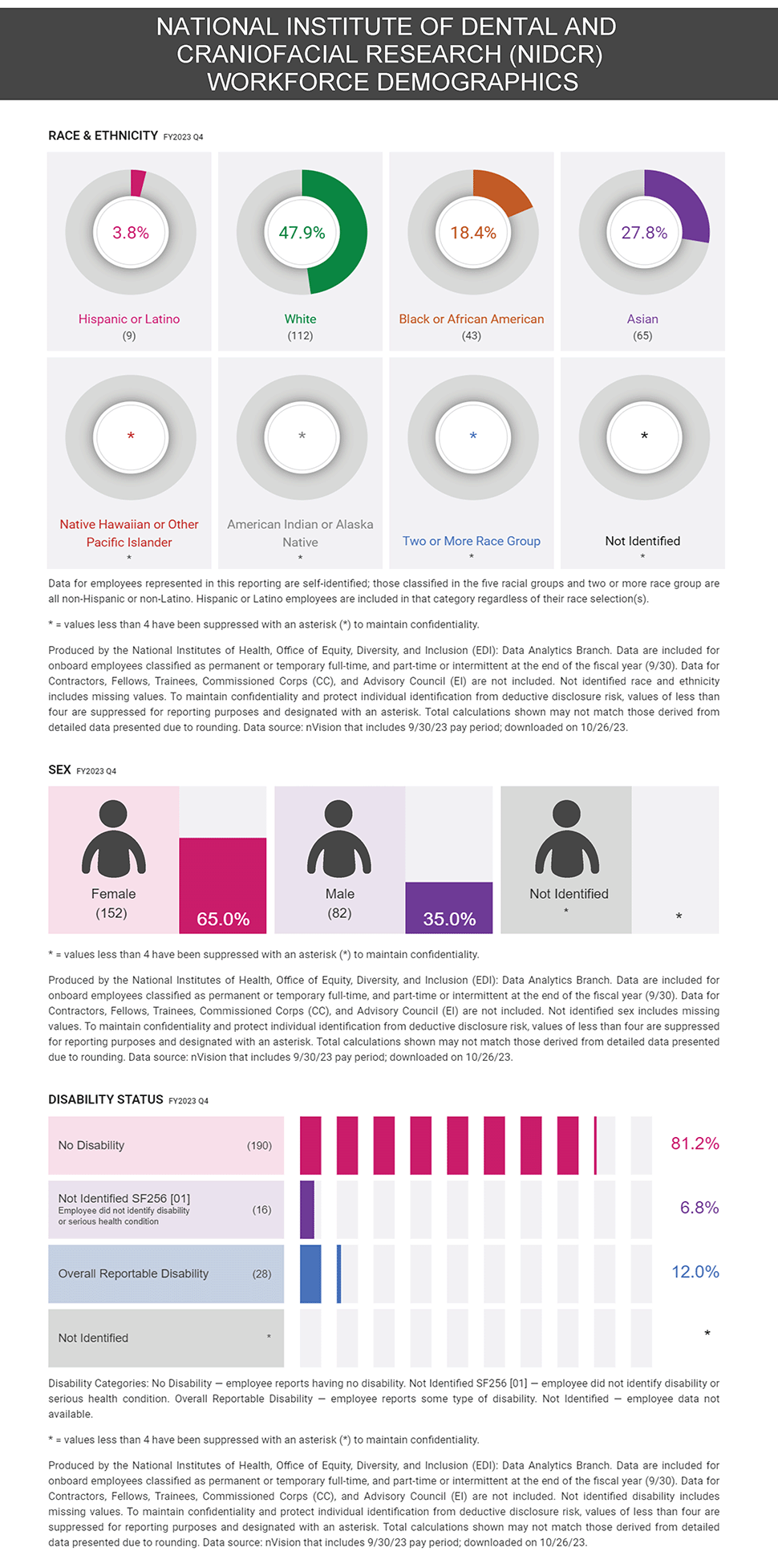
National Institute of Dental and Craniofacial Research Workforce Demographics
RACE & ETHNICITY: Workforce Demographics by Race and Ethnicity. Graphic showing the proportions of Hispanic or Latino, White, Black or African American, Asian, Native Hawaiian or Other Pacific Islander, American Indian or Alaska Native, Two or More Race Group, and Not Identified NIH employees for Fiscal Year 2023 Fourth Quarter.
RACE & ETHNICITY: Hispanic or Latino = 9, 3.8%; White = 112, 47.9%; Black or African American = 43, 18.4%; Asian = 65, 27.8%; Native Hawaiian or Other Pacific Islander = *, *%; American Indian or Alaska Native = *, *%; Two or More Race Group = *, *%; Not Identified = *, *%
RACE & ETHNICITY: Data for employees represented in this reporting are self-identified; those classified in the five racial groups and two or more race group are all non-Hispanic or non-Latino. Hispanic or Latino employees are included in that category regardless of their race selection(s).
RACE & ETHNICITY: * = values less than 4 have been suppressed with an asterisk (*) to maintain confidentiality.
RACE & ETHNICITY: Produced by the National Institutes of Health, Office of Equity, Diversity, and Inclusion (EDI): Data Analytics Branch. Data are included for onboard employees classified as permanent or temporary full-time, and part-time or intermittent at the end of the fiscal year (9/30). Data for Contractors, Fellows, Trainees, Commissioned Corps (CC), and Advisory Council (EI) are not included. Not identified race and ethnicity includes missing values. To maintain confidentiality and protect individual identification from deductive disclosure risk, values of less than four are suppressed for reporting purposes and designated with an asterisk. Total calculations shown may not match those derived from detailed data presented due to rounding. Data source: nVision that includes 9/30/23 pay period; downloaded on 10/26/23.
SEX: Workforce Demographics by Sex. Graphic showing the proportions of Female, Male, and Not Identified NIH employees for Fiscal Year 2023 Fourth Quarter.
SEX: FEMALE = 152, 65.0%; MALE = 82, 35.0%; Not Identified = *, *%
SEX: * = values less than 4 have been suppressed with an asterisk (*) to maintain confidentiality.
SEX: Produced by the National Institutes of Health, Office of Equity, Diversity, and Inclusion (EDI): Data Analytics Branch. Data are included for onboard employees classified as permanent or temporary full-time, and part-time or intermittent at the end of the fiscal year (9/30). Data for Contractors, Fellows, Trainees, Commissioned Corps (CC), and Advisory Council (EI) are not included. Not identified sex includes missing values. To maintain confidentiality and protect individual identification from deductive disclosure risk, values of less than four are suppressed for reporting purposes and designated with an asterisk. Total calculations shown may not match those derived from detailed data presented due to rounding. Data source: nVision that includes 9/30/23 pay period; downloaded on 10/26/23.
DISABILITY: Workforce Demographics by Disability Status. Graphic showing the proportions of NIH employees having disability status as the following: No Disability, Not Identified SF256 [01] — Employee did not identify disability or serious health condition, Overall Reportable Disability, and Not Identified NIH employees for Fiscal Year 2023 Fourth Quarter.
DISABILITY: No Disability = 190, 81.2%; Not Identified SF256 [01] — Employee did not identify disability or serious health condition = 16, 6.8%; Overall Reportable Disability = 28, 12.0%; Not Identified = *, *%
DISABILITY: Disability Categories: No Disability — employee reports having no disability. Not Identified SF256 [01] — employee did not identify disability or serious health condition. Overall Reportable Disability — employee reports some type of disability. Not Identified — employee data not available.
Produced by the National Institutes of Health, Office of Equity, Diversity, and Inclusion (EDI): Data Analytics Branch. Data are included for onboard employees classified as permanent or temporary full-time, and part-time or intermittent at the end of the fiscal year (9/30). Data for Contractors, Fellows, Trainees, Commissioned Corps (CC), and Advisory Council (EI) are not included. Not identified disability includes missing values. To maintain confidentiality and protect individual identification from deductive disclosure risk, values of less than four are suppressed for reporting purposes and designated with an asterisk. Total calculations shown may not match those derived from detailed data presented due to rounding. Data source: nVision that includes 9/30/23 pay period; downloaded on 10/26/23.
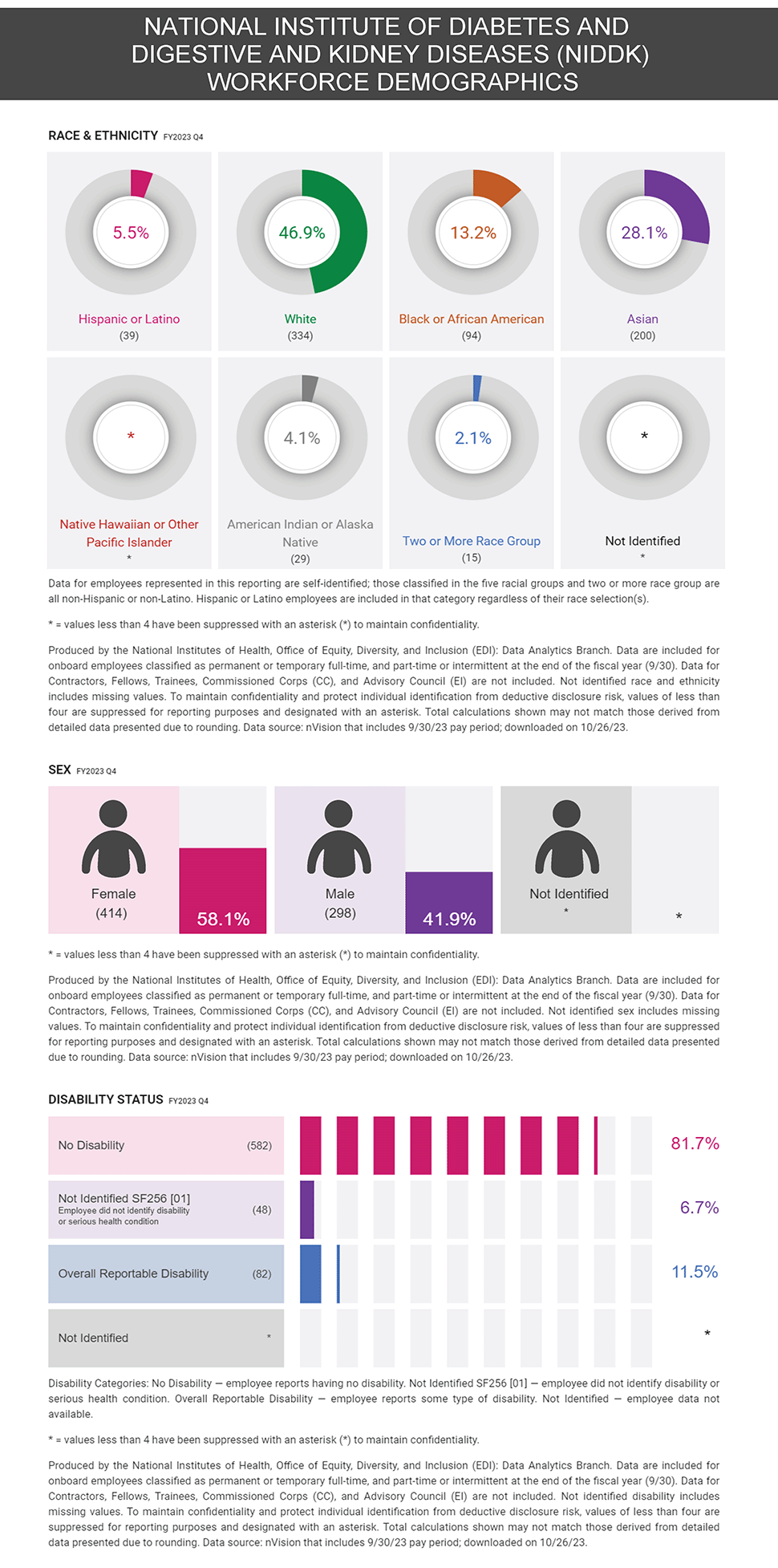
National Institute of Diabetes and Digestive and Kidney Diseases Workforce Demographics
RACE & ETHNICITY: Workforce Demographics by Race and Ethnicity. Graphic showing the proportions of Hispanic or Latino, White, Black or African American, Asian, Native Hawaiian or Other Pacific Islander, American Indian or Alaska Native, Two or More Race Group, and Not Identified NIH employees for Fiscal Year 2023 Fourth Quarter.
RACE & ETHNICITY: Hispanic or Latino = 39, 5.5%; White = 334, 46.9%; Black or African American = 94, 13.2%; Asian = 200, 28.1%; Native Hawaiian or Other Pacific Islander = *, *%; American Indian or Alaska Native = 29, 4.1%; Two or More Race Group = 15, 2.1%; Not Identified = *, *%
RACE & ETHNICITY: Data for employees represented in this reporting are self-identified; those classified in the five racial groups and two or more race group are all non-Hispanic or non-Latino. Hispanic or Latino employees are included in that category regardless of their race selection(s).
RACE & ETHNICITY: * = values less than 4 have been suppressed with an asterisk (*) to maintain confidentiality.
RACE & ETHNICITY: Produced by the National Institutes of Health, Office of Equity, Diversity, and Inclusion (EDI): Data Analytics Branch. Data are included for onboard employees classified as permanent or temporary full-time, and part-time or intermittent at the end of the fiscal year (9/30). Data for Contractors, Fellows, Trainees, Commissioned Corps (CC), and Advisory Council (EI) are not included. Not identified race and ethnicity includes missing values. To maintain confidentiality and protect individual identification from deductive disclosure risk, values of less than four are suppressed for reporting purposes and designated with an asterisk. Total calculations shown may not match those derived from detailed data presented due to rounding. Data source: nVision that includes 9/30/23 pay period; downloaded on 10/26/23.
SEX: Workforce Demographics by Sex. Graphic showing the proportions of Female, Male, and Not Identified NIH employees for Fiscal Year 2023 Fourth Quarter.
SEX: FEMALE = 414, 58.1%; MALE = 298, 41.9%; Not Identified = *, *%
SEX: * = values less than 4 have been suppressed with an asterisk (*) to maintain confidentiality.
SEX: Produced by the National Institutes of Health, Office of Equity, Diversity, and Inclusion (EDI): Data Analytics Branch. Data are included for onboard employees classified as permanent or temporary full-time, and part-time or intermittent at the end of the fiscal year (9/30). Data for Contractors, Fellows, Trainees, Commissioned Corps (CC), and Advisory Council (EI) are not included. Not identified sex includes missing values. To maintain confidentiality and protect individual identification from deductive disclosure risk, values of less than four are suppressed for reporting purposes and designated with an asterisk. Total calculations shown may not match those derived from detailed data presented due to rounding. Data source: nVision that includes 9/30/23 pay period; downloaded on 10/26/23.
DISABILITY: Workforce Demographics by Disability Status. Graphic showing the proportions of NIH employees having disability status as the following: No Disability, Not Identified SF256 [01] — Employee did not identify disability or serious health condition, Overall Reportable Disability, and Not Identified NIH employees for Fiscal Year 2023 Fourth Quarter.
DISABILITY: No Disability = 582, 81.7%; Not Identified SF256 [01] — Employee did not identify disability or serious health condition = 48, 6.7%; Overall Reportable Disability = 82, 11.5%; Not Identified = *, *%
DISABILITY: Disability Categories: No Disability — employee reports having no disability. Not Identified SF256 [01] — employee did not identify disability or serious health condition. Overall Reportable Disability — employee reports some type of disability. Not Identified — employee data not available.
Produced by the National Institutes of Health, Office of Equity, Diversity, and Inclusion (EDI): Data Analytics Branch. Data are included for onboard employees classified as permanent or temporary full-time, and part-time or intermittent at the end of the fiscal year (9/30). Data for Contractors, Fellows, Trainees, Commissioned Corps (CC), and Advisory Council (EI) are not included. Not identified disability includes missing values. To maintain confidentiality and protect individual identification from deductive disclosure risk, values of less than four are suppressed for reporting purposes and designated with an asterisk. Total calculations shown may not match those derived from detailed data presented due to rounding. Data source: nVision that includes 9/30/23 pay period; downloaded on 10/26/23.
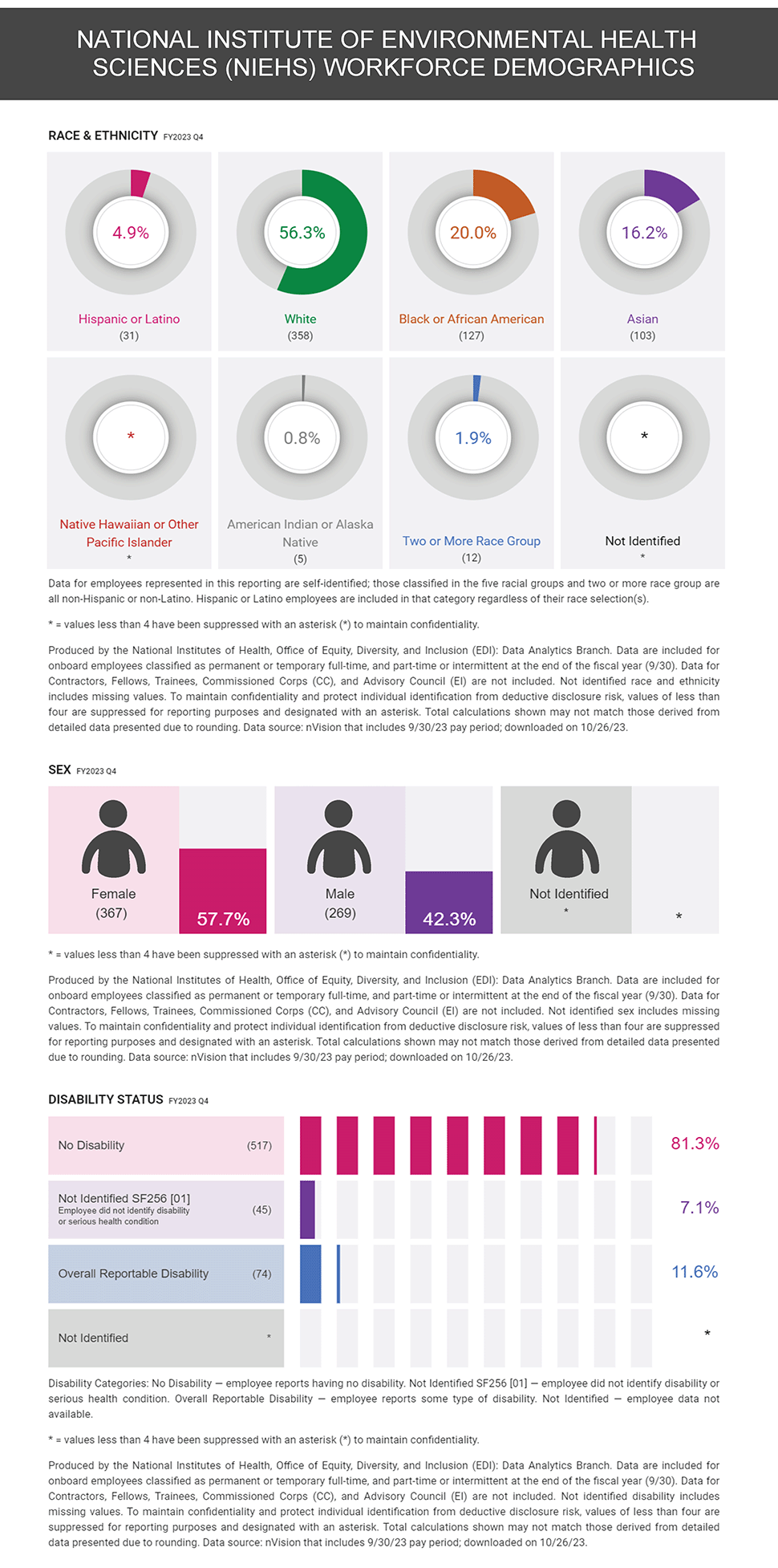
National Institute of Environmental Health Sciences Workforce Demographics
RACE & ETHNICITY: Workforce Demographics by Race and Ethnicity. Graphic showing the proportions of Hispanic or Latino, White, Black or African American, Asian, Native Hawaiian or Other Pacific Islander, American Indian or Alaska Native, Two or More Race Group, and Not Identified NIH employees for Fiscal Year 2023 Fourth Quarter.
RACE & ETHNICITY: Hispanic or Latino = 31, 4.9%; White = 358, 56.3%; Black or African American = 127, 20.0%; Asian = 103, 16.2%; Native Hawaiian or Other Pacific Islander = *, *%; American Indian or Alaska Native = 5, 0.8%; Two or More Race Group = 12, 1.9%; Not Identified = *, *%
RACE & ETHNICITY: Data for employees represented in this reporting are self-identified; those classified in the five racial groups and two or more race group are all non-Hispanic or non-Latino. Hispanic or Latino employees are included in that category regardless of their race selection(s).
RACE & ETHNICITY: * = values less than 4 have been suppressed with an asterisk (*) to maintain confidentiality.
RACE & ETHNICITY: Produced by the National Institutes of Health, Office of Equity, Diversity, and Inclusion (EDI): Data Analytics Branch. Data are included for onboard employees classified as permanent or temporary full-time, and part-time or intermittent at the end of the fiscal year (9/30). Data for Contractors, Fellows, Trainees, Commissioned Corps (CC), and Advisory Council (EI) are not included. Not identified race and ethnicity includes missing values. To maintain confidentiality and protect individual identification from deductive disclosure risk, values of less than four are suppressed for reporting purposes and designated with an asterisk. Total calculations shown may not match those derived from detailed data presented due to rounding. Data source: nVision that includes 9/30/23 pay period; downloaded on 10/26/23.
SEX: Workforce Demographics by Sex. Graphic showing the proportions of Female, Male, and Not Identified NIH employees for Fiscal Year 2023 Fourth Quarter.
SEX: FEMALE = 367, 57.7%; MALE = 269, 42.3%; Not Identified = *, *%
SEX: * = values less than 4 have been suppressed with an asterisk (*) to maintain confidentiality.
SEX: Produced by the National Institutes of Health, Office of Equity, Diversity, and Inclusion (EDI): Data Analytics Branch. Data are included for onboard employees classified as permanent or temporary full-time, and part-time or intermittent at the end of the fiscal year (9/30). Data for Contractors, Fellows, Trainees, Commissioned Corps (CC), and Advisory Council (EI) are not included. Not identified sex includes missing values. To maintain confidentiality and protect individual identification from deductive disclosure risk, values of less than four are suppressed for reporting purposes and designated with an asterisk. Total calculations shown may not match those derived from detailed data presented due to rounding. Data source: nVision that includes 9/30/23 pay period; downloaded on 10/26/23.
DISABILITY: Workforce Demographics by Disability Status. Graphic showing the proportions of NIH employees having disability status as the following: No Disability, Not Identified SF256 [01] — Employee did not identify disability or serious health condition, Overall Reportable Disability, and Not Identified NIH employees for Fiscal Year 2023 Fourth Quarter.
DISABILITY: No Disability = 517, 81.3%; Not Identified SF256 [01] — Employee did not identify disability or serious health condition = 45, 7.1%; Overall Reportable Disability = 74, 11.6%; Not Identified = *, *%
DISABILITY: Disability Categories: No Disability — employee reports having no disability. Not Identified SF256 [01] — employee did not identify disability or serious health condition. Overall Reportable Disability — employee reports some type of disability. Not Identified — employee data not available.
Produced by the National Institutes of Health, Office of Equity, Diversity, and Inclusion (EDI): Data Analytics Branch. Data are included for onboard employees classified as permanent or temporary full-time, and part-time or intermittent at the end of the fiscal year (9/30). Data for Contractors, Fellows, Trainees, Commissioned Corps (CC), and Advisory Council (EI) are not included. Not identified disability includes missing values. To maintain confidentiality and protect individual identification from deductive disclosure risk, values of less than four are suppressed for reporting purposes and designated with an asterisk. Total calculations shown may not match those derived from detailed data presented due to rounding. Data source: nVision that includes 9/30/23 pay period; downloaded on 10/26/23.
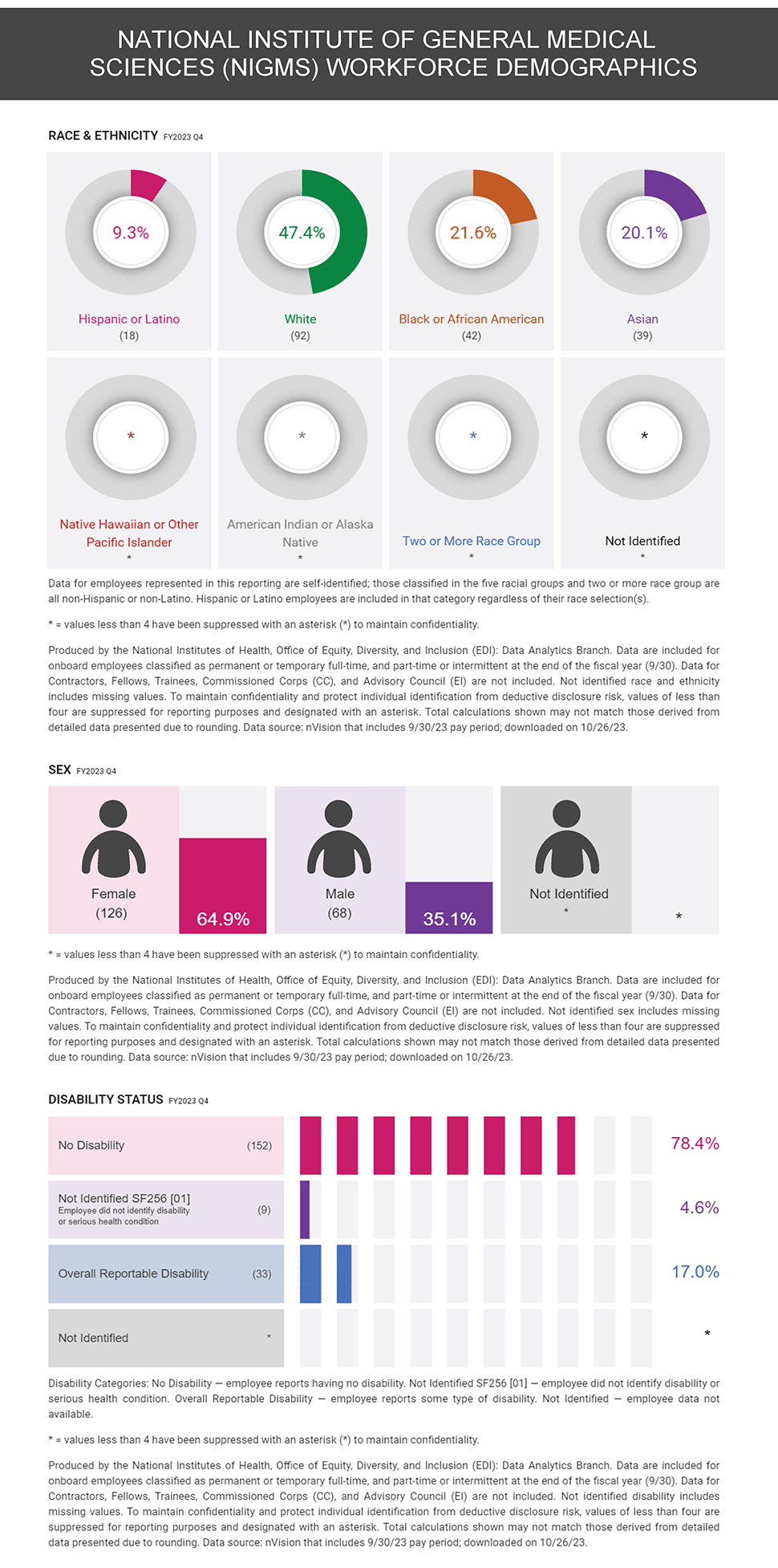
National Institute of General Medical Sciences Workforce Demographics
RACE & ETHNICITY: Workforce Demographics by Race and Ethnicity. Graphic showing the proportions of Hispanic or Latino, White, Black or African American, Asian, Native Hawaiian or Other Pacific Islander, American Indian or Alaska Native, Two or More Race Group, and Not Identified NIH employees for Fiscal Year 2023 Fourth Quarter.
RACE & ETHNICITY: Hispanic or Latino = 18, 9.3%; White = 92, 47.4%; Black or African American = 42, 21.6%; Asian = 39, 20.1%; Native Hawaiian or Other Pacific Islander = *, *%; American Indian or Alaska Native = *, *%; Two or More Race Group = *, *%; Not Identified = *, *%
RACE & ETHNICITY: Data for employees represented in this reporting are self-identified; those classified in the five racial groups and two or more race group are all non-Hispanic or non-Latino. Hispanic or Latino employees are included in that category regardless of their race selection(s).
RACE & ETHNICITY: * = values less than 4 have been suppressed with an asterisk (*) to maintain confidentiality.
RACE & ETHNICITY: Produced by the National Institutes of Health, Office of Equity, Diversity, and Inclusion (EDI): Data Analytics Branch. Data are included for onboard employees classified as permanent or temporary full-time, and part-time or intermittent at the end of the fiscal year (9/30). Data for Contractors, Fellows, Trainees, Commissioned Corps (CC), and Advisory Council (EI) are not included. Not identified race and ethnicity includes missing values. To maintain confidentiality and protect individual identification from deductive disclosure risk, values of less than four are suppressed for reporting purposes and designated with an asterisk. Total calculations shown may not match those derived from detailed data presented due to rounding. Data source: nVision that includes 9/30/23 pay period; downloaded on 10/26/23.
SEX: Workforce Demographics by Sex. Graphic showing the proportions of Female, Male, and Not Identified NIH employees for Fiscal Year 2023 Fourth Quarter.
SEX: FEMALE = 126, 64.9%; MALE = 68, 35.1%; Not Identified = *, *%
SEX: * = values less than 4 have been suppressed with an asterisk (*) to maintain confidentiality.
SEX: Produced by the National Institutes of Health, Office of Equity, Diversity, and Inclusion (EDI): Data Analytics Branch. Data are included for onboard employees classified as permanent or temporary full-time, and part-time or intermittent at the end of the fiscal year (9/30). Data for Contractors, Fellows, Trainees, Commissioned Corps (CC), and Advisory Council (EI) are not included. Not identified sex includes missing values. To maintain confidentiality and protect individual identification from deductive disclosure risk, values of less than four are suppressed for reporting purposes and designated with an asterisk. Total calculations shown may not match those derived from detailed data presented due to rounding. Data source: nVision that includes 9/30/23 pay period; downloaded on 10/26/23.
DISABILITY: Workforce Demographics by Disability Status. Graphic showing the proportions of NIH employees having disability status as the following: No Disability, Not Identified SF256 [01] — Employee did not identify disability or serious health condition, Overall Reportable Disability, and Not Identified NIH employees for Fiscal Year 2023 Fourth Quarter.
DISABILITY: No Disability = 152, 78.4%; Not Identified SF256 [01] — Employee did not identify disability or serious health condition = 9, 4.6%; Overall Reportable Disability = 33, 17.0%; Not Identified = *, *%
DISABILITY: Disability Categories: No Disability — employee reports having no disability. Not Identified SF256 [01] — employee did not identify disability or serious health condition. Overall Reportable Disability — employee reports some type of disability. Not Identified — employee data not available.
Produced by the National Institutes of Health, Office of Equity, Diversity, and Inclusion (EDI): Data Analytics Branch. Data are included for onboard employees classified as permanent or temporary full-time, and part-time or intermittent at the end of the fiscal year (9/30). Data for Contractors, Fellows, Trainees, Commissioned Corps (CC), and Advisory Council (EI) are not included. Not identified disability includes missing values. To maintain confidentiality and protect individual identification from deductive disclosure risk, values of less than four are suppressed for reporting purposes and designated with an asterisk. Total calculations shown may not match those derived from detailed data presented due to rounding. Data source: nVision that includes 9/30/23 pay period; downloaded on 10/26/23.
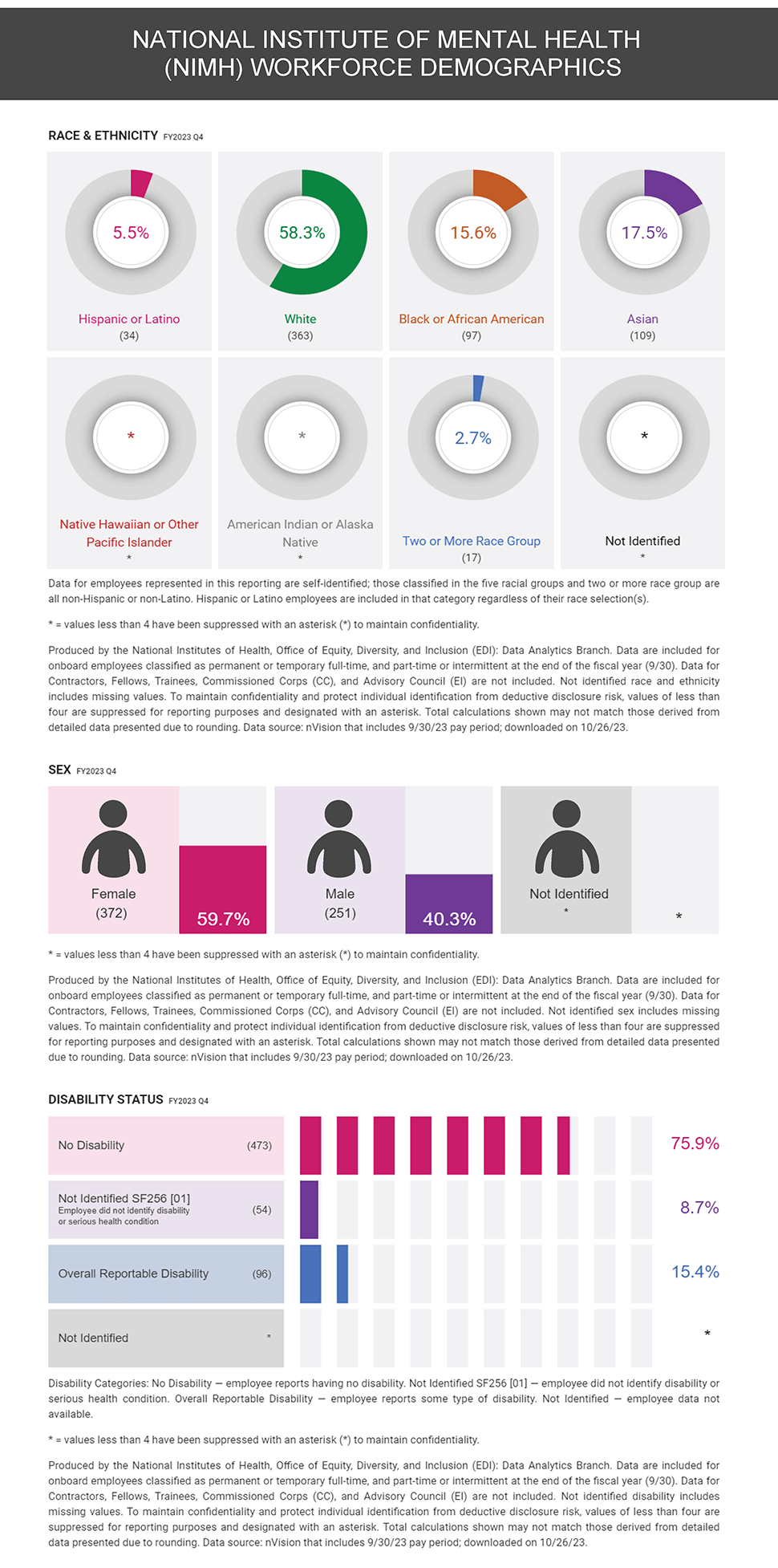
National Institute of Mental Health Workforce Demographics
RACE & ETHNICITY: Workforce Demographics by Race and Ethnicity. Graphic showing the proportions of Hispanic or Latino, White, Black or African American, Asian, Native Hawaiian or Other Pacific Islander, American Indian or Alaska Native, Two or More Race Group, and Not Identified NIH employees for Fiscal Year 2023 Fourth Quarter.
RACE & ETHNICITY: Hispanic or Latino = 12, 12.2%; White = 28, 28.6%; Black or African American = 36, 36.7%; Asian = 17, 17.3%; Native Hawaiian or Other Pacific Islander = *, *%; American Indian or Alaska Native = *, *%; Two or More Race Group = 4, 4.1%; Not Identified = *, *%
RACE & ETHNICITY: Data for employees represented in this reporting are self-identified; those classified in the five racial groups and two or more race group are all non-Hispanic or non-Latino. Hispanic or Latino employees are included in that category regardless of their race selection(s).
RACE & ETHNICITY: * = values less than 4 have been suppressed with an asterisk (*) to maintain confidentiality.
RACE & ETHNICITY: Produced by the National Institutes of Health, Office of Equity, Diversity, and Inclusion (EDI): Data Analytics Branch. Data are included for onboard employees classified as permanent or temporary full-time, and part-time or intermittent at the end of the fiscal year (9/30). Data for Contractors, Fellows, Trainees, Commissioned Corps (CC), and Advisory Council (EI) are not included. Not identified race and ethnicity includes missing values. To maintain confidentiality and protect individual identification from deductive disclosure risk, values of less than four are suppressed for reporting purposes and designated with an asterisk. Total calculations shown may not match those derived from detailed data presented due to rounding. Data source: nVision that includes 9/30/23 pay period; downloaded on 10/26/23.
SEX: Workforce Demographics by Sex. Graphic showing the proportions of Female, Male, and Not Identified NIH employees for Fiscal Year 2023 Fourth Quarter.
SEX: FEMALE = 71, 72.4%; MALE = 27, 27.6%; Not Identified = *, *%
SEX: * = values less than 4 have been suppressed with an asterisk (*) to maintain confidentiality.
SEX: Produced by the National Institutes of Health, Office of Equity, Diversity, and Inclusion (EDI): Data Analytics Branch. Data are included for onboard employees classified as permanent or temporary full-time, and part-time or intermittent at the end of the fiscal year (9/30). Data for Contractors, Fellows, Trainees, Commissioned Corps (CC), and Advisory Council (EI) are not included. Not identified sex includes missing values. To maintain confidentiality and protect individual identification from deductive disclosure risk, values of less than four are suppressed for reporting purposes and designated with an asterisk. Total calculations shown may not match those derived from detailed data presented due to rounding. Data source: nVision that includes 9/30/23 pay period; downloaded on 10/26/23.
DISABILITY: Workforce Demographics by Disability Status. Graphic showing the proportions of NIH employees having disability status as the following: No Disability, Not Identified SF256 [01] — Employee did not identify disability or serious health condition, Overall Reportable Disability, and Not Identified NIH employees for Fiscal Year 2023 Fourth Quarter.
DISABILITY: No Disability = 78, 79.6%; Not Identified SF256 [01] — Employee did not identify disability or serious health condition = 7, 7.1%; Overall Reportable Disability = 13, 13.3%; Not Identified = *, *%
DISABILITY: Disability Categories: No Disability — employee reports having no disability. Not Identified SF256 [01] — employee did not identify disability or serious health condition. Overall Reportable Disability — employee reports some type of disability. Not Identified — employee data not available.
Produced by the National Institutes of Health, Office of Equity, Diversity, and Inclusion (EDI): Data Analytics Branch. Data are included for onboard employees classified as permanent or temporary full-time, and part-time or intermittent at the end of the fiscal year (9/30). Data for Contractors, Fellows, Trainees, Commissioned Corps (CC), and Advisory Council (EI) are not included. Not identified disability includes missing values. To maintain confidentiality and protect individual identification from deductive disclosure risk, values of less than four are suppressed for reporting purposes and designated with an asterisk. Total calculations shown may not match those derived from detailed data presented due to rounding. Data source: nVision that includes 9/30/23 pay period; downloaded on 10/26/23.
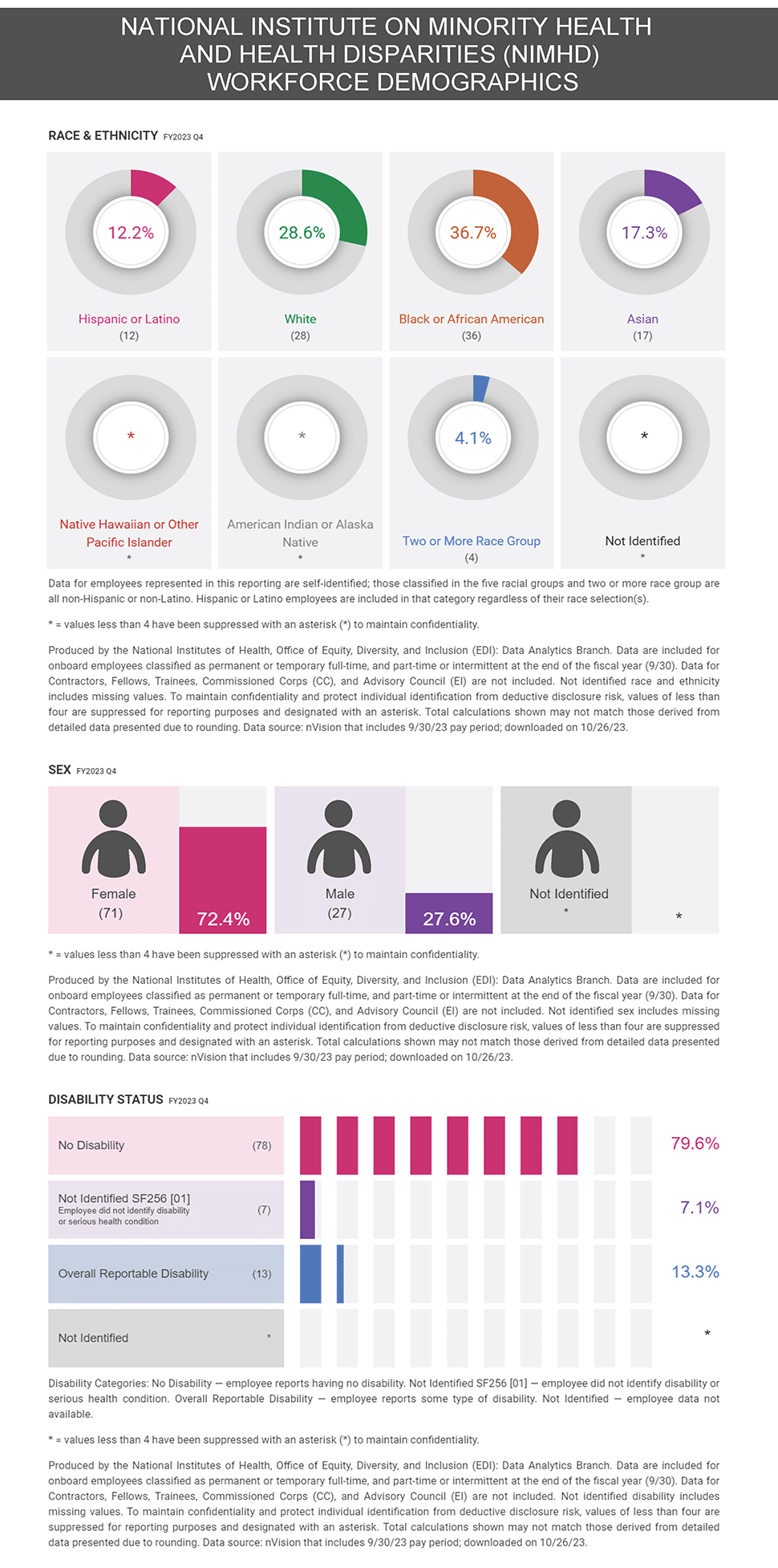
National Institute on Minority Health and Health Disparities Workforce Demographics
RACE & ETHNICITY: Workforce Demographics by Race and Ethnicity. Graphic showing the proportions of Hispanic or Latino, White, Black or African American, Asian, Native Hawaiian or Other Pacific Islander, American Indian or Alaska Native, Two or More Race Group, and Not Identified NIH employees for Fiscal Year 2023 Fourth Quarter.
RACE & ETHNICITY: Hispanic or Latino = 34, 5.5%; White = 363, 58.3%; Black or African American = 97, 15.6%; Asian = 109, 17.5%; Native Hawaiian or Other Pacific Islander = *, *%; American Indian or Alaska Native = *, *%; Two or More Race Group = 17, 2.7%; Not Identified = *, *%
RACE & ETHNICITY: Data for employees represented in this reporting are self-identified; those classified in the five racial groups and two or more race group are all non-Hispanic or non-Latino. Hispanic or Latino employees are included in that category regardless of their race selection(s).
RACE & ETHNICITY: * = values less than 4 have been suppressed with an asterisk (*) to maintain confidentiality.
RACE & ETHNICITY: Produced by the National Institutes of Health, Office of Equity, Diversity, and Inclusion (EDI): Data Analytics Branch. Data are included for onboard employees classified as permanent or temporary full-time, and part-time or intermittent at the end of the fiscal year (9/30). Data for Contractors, Fellows, Trainees, Commissioned Corps (CC), and Advisory Council (EI) are not included. Not identified race and ethnicity includes missing values. To maintain confidentiality and protect individual identification from deductive disclosure risk, values of less than four are suppressed for reporting purposes and designated with an asterisk. Total calculations shown may not match those derived from detailed data presented due to rounding. Data source: nVision that includes 9/30/23 pay period; downloaded on 10/26/23.
SEX: Workforce Demographics by Sex. Graphic showing the proportions of Female, Male, and Not Identified NIH employees for Fiscal Year 2023 Fourth Quarter.
SEX: FEMALE = 372, 59.7%; MALE = 251, 40.3%; Not Identified = *, *%
SEX: * = values less than 4 have been suppressed with an asterisk (*) to maintain confidentiality.
SEX: Produced by the National Institutes of Health, Office of Equity, Diversity, and Inclusion (EDI): Data Analytics Branch. Data are included for onboard employees classified as permanent or temporary full-time, and part-time or intermittent at the end of the fiscal year (9/30). Data for Contractors, Fellows, Trainees, Commissioned Corps (CC), and Advisory Council (EI) are not included. Not identified sex includes missing values. To maintain confidentiality and protect individual identification from deductive disclosure risk, values of less than four are suppressed for reporting purposes and designated with an asterisk. Total calculations shown may not match those derived from detailed data presented due to rounding. Data source: nVision that includes 9/30/23 pay period; downloaded on 10/26/23.
DISABILITY: Workforce Demographics by Disability Status. Graphic showing the proportions of NIH employees having disability status as the following: No Disability, Not Identified SF256 [01] — Employee did not identify disability or serious health condition, Overall Reportable Disability, and Not Identified NIH employees for Fiscal Year 2023 Fourth Quarter.
DISABILITY: No Disability = 473, 75.9%; Not Identified SF256 [01] — Employee did not identify disability or serious health condition = 54, 8.7%; Overall Reportable Disability = 96, 15.4%; Not Identified = *, *%
DISABILITY: Disability Categories: No Disability — employee reports having no disability. Not Identified SF256 [01] — employee did not identify disability or serious health condition. Overall Reportable Disability — employee reports some type of disability. Not Identified — employee data not available.
Produced by the National Institutes of Health, Office of Equity, Diversity, and Inclusion (EDI): Data Analytics Branch. Data are included for onboard employees classified as permanent or temporary full-time, and part-time or intermittent at the end of the fiscal year (9/30). Data for Contractors, Fellows, Trainees, Commissioned Corps (CC), and Advisory Council (EI) are not included. Not identified disability includes missing values. To maintain confidentiality and protect individual identification from deductive disclosure risk, values of less than four are suppressed for reporting purposes and designated with an asterisk. Total calculations shown may not match those derived from detailed data presented due to rounding. Data source: nVision that includes 9/30/23 pay period; downloaded on 10/26/23.
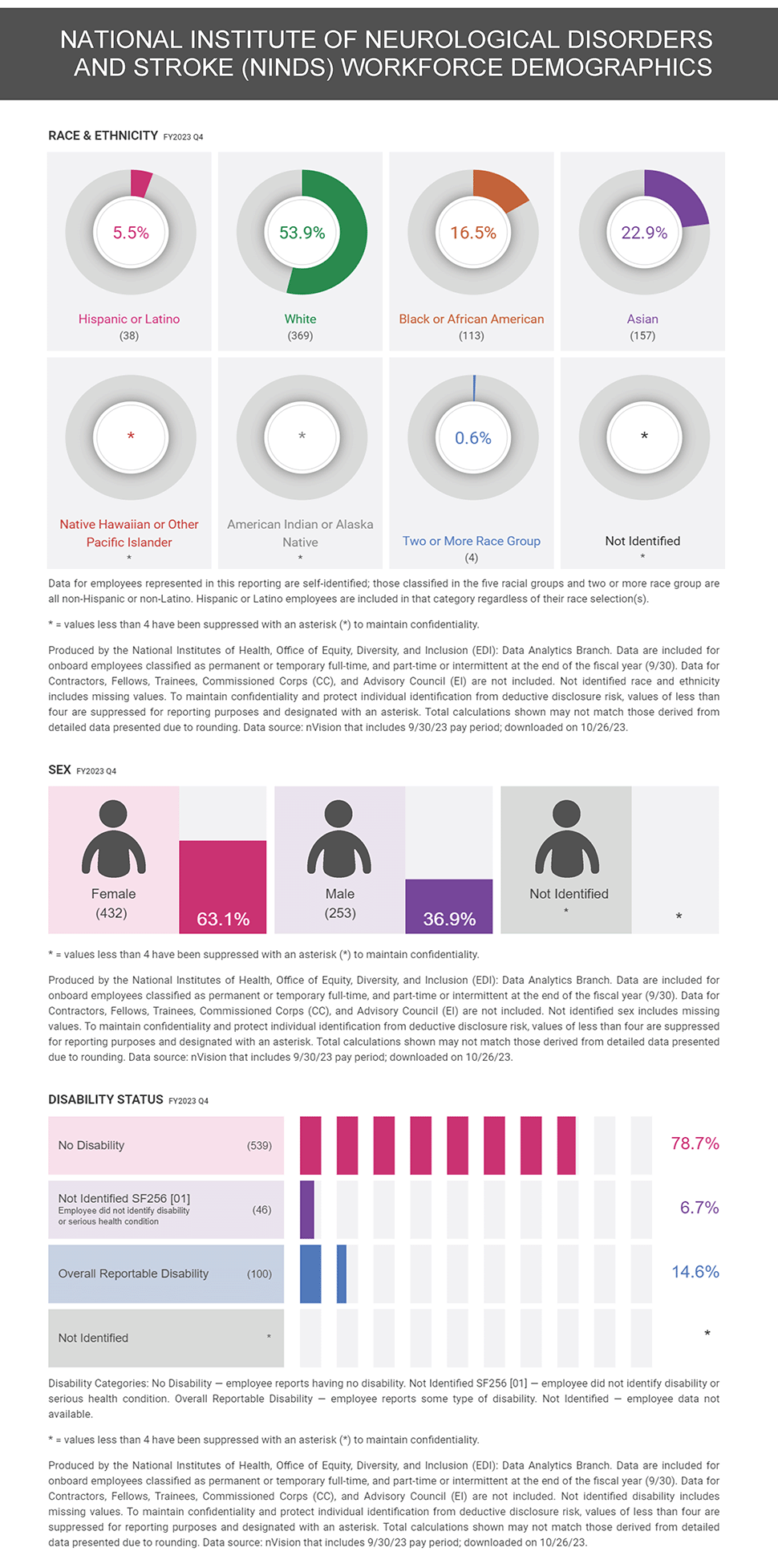
National Institute of Neurological Disorders and Stroke Workforce Demographics
RACE & ETHNICITY: Workforce Demographics by Race and Ethnicity. Graphic showing the proportions of Hispanic or Latino, White, Black or African American, Asian, Native Hawaiian or Other Pacific Islander, American Indian or Alaska Native, Two or More Race Group, and Not Identified NIH employees for Fiscal Year 2023 Fourth Quarter.
RACE & ETHNICITY: Hispanic or Latino = 38, 5.5%; White = 369, 53.9%; Black or African American = 113, 16.5%; Asian = 157, 22.9%; Native Hawaiian or Other Pacific Islander = *, *%; American Indian or Alaska Native = *, *%; Two or More Race Group = 4, 0.6%; Not Identified = *, *%
RACE & ETHNICITY: Data for employees represented in this reporting are self-identified; those classified in the five racial groups and two or more race group are all non-Hispanic or non-Latino. Hispanic or Latino employees are included in that category regardless of their race selection(s).
RACE & ETHNICITY: * = values less than 4 have been suppressed with an asterisk (*) to maintain confidentiality.
RACE & ETHNICITY: Produced by the National Institutes of Health, Office of Equity, Diversity, and Inclusion (EDI): Data Analytics Branch. Data are included for onboard employees classified as permanent or temporary full-time, and part-time or intermittent at the end of the fiscal year (9/30). Data for Contractors, Fellows, Trainees, Commissioned Corps (CC), and Advisory Council (EI) are not included. Not identified race and ethnicity includes missing values. To maintain confidentiality and protect individual identification from deductive disclosure risk, values of less than four are suppressed for reporting purposes and designated with an asterisk. Total calculations shown may not match those derived from detailed data presented due to rounding. Data source: nVision that includes 9/30/23 pay period; downloaded on 10/26/23.
SEX: Workforce Demographics by Sex. Graphic showing the proportions of Female, Male, and Not Identified NIH employees for Fiscal Year 2023 Fourth Quarter.
SEX: FEMALE = 432, 63.1%; MALE = 253, 36.9%; Not Identified = *, *%
SEX: * = values less than 4 have been suppressed with an asterisk (*) to maintain confidentiality.
SEX: Produced by the National Institutes of Health, Office of Equity, Diversity, and Inclusion (EDI): Data Analytics Branch. Data are included for onboard employees classified as permanent or temporary full-time, and part-time or intermittent at the end of the fiscal year (9/30). Data for Contractors, Fellows, Trainees, Commissioned Corps (CC), and Advisory Council (EI) are not included. Not identified sex includes missing values. To maintain confidentiality and protect individual identification from deductive disclosure risk, values of less than four are suppressed for reporting purposes and designated with an asterisk. Total calculations shown may not match those derived from detailed data presented due to rounding. Data source: nVision that includes 9/30/23 pay period; downloaded on 10/26/23.
DISABILITY: Workforce Demographics by Disability Status. Graphic showing the proportions of NIH employees having disability status as the following: No Disability, Not Identified SF256 [01] — Employee did not identify disability or serious health condition, Overall Reportable Disability, and Not Identified NIH employees for Fiscal Year 2023 Fourth Quarter.
DISABILITY: No Disability = 539, 78.7%; Not Identified SF256 [01] — Employee did not identify disability or serious health condition = 46, 6.7%; Overall Reportable Disability = 100, 14.6%; Not Identified = *, *%
DISABILITY: Disability Categories: No Disability — employee reports having no disability. Not Identified SF256 [01] — employee did not identify disability or serious health condition. Overall Reportable Disability — employee reports some type of disability. Not Identified — employee data not available.
Produced by the National Institutes of Health, Office of Equity, Diversity, and Inclusion (EDI): Data Analytics Branch. Data are included for onboard employees classified as permanent or temporary full-time, and part-time or intermittent at the end of the fiscal year (9/30). Data for Contractors, Fellows, Trainees, Commissioned Corps (CC), and Advisory Council (EI) are not included. Not identified disability includes missing values. To maintain confidentiality and protect individual identification from deductive disclosure risk, values of less than four are suppressed for reporting purposes and designated with an asterisk. Total calculations shown may not match those derived from detailed data presented due to rounding. Data source: nVision that includes 9/30/23 pay period; downloaded on 10/26/23.
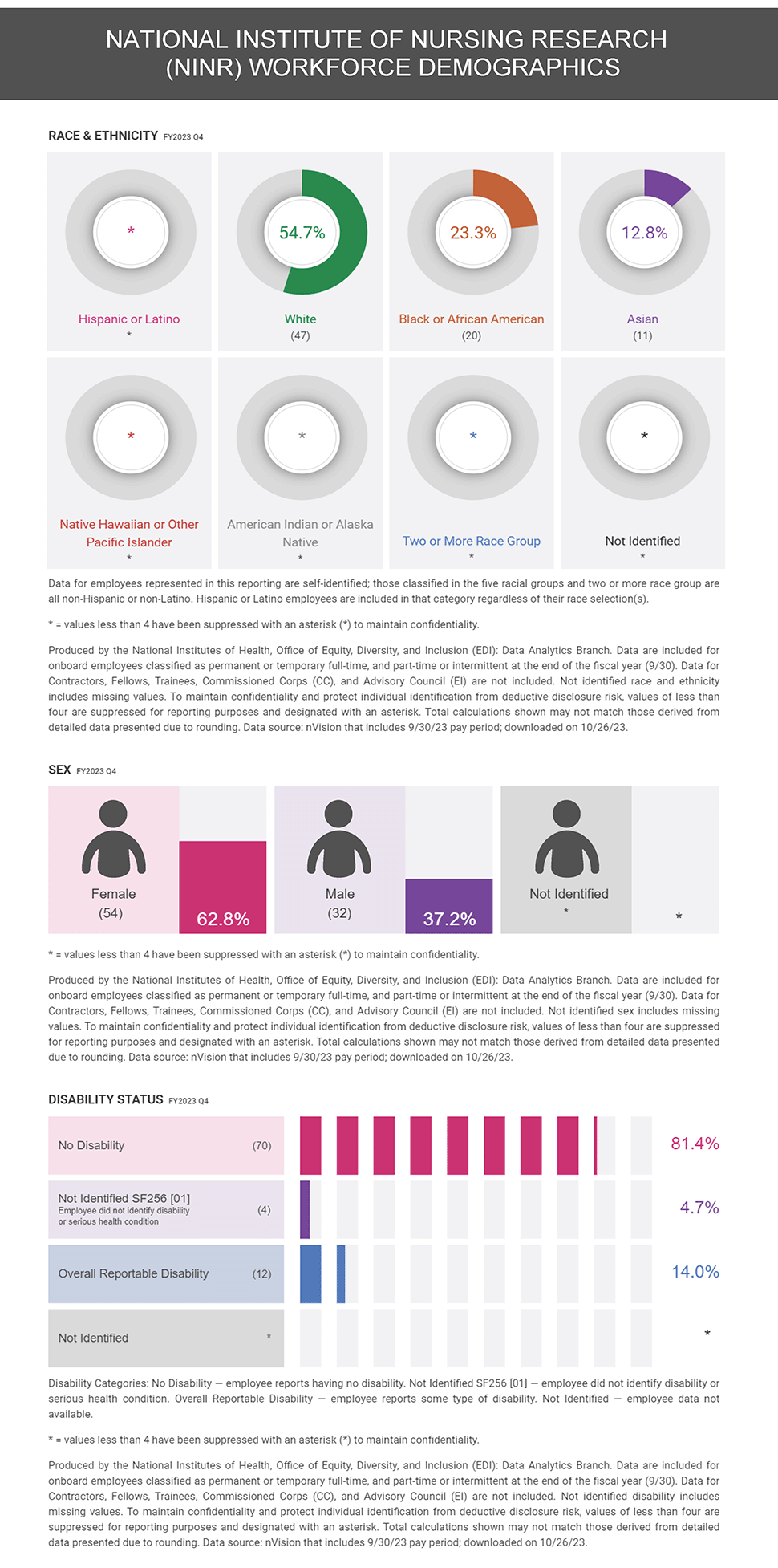
National Institute of Nursing Research Workforce Demographics
RACE & ETHNICITY: Workforce Demographics by Race and Ethnicity. Graphic showing the proportions of Hispanic or Latino, White, Black or African American, Asian, Native Hawaiian or Other Pacific Islander, American Indian or Alaska Native, Two or More Race Group, and Not Identified NIH employees for Fiscal Year 2023 Fourth Quarter.
RACE & ETHNICITY: Hispanic or Latino = *, *%; White = 47, 54.7%; Black or African American = 20, 23.3%; Asian = 11, 12.8%; Native Hawaiian or Other Pacific Islander = *, *%; American Indian or Alaska Native = *, *%; Two or More Race Group = *, *%; Not Identified = *, *%
RACE & ETHNICITY: Data for employees represented in this reporting are self-identified; those classified in the five racial groups and two or more race group are all non-Hispanic or non-Latino. Hispanic or Latino employees are included in that category regardless of their race selection(s).
RACE & ETHNICITY: * = values less than 4 have been suppressed with an asterisk (*) to maintain confidentiality.
RACE & ETHNICITY: Produced by the National Institutes of Health, Office of Equity, Diversity, and Inclusion (EDI): Data Analytics Branch. Data are included for onboard employees classified as permanent or temporary full-time, and part-time or intermittent at the end of the fiscal year (9/30). Data for Contractors, Fellows, Trainees, Commissioned Corps (CC), and Advisory Council (EI) are not included. Not identified race and ethnicity includes missing values. To maintain confidentiality and protect individual identification from deductive disclosure risk, values of less than four are suppressed for reporting purposes and designated with an asterisk. Total calculations shown may not match those derived from detailed data presented due to rounding. Data source: nVision that includes 9/30/23 pay period; downloaded on 10/26/23.
SEX: Workforce Demographics by Sex. Graphic showing the proportions of Female, Male, and Not Identified NIH employees for Fiscal Year 2023 Fourth Quarter.
SEX: FEMALE = 54, 62.8%; MALE = 32, 37.2%; Not Identified = *, *%
SEX: * = values less than 4 have been suppressed with an asterisk (*) to maintain confidentiality.
SEX: Produced by the National Institutes of Health, Office of Equity, Diversity, and Inclusion (EDI): Data Analytics Branch. Data are included for onboard employees classified as permanent or temporary full-time, and part-time or intermittent at the end of the fiscal year (9/30). Data for Contractors, Fellows, Trainees, Commissioned Corps (CC), and Advisory Council (EI) are not included. Not identified sex includes missing values. To maintain confidentiality and protect individual identification from deductive disclosure risk, values of less than four are suppressed for reporting purposes and designated with an asterisk. Total calculations shown may not match those derived from detailed data presented due to rounding. Data source: nVision that includes 9/30/23 pay period; downloaded on 10/26/23.
DISABILITY: Workforce Demographics by Disability Status. Graphic showing the proportions of NIH employees having disability status as the following: No Disability, Not Identified SF256 [01] — Employee did not identify disability or serious health condition, Overall Reportable Disability, and Not Identified NIH employees for Fiscal Year 2023 Fourth Quarter.
DISABILITY: No Disability = 70, 81.4%; Not Identified SF256 [01] — Employee did not identify disability or serious health condition = 4, 4.7%; Overall Reportable Disability = 12, 14.0%; Not Identified = *, *%
DISABILITY: Disability Categories: No Disability — employee reports having no disability. Not Identified SF256 [01] — employee did not identify disability or serious health condition. Overall Reportable Disability — employee reports some type of disability. Not Identified — employee data not available.
Produced by the National Institutes of Health, Office of Equity, Diversity, and Inclusion (EDI): Data Analytics Branch. Data are included for onboard employees classified as permanent or temporary full-time, and part-time or intermittent at the end of the fiscal year (9/30). Data for Contractors, Fellows, Trainees, Commissioned Corps (CC), and Advisory Council (EI) are not included. Not identified disability includes missing values. To maintain confidentiality and protect individual identification from deductive disclosure risk, values of less than four are suppressed for reporting purposes and designated with an asterisk. Total calculations shown may not match those derived from detailed data presented due to rounding. Data source: nVision that includes 9/30/23 pay period; downloaded on 10/26/23.
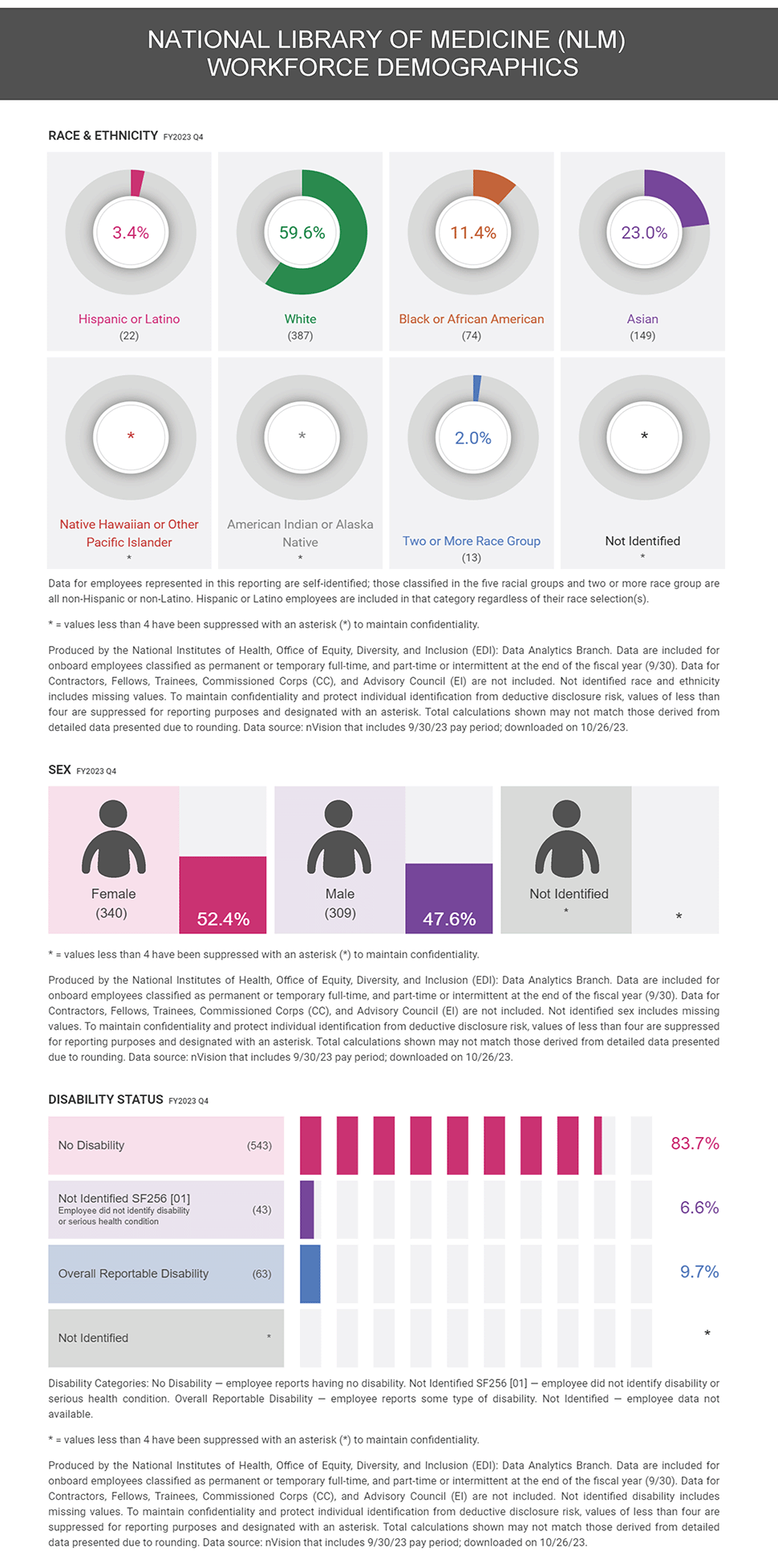
National Libraray of Medicine Workforce Demographics
RACE & ETHNICITY: Workforce Demographics by Race and Ethnicity. Graphic showing the proportions of Hispanic or Latino, White, Black or African American, Asian, Native Hawaiian or Other Pacific Islander, American Indian or Alaska Native, Two or More Race Group, and Not Identified NIH employees for Fiscal Year 2023 Fourth Quarter.
RACE & ETHNICITY: Hispanic or Latino = 22, 3.4%; White = 387, 59.6%; Black or African American = 74, 11.4%; Asian = 149, 23.0%; Native Hawaiian or Other Pacific Islander = *, *%; American Indian or Alaska Native = *, *%; Two or More Race Group = 13, 2.0%; Not Identified = *, *%
RACE & ETHNICITY: Data for employees represented in this reporting are self-identified; those classified in the five racial groups and two or more race group are all non-Hispanic or non-Latino. Hispanic or Latino employees are included in that category regardless of their race selection(s).
RACE & ETHNICITY: * = values less than 4 have been suppressed with an asterisk (*) to maintain confidentiality.
RACE & ETHNICITY: Produced by the National Institutes of Health, Office of Equity, Diversity, and Inclusion (EDI): Data Analytics Branch. Data are included for onboard employees classified as permanent or temporary full-time, and part-time or intermittent at the end of the fiscal year (9/30). Data for Contractors, Fellows, Trainees, Commissioned Corps (CC), and Advisory Council (EI) are not included. Not identified race and ethnicity includes missing values. To maintain confidentiality and protect individual identification from deductive disclosure risk, values of less than four are suppressed for reporting purposes and designated with an asterisk. Total calculations shown may not match those derived from detailed data presented due to rounding. Data source: nVision that includes 9/30/23 pay period; downloaded on 10/26/23.
SEX: Workforce Demographics by Sex. Graphic showing the proportions of Female, Male, and Not Identified NIH employees for Fiscal Year 2023 Fourth Quarter.
SEX: FEMALE = 340, 52.4%; MALE = 309, 47.6%; Not Identified = *, *%
SEX: * = values less than 4 have been suppressed with an asterisk (*) to maintain confidentiality.
SEX: Produced by the National Institutes of Health, Office of Equity, Diversity, and Inclusion (EDI): Data Analytics Branch. Data are included for onboard employees classified as permanent or temporary full-time, and part-time or intermittent at the end of the fiscal year (9/30). Data for Contractors, Fellows, Trainees, Commissioned Corps (CC), and Advisory Council (EI) are not included. Not identified sex includes missing values. To maintain confidentiality and protect individual identification from deductive disclosure risk, values of less than four are suppressed for reporting purposes and designated with an asterisk. Total calculations shown may not match those derived from detailed data presented due to rounding. Data source: nVision that includes 9/30/23 pay period; downloaded on 10/26/23.
DISABILITY: Workforce Demographics by Disability Status. Graphic showing the proportions of NIH employees having disability status as the following: No Disability, Not Identified SF256 [01] — Employee did not identify disability or serious health condition, Overall Reportable Disability, and Not Identified NIH employees for Fiscal Year 2023 Fourth Quarter.
DISABILITY: No Disability = 543, 83.7%; Not Identified SF256 [01] — Employee did not identify disability or serious health condition = 43, 6.6%; Overall Reportable Disability = 63, 9.7%; Not Identified = *, *%
DISABILITY: Disability Categories: No Disability — employee reports having no disability. Not Identified SF256 [01] — employee did not identify disability or serious health condition. Overall Reportable Disability — employee reports some type of disability. Not Identified — employee data not available.
Produced by the National Institutes of Health, Office of Equity, Diversity, and Inclusion (EDI): Data Analytics Branch. Data are included for onboard employees classified as permanent or temporary full-time, and part-time or intermittent at the end of the fiscal year (9/30). Data for Contractors, Fellows, Trainees, Commissioned Corps (CC), and Advisory Council (EI) are not included. Not identified disability includes missing values. To maintain confidentiality and protect individual identification from deductive disclosure risk, values of less than four are suppressed for reporting purposes and designated with an asterisk. Total calculations shown may not match those derived from detailed data presented due to rounding. Data source: nVision that includes 9/30/23 pay period; downloaded on 10/26/23.
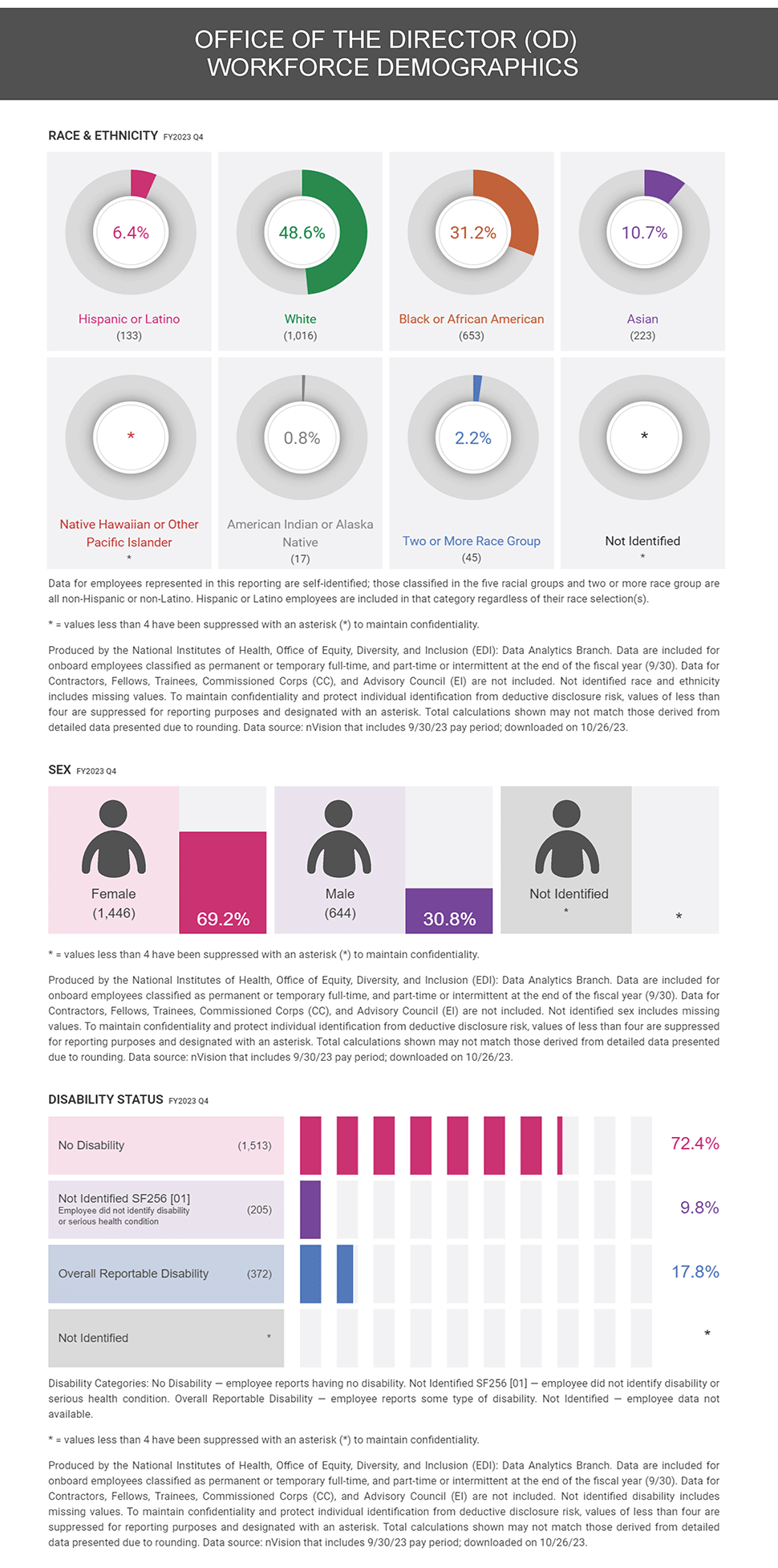
National Institutes of Health Office of the Director Workforce Demographics
RACE & ETHNICITY: Workforce Demographics by Race and Ethnicity. Graphic showing the proportions of Hispanic or Latino, White, Black or African American, Asian, Native Hawaiian or Other Pacific Islander, American Indian or Alaska Native, Two or More Race Group, and Not Identified NIH employees for Fiscal Year 2023 Fourth Quarter.
RACE & ETHNICITY: Hispanic or Latino = 133, 6.4%; White = 1016, 48.6%; Black or African American = 653, 31.2%; Asian = 223, 10.7%; Native Hawaiian or Other Pacific Islander = *, *%; American Indian or Alaska Native = 17, 0.8%; Two or More Race Group = 45, 2.2%; Not Identified = *, *%
RACE & ETHNICITY: Data for employees represented in this reporting are self-identified; those classified in the five racial groups and two or more race group are all non-Hispanic or non-Latino. Hispanic or Latino employees are included in that category regardless of their race selection(s).
RACE & ETHNICITY: * = values less than 4 have been suppressed with an asterisk (*) to maintain confidentiality.
RACE & ETHNICITY: Produced by the National Institutes of Health, Office of Equity, Diversity, and Inclusion (EDI): Data Analytics Branch. Data are included for onboard employees classified as permanent or temporary full-time, and part-time or intermittent at the end of the fiscal year (9/30). Data for Contractors, Fellows, Trainees, Commissioned Corps (CC), and Advisory Council (EI) are not included. Not identified race and ethnicity includes missing values. To maintain confidentiality and protect individual identification from deductive disclosure risk, values of less than four are suppressed for reporting purposes and designated with an asterisk. Total calculations shown may not match those derived from detailed data presented due to rounding. Data source: nVision that includes 9/30/23 pay period; downloaded on 10/26/23.
SEX: Workforce Demographics by Sex. Graphic showing the proportions of Female, Male, and Not Identified NIH employees for Fiscal Year 2023 Fourth Quarter.
SEX: FEMALE = 1446, 69.2%; MALE = 644, 30.8%; Not Identified = *, *%
SEX: * = values less than 4 have been suppressed with an asterisk (*) to maintain confidentiality.
SEX: Produced by the National Institutes of Health, Office of Equity, Diversity, and Inclusion (EDI): Data Analytics Branch. Data are included for onboard employees classified as permanent or temporary full-time, and part-time or intermittent at the end of the fiscal year (9/30). Data for Contractors, Fellows, Trainees, Commissioned Corps (CC), and Advisory Council (EI) are not included. Not identified sex includes missing values. To maintain confidentiality and protect individual identification from deductive disclosure risk, values of less than four are suppressed for reporting purposes and designated with an asterisk. Total calculations shown may not match those derived from detailed data presented due to rounding. Data source: nVision that includes 9/30/23 pay period; downloaded on 10/26/23.
DISABILITY: Workforce Demographics by Disability Status. Graphic showing the proportions of NIH employees having disability status as the following: No Disability, Not Identified SF256 [01] — Employee did not identify disability or serious health condition, Overall Reportable Disability, and Not Identified NIH employees for Fiscal Year 2023 Fourth Quarter.
DISABILITY: No Disability = 1513, 72.4%; Not Identified SF256 [01] — Employee did not identify disability or serious health condition = 205, 9.8%; Overall Reportable Disability = 372, 17.8%; Not Identified = *, *%
DISABILITY: Disability Categories: No Disability — employee reports having no disability. Not Identified SF256 [01] — employee did not identify disability or serious health condition. Overall Reportable Disability — employee reports some type of disability. Not Identified — employee data not available.
Produced by the National Institutes of Health, Office of Equity, Diversity, and Inclusion (EDI): Data Analytics Branch. Data are included for onboard employees classified as permanent or temporary full-time, and part-time or intermittent at the end of the fiscal year (9/30). Data for Contractors, Fellows, Trainees, Commissioned Corps (CC), and Advisory Council (EI) are not included. Not identified disability includes missing values. To maintain confidentiality and protect individual identification from deductive disclosure risk, values of less than four are suppressed for reporting purposes and designated with an asterisk. Total calculations shown may not match those derived from detailed data presented due to rounding. Data source: nVision that includes 9/30/23 pay period; downloaded on 10/26/23.
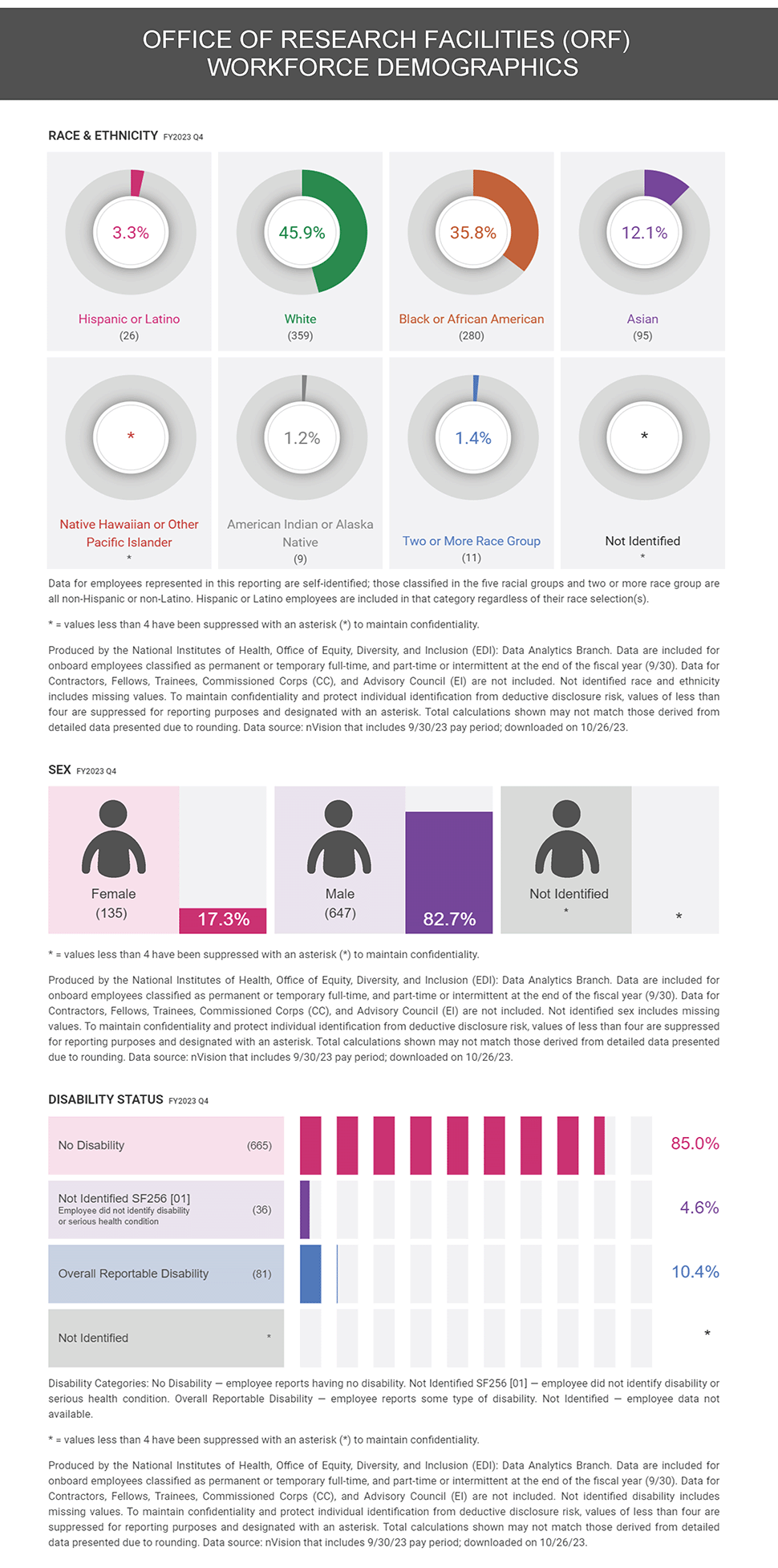
National Institutes of Health Office of Research Facilities Workforce Demographics
RACE & ETHNICITY: Workforce Demographics by Race and Ethnicity. Graphic showing the proportions of Hispanic or Latino, White, Black or African American, Asian, Native Hawaiian or Other Pacific Islander, American Indian or Alaska Native, Two or More Race Group, and Not Identified NIH employees for Fiscal Year 2023 Fourth Quarter.
RACE & ETHNICITY: Hispanic or Latino = 26, 3.3%; White = 359, 45.9%; Black or African American = 280, 35.8%; Asian = 95, 12.1%; Native Hawaiian or Other Pacific Islander = *, *%; American Indian or Alaska Native = 9, 1.2%; Two or More Race Group = 11, 1.4%; Not Identified = *, *%
RACE & ETHNICITY: Data for employees represented in this reporting are self-identified; those classified in the five racial groups and two or more race group are all non-Hispanic or non-Latino. Hispanic or Latino employees are included in that category regardless of their race selection(s).
RACE & ETHNICITY: * = values less than 4 have been suppressed with an asterisk (*) to maintain confidentiality.
RACE & ETHNICITY: Produced by the National Institutes of Health, Office of Equity, Diversity, and Inclusion (EDI): Data Analytics Branch. Data are included for onboard employees classified as permanent or temporary full-time, and part-time or intermittent at the end of the fiscal year (9/30). Data for Contractors, Fellows, Trainees, Commissioned Corps (CC), and Advisory Council (EI) are not included. Not identified race and ethnicity includes missing values. To maintain confidentiality and protect individual identification from deductive disclosure risk, values of less than four are suppressed for reporting purposes and designated with an asterisk. Total calculations shown may not match those derived from detailed data presented due to rounding. Data source: nVision that includes 9/30/23 pay period; downloaded on 10/26/23.
SEX: Workforce Demographics by Sex. Graphic showing the proportions of Female, Male, and Not Identified NIH employees for Fiscal Year 2023 Fourth Quarter.
SEX: FEMALE = 135, 17.3%; MALE = 647, 82.7%; Not Identified = *, *%
SEX: * = values less than 4 have been suppressed with an asterisk (*) to maintain confidentiality.
SEX: Produced by the National Institutes of Health, Office of Equity, Diversity, and Inclusion (EDI): Data Analytics Branch. Data are included for onboard employees classified as permanent or temporary full-time, and part-time or intermittent at the end of the fiscal year (9/30). Data for Contractors, Fellows, Trainees, Commissioned Corps (CC), and Advisory Council (EI) are not included. Not identified sex includes missing values. To maintain confidentiality and protect individual identification from deductive disclosure risk, values of less than four are suppressed for reporting purposes and designated with an asterisk. Total calculations shown may not match those derived from detailed data presented due to rounding. Data source: nVision that includes 9/30/23 pay period; downloaded on 10/26/23.
DISABILITY: Workforce Demographics by Disability Status. Graphic showing the proportions of NIH employees having disability status as the following: No Disability, Not Identified SF256 [01] — Employee did not identify disability or serious health condition, Overall Reportable Disability, and Not Identified NIH employees for Fiscal Year 2023 Fourth Quarter.
DISABILITY: No Disability = 665, 85.0%; Not Identified SF256 [01] — Employee did not identify disability or serious health condition = 36, 4.6%; Overall Reportable Disability = 81, 10.4%; Not Identified = *, *%
DISABILITY: Disability Categories: No Disability — employee reports having no disability. Not Identified SF256 [01] — employee did not identify disability or serious health condition. Overall Reportable Disability — employee reports some type of disability. Not Identified — employee data not available.
Produced by the National Institutes of Health, Office of Equity, Diversity, and Inclusion (EDI): Data Analytics Branch. Data are included for onboard employees classified as permanent or temporary full-time, and part-time or intermittent at the end of the fiscal year (9/30). Data for Contractors, Fellows, Trainees, Commissioned Corps (CC), and Advisory Council (EI) are not included. Not identified disability includes missing values. To maintain confidentiality and protect individual identification from deductive disclosure risk, values of less than four are suppressed for reporting purposes and designated with an asterisk. Total calculations shown may not match those derived from detailed data presented due to rounding. Data source: nVision that includes 9/30/23 pay period; downloaded on 10/26/23.
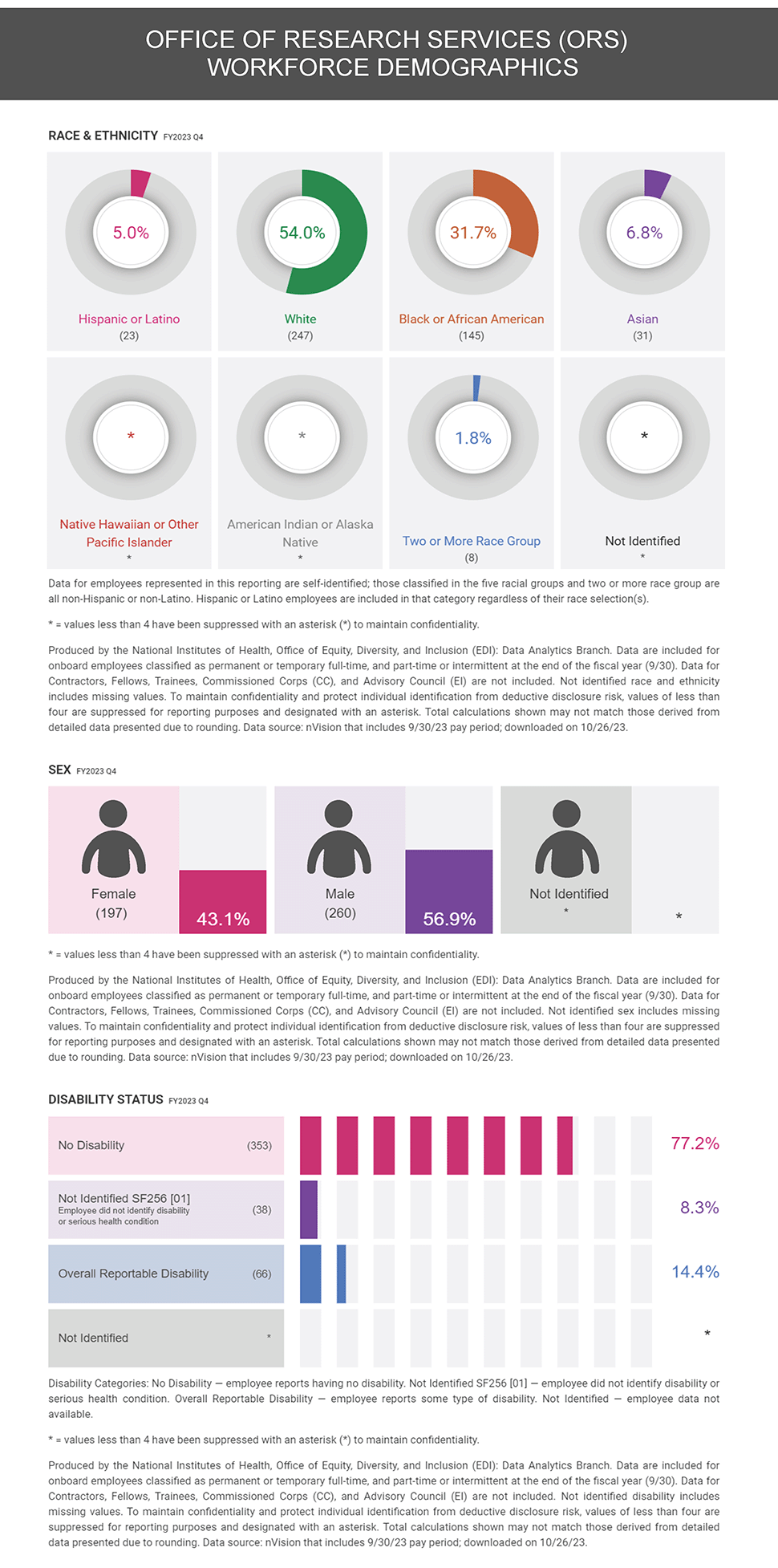
National Institutes of Health Office of Research Services Workforce Demographics
RACE & ETHNICITY: Workforce Demographics by Race and Ethnicity. Graphic showing the proportions of Hispanic or Latino, White, Black or African American, Asian, Native Hawaiian or Other Pacific Islander, American Indian or Alaska Native, Two or More Race Group, and Not Identified NIH employees for Fiscal Year 2023 Fourth Quarter.
RACE & ETHNICITY: Hispanic or Latino = 23, 5.0%; White = 247, 54.0%; Black or African American = 145, 31.7%; Asian = 31, 6.8%; Native Hawaiian or Other Pacific Islander = *, *%; American Indian or Alaska Native = *, *%; Two or More Race Group = 8, 1.8%; Not Identified = *, *%
RACE & ETHNICITY: Data for employees represented in this reporting are self-identified; those classified in the five racial groups and two or more race group are all non-Hispanic or non-Latino. Hispanic or Latino employees are included in that category regardless of their race selection(s).
RACE & ETHNICITY: * = values less than 4 have been suppressed with an asterisk (*) to maintain confidentiality.
RACE & ETHNICITY: Produced by the National Institutes of Health, Office of Equity, Diversity, and Inclusion (EDI): Data Analytics Branch. Data are included for onboard employees classified as permanent or temporary full-time, and part-time or intermittent at the end of the fiscal year (9/30). Data for Contractors, Fellows, Trainees, Commissioned Corps (CC), and Advisory Council (EI) are not included. Not identified race and ethnicity includes missing values. To maintain confidentiality and protect individual identification from deductive disclosure risk, values of less than four are suppressed for reporting purposes and designated with an asterisk. Total calculations shown may not match those derived from detailed data presented due to rounding. Data source: nVision that includes 9/30/23 pay period; downloaded on 10/26/23.
SEX: Workforce Demographics by Sex. Graphic showing the proportions of Female, Male, and Not Identified NIH employees for Fiscal Year 2023 Fourth Quarter.
SEX: FEMALE = 197, 43.1%; MALE = 260, 56.9%; Not Identified = *, *%
SEX: * = values less than 4 have been suppressed with an asterisk (*) to maintain confidentiality.
SEX: Produced by the National Institutes of Health, Office of Equity, Diversity, and Inclusion (EDI): Data Analytics Branch. Data are included for onboard employees classified as permanent or temporary full-time, and part-time or intermittent at the end of the fiscal year (9/30). Data for Contractors, Fellows, Trainees, Commissioned Corps (CC), and Advisory Council (EI) are not included. Not identified sex includes missing values. To maintain confidentiality and protect individual identification from deductive disclosure risk, values of less than four are suppressed for reporting purposes and designated with an asterisk. Total calculations shown may not match those derived from detailed data presented due to rounding. Data source: nVision that includes 9/30/23 pay period; downloaded on 10/26/23.
DISABILITY: Workforce Demographics by Disability Status. Graphic showing the proportions of NIH employees having disability status as the following: No Disability, Not Identified SF256 [01] — Employee did not identify disability or serious health condition, Overall Reportable Disability, and Not Identified NIH employees for Fiscal Year 2023 Fourth Quarter.
DISABILITY: No Disability = 353, 77.2%; Not Identified SF256 [01] — Employee did not identify disability or serious health condition = 38, 8.3%; Overall Reportable Disability = 66, 14.4%; Not Identified = *, *%
DISABILITY: Disability Categories: No Disability — employee reports having no disability. Not Identified SF256 [01] — employee did not identify disability or serious health condition. Overall Reportable Disability — employee reports some type of disability. Not Identified — employee data not available.
Produced by the National Institutes of Health, Office of Equity, Diversity, and Inclusion (EDI): Data Analytics Branch. Data are included for onboard employees classified as permanent or temporary full-time, and part-time or intermittent at the end of the fiscal year (9/30). Data for Contractors, Fellows, Trainees, Commissioned Corps (CC), and Advisory Council (EI) are not included. Not identified disability includes missing values. To maintain confidentiality and protect individual identification from deductive disclosure risk, values of less than four are suppressed for reporting purposes and designated with an asterisk. Total calculations shown may not match those derived from detailed data presented due to rounding. Data source: nVision that includes 9/30/23 pay period; downloaded on 10/26/23.
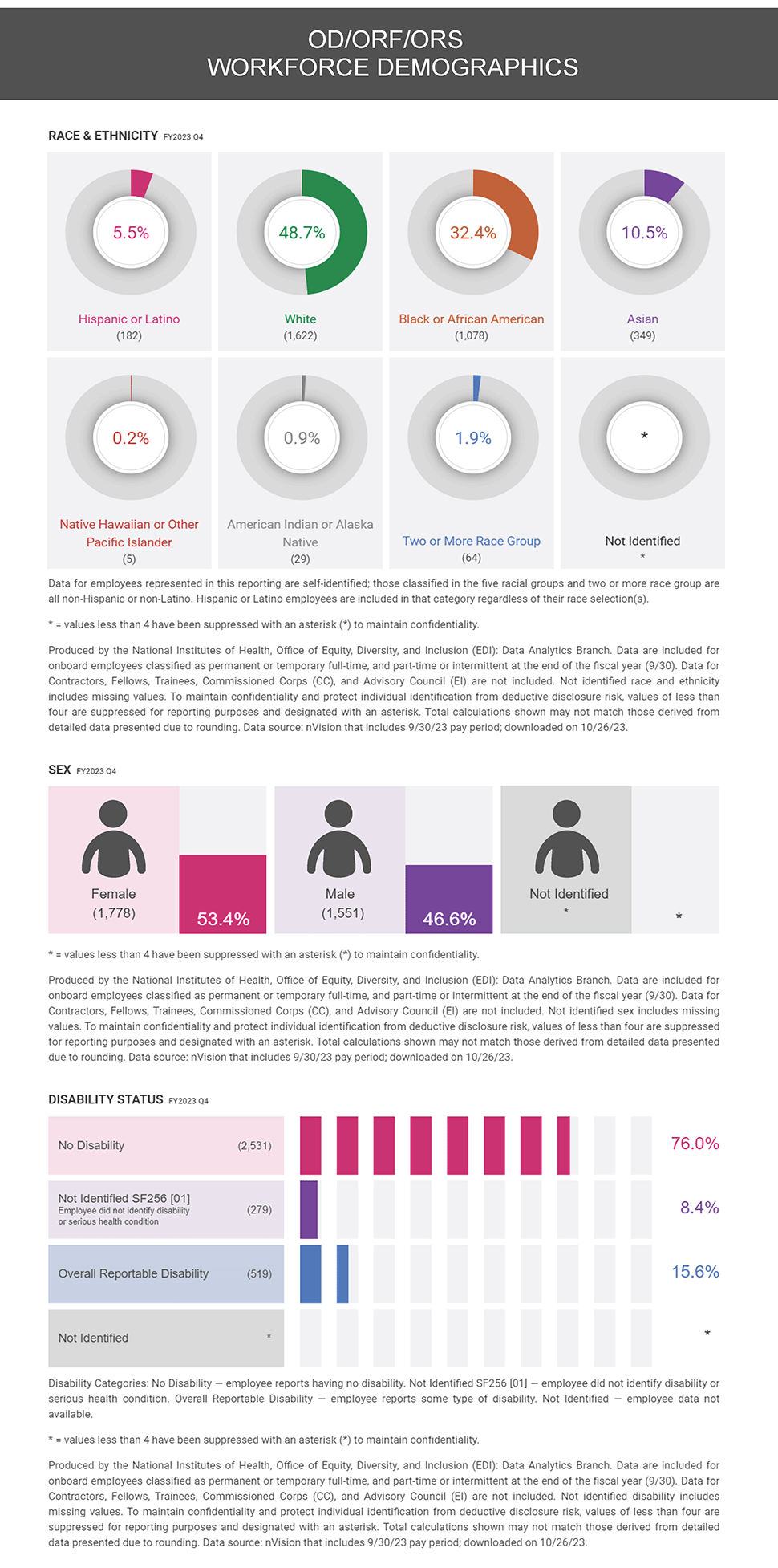
OD/ORF/ORS Workforce Demographics
RACE & ETHNICITY: Workforce Demographics by Race and Ethnicity. Graphic showing the proportions of Hispanic or Latino, White, Black or African American, Asian, Native Hawaiian or Other Pacific Islander, American Indian or Alaska Native, Two or More Race Group, and Not Identified NIH employees for Fiscal Year 2023 Fourth Quarter.
RACE & ETHNICITY: Hispanic or Latino = 182, 5.5%; White = 1622, 48.7%; Black or African American = 1078, 32.4%; Asian = 349, 10.5%; Native Hawaiian or Other Pacific Islander = 5, 0.2%; American Indian or Alaska Native = 29, 0.9%; Two or More Race Group = 64, 1.9%; Not Identified = *, *%
RACE & ETHNICITY: Data for employees represented in this reporting are self-identified; those classified in the five racial groups and two or more race group are all non-Hispanic or non-Latino. Hispanic or Latino employees are included in that category regardless of their race selection(s).
RACE & ETHNICITY: * = values less than 4 have been suppressed with an asterisk (*) to maintain confidentiality.
RACE & ETHNICITY: Produced by the National Institutes of Health, Office of Equity, Diversity, and Inclusion (EDI): Data Analytics Branch. Data are included for onboard employees classified as permanent or temporary full-time, and part-time or intermittent at the end of the fiscal year (9/30). Data for Contractors, Fellows, Trainees, Commissioned Corps (CC), and Advisory Council (EI) are not included. Not identified race and ethnicity includes missing values. To maintain confidentiality and protect individual identification from deductive disclosure risk, values of less than four are suppressed for reporting purposes and designated with an asterisk. Total calculations shown may not match those derived from detailed data presented due to rounding. Data source: nVision that includes 9/30/23 pay period; downloaded on 10/26/23.
SEX: Workforce Demographics by Sex. Graphic showing the proportions of Female, Male, and Not Identified NIH employees for Fiscal Year 2023 Fourth Quarter.
SEX: FEMALE = 1778, 53.4%; MALE = 1551, 46.6%; Not Identified = *, *%
SEX: * = values less than 4 have been suppressed with an asterisk (*) to maintain confidentiality.
SEX: Produced by the National Institutes of Health, Office of Equity, Diversity, and Inclusion (EDI): Data Analytics Branch. Data are included for onboard employees classified as permanent or temporary full-time, and part-time or intermittent at the end of the fiscal year (9/30). Data for Contractors, Fellows, Trainees, Commissioned Corps (CC), and Advisory Council (EI) are not included. Not identified sex includes missing values. To maintain confidentiality and protect individual identification from deductive disclosure risk, values of less than four are suppressed for reporting purposes and designated with an asterisk. Total calculations shown may not match those derived from detailed data presented due to rounding. Data source: nVision that includes 9/30/23 pay period; downloaded on 10/26/23.
DISABILITY: Workforce Demographics by Disability Status. Graphic showing the proportions of NIH employees having disability status as the following: No Disability, Not Identified SF256 [01] — Employee did not identify disability or serious health condition, Overall Reportable Disability, and Not Identified NIH employees for Fiscal Year 2023 Fourth Quarter.
DISABILITY: No Disability = 2531, 76.0%; Not Identified SF256 [01] — Employee did not identify disability or serious health condition = 279, 8.4%; Overall Reportable Disability = 519, 15.6%; Not Identified = *, *%
DISABILITY: Disability Categories: No Disability — employee reports having no disability. Not Identified SF256 [01] — employee did not identify disability or serious health condition. Overall Reportable Disability — employee reports some type of disability. Not Identified — employee data not available.
Produced by the National Institutes of Health, Office of Equity, Diversity, and Inclusion (EDI): Data Analytics Branch. Data are included for onboard employees classified as permanent or temporary full-time, and part-time or intermittent at the end of the fiscal year (9/30). Data for Contractors, Fellows, Trainees, Commissioned Corps (CC), and Advisory Council (EI) are not included. Not identified disability includes missing values. To maintain confidentiality and protect individual identification from deductive disclosure risk, values of less than four are suppressed for reporting purposes and designated with an asterisk. Total calculations shown may not match those derived from detailed data presented due to rounding. Data source: nVision that includes 9/30/23 pay period; downloaded on 10/26/23.





